Paul van Yperen's Blog, page 169
February 20, 2021
Before Hollywood: Lubin
Lubin or the Lubin Manufacturing Company was a pioneering American film production company that produced silent films from 1896 to 1916. Siegmund Lubin (1851-1923) started his empire with the purchase of one film projector in 1895. Before long, the Lubin empire included a chain of cinemas, multiple state-of-the-art production studios across the United States, hundreds of employees, numerous patents for recording and projecting equipment, and international film distribution Lubin's Liberty Bell logo and motto, "Clear As A Bell", referred to the superior quality of his film images.
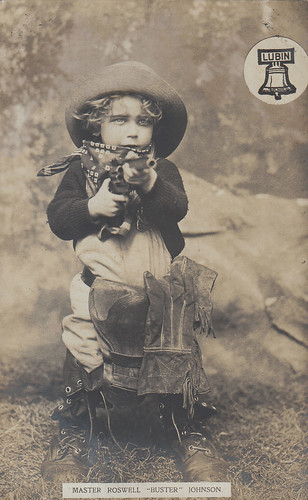
British postcard, no. 78. Photo: Lubin. Collection: Marlene Pilaete.
Cute Buster Johnson (1908-1969) was the most famous child star of the Lubin company. Only 3 1/2 years old, he was extremely popular in 1912. Buster Johnson was born in 1908 in Brooklyn, New York as Hoyt Roswell Johnson. His parents were Roswell Joshua Johnson, a film cameraman for Lubin, and Florence S. Johnson. He had a sister who was named Ormi Hawley Johnson. His godmothers were the film stars Ormetta Hawley and Mary Pickford. The adorable little boy made his debut in the silent short The Kiddies' Christmas (N.N., 1911) at the Lubin Manufacturing Company. He was presented in the media as 'Lubin's Child Wonder', who played "both boys and girls with intelligence". The short comedy Buster's Dream (Charles H. France, 1912) led to the Buster series with such films as Buster and the Cannibal's Child (Charles H. France, 1912), and Buster and the Gypsies (Charles H. France, 1912). His co-stars were the child actors Henrietta O'Beck en Brooks McCloskey. The following year, Buster appeared in his last film, ironically called His First Experience (Arthur Hotaling, 1913) in which he played the son of Mae Hotely. In 1914, the Lubin Company had a fire that resulted in financial problems. It’s possible that because of this, they couldn’t afford all the actors they had on the roster, and perhaps they had to drop him. In all, Buster was in 14 films. Census records show that in 1930, he was living with family and was a bookkeeper at a bank. In 1934 he was married to Vivien Isabel Mehrhof in Ridgefield, New Jersey. Buster Johnson died in 1969 in the USA. He was 61.
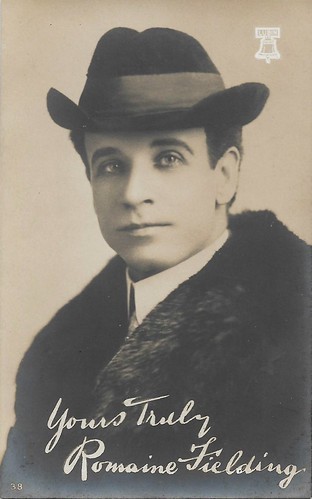
English postcard, no. 38. Photo: Lubin.
Romaine Fielding (1867-1927) was an American actor, screenwriter, and silent film director known for his dramatic Westerns. Fielding worked for the Solax Film Company of New York before joining Lubin in November 1911 at the age of 44. Despite his age, he could easily portray much younger characters. In June 1912 Siegmund Lubin placed Fielding in charge of the Lubin Southwest Company as director, despite the fact that until then he had only acted. It was the start of a rapid rise to fame. Fielding would write and direct films as well as star in them. He broke with convention, challenging stereotypical casting of Indians and Mexicans as villains, such as Who is the Savage? (1913), starring Mary Ryan, Fielding's regular co-star in these years. His films often ended unexpectedly on a downbeat note. His work was praised in the trade press for its visual beauty combined with realism. His five-reel thriller The Golden God (1914) employed about 5,000 local extras and featured a cavalry and artillery charge. At one time he filmed a train smash at great expense. Lubin used the costly footage in five different films. Fielding made a number of Mexican-themed Western-style films and adventure films on location in California, Arizona, and New Mexico, but little of his work has survived. In July 1913, Motion Picture Story magazine announced that Fielding had come top of their readers poll with 1,311,018 votes.
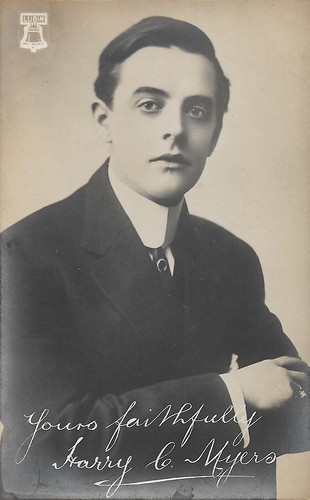
English postcard. Photo: Lubin.
American film actor and director Harry C. Myers (1882-1938) was married to the actress Rosemary Theby. Myers had been a theatre actor for 10 years before he went to work for Lubin in 1909. A still existing example of Myers' career at Lubin is the drama When the Earth Trembled (Barry O'Neill, 1913), possibly the first fiction film to depict the 1906 San Francisco earthquake.
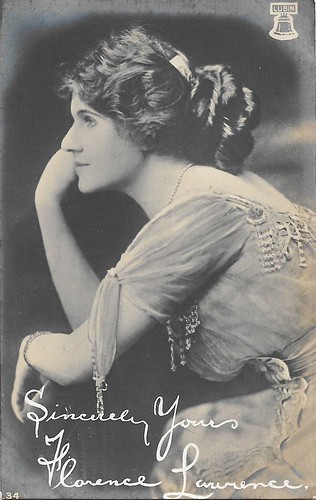
English postcard, no. 34. Photo: Lubin.
Canadian-born actress Florence Lawrence (1886-1938) began her career in the motion picture industry with a role in an Edison Company short, Daniel Boone/Pioneer Days in America (1907). Next, she worked for the Vitagraph Company. At the American Mutoscope and Biograph Company, Lawrence appeared in most of the sixty short films that D.W. Griffith directed in 1908. She became famous, known as “the Biograph girl.” In 1910, producer Carl Laemmle of the Independent Motion Picture Company (IMP) hired her. Lawrence was the object of a notorious publicity stunt. Her “death” in a streetcar accident was widely announced, followed by her resurrection in the first publicity tour in film history. Lawrence and her husband Harry Solter worked at IMP for eleven months and made approximately fifty films. Lawrence and Solter then joined Lubin in early 1911, but they left Lubin within a year, and, with Solter, started one of the first US film companies to be headed by a woman: the Victor Company.
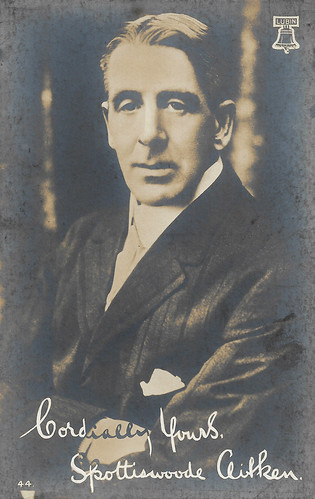
English postcard, no. 44. Photo: Lubin.
Frank Spottiswoode Aitken (1868-1933) was a Scottish-American actor of the silent era. His film debut came at Lubin in the short comedy A Change of Heart (N.N., 1910) with Edna Luby. The following year, he appeared for Lubin in several shorts including Her Humble Ministry (Harry Solter, 1911) with Arthur V. Johnston and Florence Lawrence. Later, he played Dr. Cameron in D. W. Griffith's epic drama The Birth of a Nation (1915).
A running legal battle with Thomas Edison
Siegmund Lubin was born in Germany in 1851. He was educated at Heidelberg University and, following in the footsteps of his father, earned his degree in ophthalmology. Lubin traveled to the United States, first in 1868, and then immigrated permanently in 1876. He lived in New Haven, Connecticut, where he met his wife, Annie Abrams.
After they married, they traveled the United States together attending fairs and exhibitions where Lubin conducted eye examinations and sold eyeglasses. In 1882, after the birth of their daughter Edith, the family moved to Philadelphia where Lubin opened an optical shop at 237 North Eighth Street. His family occupied the second-floor apartment.
Lubin continued to travel around the country to attend exhibitions, and it was during a trip to New Orleans that he was first introduced to and became interested in the burgeoning field of Motion picture recording. "Pop" Lubin saw the potential in selling similar equipment as well as in making films. By 1896, Lubin had established his motion picture business, "Life Motion Pictures," using profits from his optical shop and the investments of family and friends.
He soon developed his own projector, the "Cineograph," that he manufactured, marketed, and sold to the general public, along with other varieties of projectors and films. His lower price and marketing know-how brought reasonable success. In 1897 Lubin began making films for commercial release. He staged and filmed re-enactments of famous boxing matches, battles of the Spanish-American War, and news stories.
Initially, Lubin filmed in parks and in his own backyard. Certain his business could prosper, the following year he rented low-cost space on the roof of a building in Philadelphia's business district where he built a more formal film studio. He exhibited his new equipment at the 1899 National Export Exposition in Philadelphia and the 1901 Pan-American Exposition in Buffalo, New York. In 1902, Lubin formed the Lubin Manufacturing Company and incorporated it in 1909 in Philadelphia, Pennsylvania. A notable film was Meet Me at the Fountain in 1904.
For years the Lubin Manufacturing Company, like most of the other major film studios, had a running legal battle with Thomas Edison that saw repeated lawsuits brought against Lubin for patent infringement. In 1908, Lubin gave up the costly fight with Edison and became part of the Motion Picture Patents Company, a monopoly on production and distribution set up by Edison.
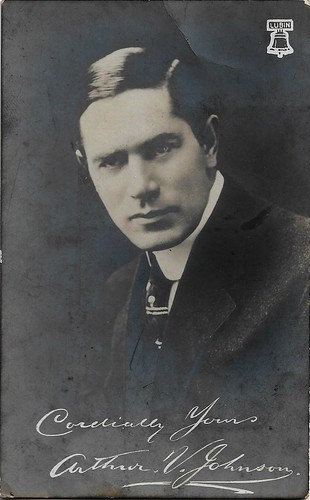
English postcard. Photo: Lubin.
Arthur V. Johnson (1876-1916) was a highly prolific American actor and director, known for his work at the pre-Hollywood companies of Edison, American Biograph, and Lubin. In 1911 Johnson accepted an offer from Lubin that allowed him to direct as well as act. With Lottie Briscoe, his frequent co-star at Lubin, Johnson directed and starred in The Beloved Adventurer (1914), a 15 episode serial by Emmett Campbell Hall. His high productivity took its toll: in 1915 he had a nervous breakdown due to overwork, he stopped his career, and died of TBC, almost forty.
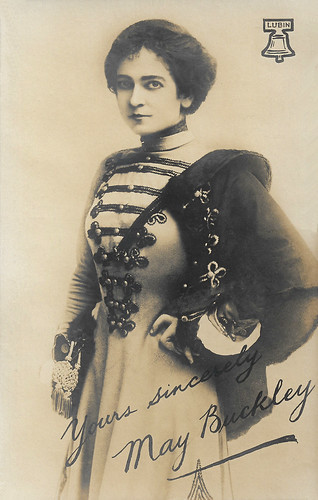
English postcard. Photo: Lubin.
American stage actress May Buckley (1875-?) became a popular film heroine with the role of 'Marguerite Moreland' in the Lubin production Paid in His Own Coin (1912). The following year she moved on to Selig, but later that year, she left the film business. Her private life was often in newspaper headlines, especially in 1901, when a man who claimed to be her husband shot at her in a hotel dining room, wounding one of her dining companions.
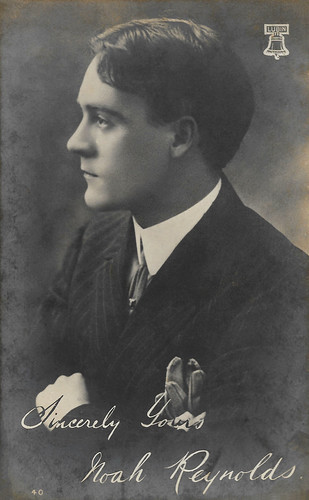
English postcard, no. 40. Photo: Lubin.
American actor Noah Reynolds (?-1948) appeared in a dozen Lubin shorts between 1910 and 1912. He was known for such Lubin shorts as the Western Percy the Cowboy (1910) in which he played the title role, Making a Man of Him (1910) with Harry Myers, and Archibald the Hero (1911), again as the title figure. He died in 1948 in North Philadelphia, Pennsylvania, USA.
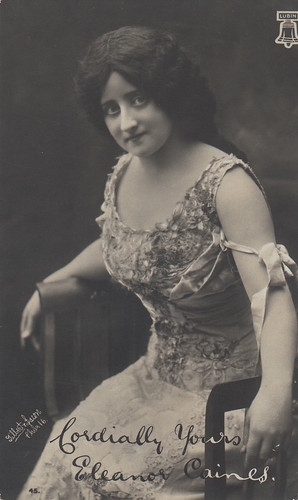
British postcard, no. 45. Photo: Gilbert & Bacon, Philadelphia / Lubin. Collection: Marlene Pilaete.
Eleanor Caines (1870 or 1880-1913) was an American silent film actress. She spent most of her film career at the Lubin Film Company. According to IMDb, Eleanor Caines was born in 1870 in Philadelphia, Pennsylvania, USA. In 1909, she began her film career at Lubin in the short comedy Blissville the Beautiful (1909) with George Reehm and Harry Myers. In the following years, she appeared in some 30 Lubin productions. Eleanor Caines died in 1913 in her hometown Philadelphia at the age of 43. The cause of her death was surgery after an accident. She was married to William Robson with whom she had a child, and till her death to Jack Le Faint.
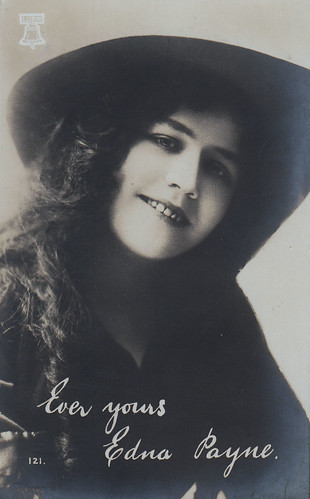
British postcard, no. 121. Photo: Lubin. Collection: Marlene Pilaete.
American silent screen motion picture actress Edna Payne (1891-1953) is regarded as a 'pioneer' in the film industry because she was in many short films from 1911 through 1917.
Edna Payne was born in 1891 in New York City. Petite, blue-eyed, and brown-haired, Edna was born "in the trunk". Her parents were both stage actors, so Payne began her career as a child in Vaudeville. She made her film debut in Higgenses Versus Judsons (1911). She played the lead in reel dramas, and later in a few reel Westerns including The Girl Stage Driver (1914). Although her film career was confined to the 1910s, she took part in countless productions. In 1917 she finished her acting career when she married actor Jack Rollens. They had two children, Edna J (1919), and Jack A (1921), but the couple divorced in 1925. Edna Payne died of a liver ailment in 1953, aged 61, in Los Angeles, California.
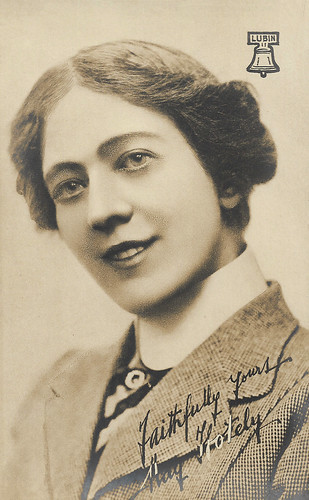
English postcard. Photo: Lubin.
Mae Hotely (1872-1954) was a brunette early silent screen comedienne, who starred in films for Lubin, produced by her husband Arthur Hotaling out of Jacksonville, Florida. She appeared in 85 films between 1911 and 1929.
A state of the art studio named Lubinville
The insatiable appetite of the American public for films saw Lubin's company undergo enormous growth. Aided by French-born writer and poet Hugh Antoine D'Arcy, who served as the studio's publicity manager, in 1910 Siegmund Lubin built a state of the art studio on the corner of Indiana Avenue and Twentieth Street in Philadelphia that became known as "Lubinville." The studio included an open tank under the floor that could be flooded to stage scenes involving large volumes of water as well as a cutting edge lighting system for use on cloudy days. There were also costume rooms, property storage rooms for set building, an editing room, a laboratory, and a cafeteria.
The facility allowed several film productions to be undertaken simultaneously. Lubin began to invest in the quality of his films and actors, for the first time. He recruited famous actresses and actors, such as Florence Lawrence, Ormi Hawley, and John Halliday, who brought greater acclaim to his productions.
The Lubin Manufacturing Company expanded production beyond Philadelphia, with facilities at 750 Riverside Avenue in Jacksonville, Florida, Los Angeles, and then in Coronado, California. In 1912, Lubin purchased a 350-acre (1.4 km2) estate in Betzwood, in what was then rural countryside in the northwest outskirts of Philadelphia, and converted the property into a studio and film lot.
That same year, director and actor Romaine Fielding travelled out to Prescott, Arizona with cast and crew and set up offices at 712 Western Avenue and an outdoor stage for shooting interiors behind Mercy Hospital (now the site of Prescott College). He filmed approximately a dozen films there before moving to Tucson, Arizona, where he directed another 60 or so silent short films. William Duncan and Selig Polyscope Company took over the Prescott facility.
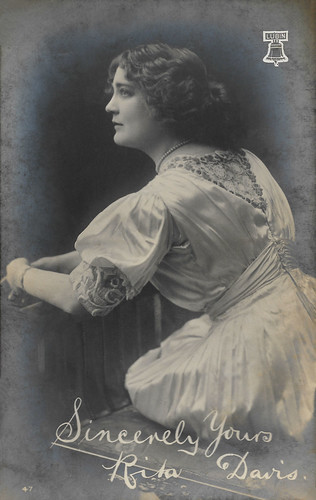
English postcard, no. 47. Photo: Lubin.
American actress Rita Davis is known for such early silent Lubin films as Three Hearts (N.N., 1910), Faith Lost and Won (1910), and The Widow's Choice (1911).
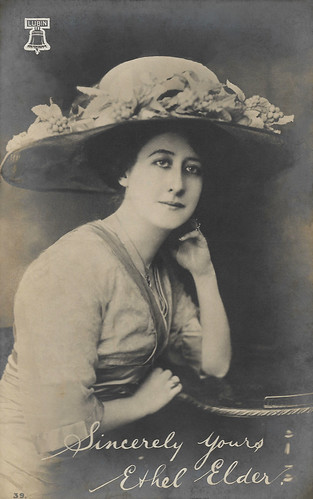
English postcard, no. 39. Photo: Lubin.
Ethel Elder was an American silent film actress who worked for the Lubin company. 'Miss Elder' is known for such short films as The Mystery (1912), The Path of Genius (1912), and Billy's Surrender (1912).
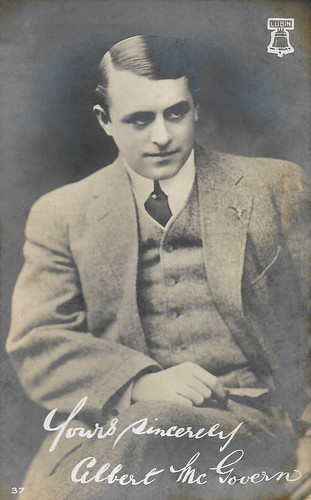
English postcard, no. 37. Photo: Lubin.
Albert McGovern (1882-?) was an American actor and director who worked for the Lubin company. Between 1910 and 1914 he played in more than 30 short silent films.
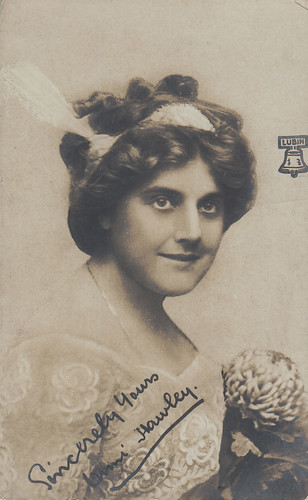
British postcard, no. 72. Photo: Lubin. Collection: Marlene Pilaete.
American actress Ormi Hawley (1889-1942) was a silent film actress who worked for the Lubin Manufacturing Company and later for Fox, Mutual, and Paramount. Dubbed "The Lillian Russell of the Pictures", she usually played gracious society roles or aristocrats. Between 1911 and 1919, she appeared in more than 300 pictures. Ormetta Grace Hawley was born in 1889 in Holyoke, Massachusetts. She attended the New England Conservatory of Music. In her teens, she began her acting career in live theatre with a stock theater company in Boston. In 1911, she turned to the new silent film industry with Lubin Studios in Philadelphia, Pennsylvania. There she appeared in the Jules Verne adaptation Michael Strogoff (Lloyd B. Carleton, 1914), featuring Jacob P. Adler, and The Shanghaied Baby (George Terwilliger, 1915). After being retrenched by Lubin in 1916, she worked for Mutual, Fox, Paramount, and other companies. She played in such dramas as Where Love Leads (Frank Griffin, 1916) with Rockliffe Fellowes, Runaway Romany (George W. Lederer, 1917) starring Marion Davies, and Mrs. Dane's Defense (Hugh Ford, 1918) starring Pauline Frederick. During her short film career, Ormi Hawley reportedly appeared in more than three hundred motion pictures. A large number were short films. In 1919, she made her last films such as The Unwritten Code (Bernard J. Durning, 1919) starring Shirley Mason and Matt Moore, and The Splendid Romance (Edward José, 1919) starring Enrico Caruso. One of her later jobs was managing the All American Girl's Symphony Orchestra. From 1928 till her death, Hawley was married to Charles Fulcher. For the last 15 years of her life, Hawley and her husband operated a farm near Camden, New York. She also painted portraits and wrote stories for children. Ormi Hawley died in a hospital in Rome, New York, in 1942. Her obituary in the New York Times claimed she was in 370 films.
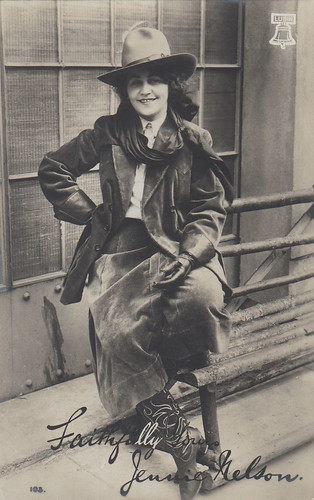
British postcard, no. 103. Photo: Lubin. Collection: Marlene Pilaete.
Silent film actress Jennie Nelson was born in Copenhagen, Denmark. In 1910, she made her film debut at the Lubin Manufacturing Company in the short comedy Spoony Sam (1910) featuring George Reehm. The actress became known at Lubin with such short silent films as the war drama The Battle of Shiloh (Joseph W. Smiley, 1913) and the comedy Jane's Waterloo (Joseph W. Smiley, 1913). For Universal, she later appeared in the comedy Lucile the Waitress (William Bailey, 1916). Her final film was for the Victor film company, the comedy Signs of Trouble (William Bailey. 1917). Between 1910 and 1917, she appeared in 32 films.
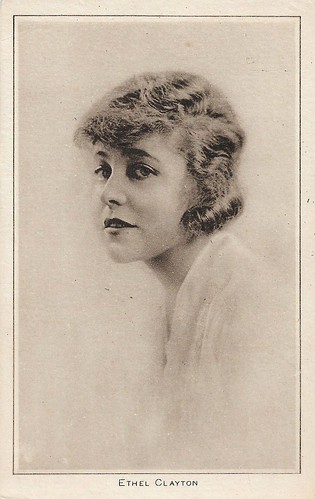
British postcard in the "Pictures" Portrait Gallery, London.
Ethel Clayton (1882-1966) was an American stage and screen actress and singer. In 1909 she started film acting with the company Essanay. After five films she left Essanay and the film sets, but in 1912 she was lured back, but now to the company Lubin, first acting in For the Love of a Girl (1912), opposite Harry Myers, with whom she would often act together. Clayton got first billing or was at least the female lead in many films. After 27 more shorts at Lubin, she acted in her first feature there, When the Earth Trembled (Barry O'Neil, 1913), a family and business drama against the background of the 1906 San Francisco earthquake. More shorts but also features followed, such as The Lion and the Mouse (Barry O'Neill, 1914) and The Fortune Hunter (Barry O'Neill, 1914). Clayton stayed with Lubin until 1916, when she first shifted to World Film, followed by Paramount and other companies.
A heavy billed as Babe Hardy
Some of the pioneer actors who worked for Lubin included Romaine Fielding, Ed Genung, Harry Myers, Florence Hackett, Alan Hale, Arthur V. Johnson, Lottie Briscoe, Florence Lawrence, Ethel Clayton, Gladys Brockwell, Edwin Carewe, Ormi Hawley, Rosemary Theby, Betty Brice, Alice Mann, and Pearl White.
Lubin films also marked the first film appearance of Oliver Hardy , who started working at Lubin's Jacksonville, Florida studio in 1913. Hardy's first onscreen appearance was in Outwitting Dad (1914) where he was billed as O. N. Hardy. In many of his later films at Lubin, he was billed as “Babe Hardy”. He was most often cast as “the heavy” or the villain and had roles in comedy shorts, appearing in some 50 short one-reeler films at Lubin by 1915.
However, the company's downfall came even faster than its meteoric rise. Despite Lubin's efforts, by early 1912, the Lubin Manufacturing Company began to fall behind the more progressive members of the Motion Picture Patents Company and other independent producers of films in terms of overall quality and film length. Lubin was not as adroit as its competitors in shifting to quality feature-length films.
Also, a disastrous fire at its main studio in June 1914, damaged nearby buildings and destroyed the negatives for a number of unreleased new films, which severely hurt the business. When World War I broke out in Europe in September of that year, Lubin and other American filmmakers', lost a large source of income from these foreign sales. In 1915, Lubin was forced to begin consolidating his business and he closed the studios one-by-one.
Despite efforts of one employee to move the company to California, the eastern branch of the Lubin Manufacturing Company would remain the dominant base of operations. The Lubin company entered into an agreement to form a film distribution partnership, with Vitagraph Studios, Selig Polyscope Company, and Essanay Studios, known as V-L-S-E, Incorporated. Lubin also tried to re-release popular films as well as to sign more famous actors, such as Charlie Chaplin .
However, none of these efforts changed the company's fate. The United States Supreme Court rulings against the monopoly of the Motion Picture Patents Company spelled the end of Lubin's business. After making more than a thousand films the corporation was forced into bankruptcy and on 1 September 1916, the Lubin Manufacturing Company closed its doors for good. Siegfried Lubin went back to his work as an optician and died in 1923.
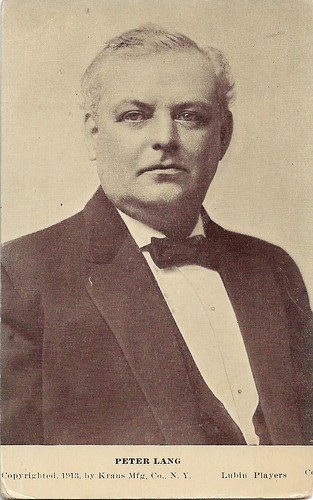
American postcard by Kraus Manufacturing Company, New York, 1913. Photo: Lubin.
Peter Lang (1859-1932) was an American actor. After some 25 shorts at Lubin, Lang's first feature at Lubin was When the Earth Trembled (Barry O'Neil, 1913). After that film, Lang shifted to Famous Players, playing in feature-length dramas like An American Citizen (1914), starring John Barrymore. But in 1914 Lang was back at Lubin for features there such as Michael Strogoff (Lloyd B. Carleton, 1914), and the Western The Valley of Lost Hope (Romaine Fielding, 1916).
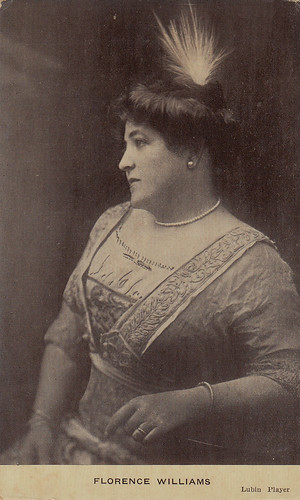
American postcard published by Kraus Mfg. Co., N.Y. Photo: Lubin. Collection: Marlene Pilaete.
Florence Williams was a matron-like American silent film actress. She started her film career at the Lubin Manufacturing Company in the short comedy Getting Married (Arthur Hotaling, 1913) with Robert Fischer and Jennie Nelson. According to IMDb, she was known for the short drama The Wolf (Barry O'Neil, 1914), The College Widow (Barry O'Neil, 1915) with Ethel Clayton, and The Sporting Duchess (Barry O'Neil, 1915). She ended her film career with Otto the Sleuth (Edwin McKim, 1916), an episode of the Otto comedies with Davy Don as Otto.
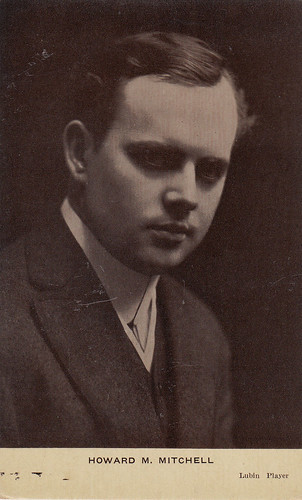
American postcard published by Kraus Mfg. Co., N.Y. Photo: Lubin. Collection: Marlene Pilaete.
Howard M. Mitchell (1883-1958) was an American actor and film director. He appeared in 270 films between 1910 and 1952 and directed 38 silent films between 1915 and 1927. Howard M. Mitchell was born in 1883 in Pittsburgh, Pennsylvania. In 1909, he started his film career as an actor in the Lubin Manufacturing Company's Martyr or Crank? (N.N., 1909) with Harry Myers. For Lubin followed several short films such as The Irish Boy (1910), The Miner's Sweetheart (1910), and A Change of Heart (1910) with Spottiswoode Aitken. In 1911 he married actress Mary Land. Till 1916, he appeared in many short films for Lubin and Thanhouser. He then focused on directing and made such films as The Mother Heart (1921), Lovetime (1921), and Romance Ranch (1924). In 1927, Howard M. Mitchell returned to the screen in A Bowery Cinderella (Burton L. King, 1927). During the following decades, he worked as a bit player in countless films. He could be glimpsed in films like They Won't Forget (Mervyn LeRoy, 1937) with Claude Rains, The Great Waltz (Julien Duvivier, 1938) with Luise Rainer, and Queen of the Mob (James P. Hogan, 1940) with Ralph Bellamy. His final film appearance was in Carrie (William Wyler, 1952) starring Laurence Olivier and Jennifer Jones. Howard M. Mitchell died in 1958 in Hollywood, California.
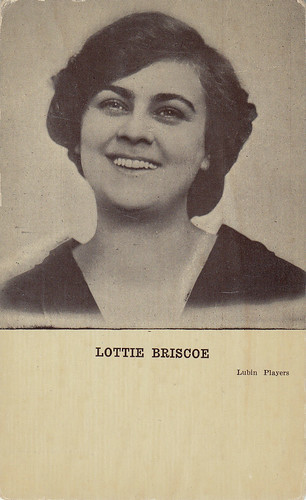
American postcard published by Kraus Mfg. Co., N.Y. Photo: Lubin. Collection: Marlene Pilaete.
Lottie Briscoe (1883-1950) was a raven-haired American stage and silent screen actress. After starting her film career with Essanay in Chicago, Lottie worked for the Lubin Company from 1912 to 1915. There she formed a popular couple with matinée idol Arthur V. Johnson. Briscoe appeared in over 94 motion pictures. Lottie Briscoe was born in 1883 in St. Louis, Missouri. Her parents were Mr. and Mrs. T. D. Briscoe. Her father may have been involved in theatre work and her mother was known to the theatre community as a likable stage mother. A sister, Olive Helen Briscoe, had long a career in vaudeville as a singer and comedian. Lottie was a child performer from the age of four. She then graduated to ingénue roles at the Orpheum Theater in Philadelphia. Around 1909 Briscoe, along with Harry McRae Webster, joined the fledgling Essanay Studios in Chicago. At least two films during this period, both one-reelers from January 1911, are known to exist today; The Sophomore’s Romance and A Sin Unpardonable. From 1912 to 1915, Lottie worked for the Lubin Company, where she was popularly paired with matinée idol Arthur V. Johnson. Their films include The Country School Teacher (N.N., 1912) and The Power of the Cross (Arthur V. Johnson, 1913). Their most ambitious project together during this period was probably The Belovéd Adventurer (1914), a 15-episode serial written by Emmett Campbell Hall. In January 1916, Arthur V. Johnson died shortly after the release of their latest film, the Maie B. Hovey story The Lost Rose (1919). Lottie Briscoe left the film business. In 1918, she only briefly returned to play Gertie Farish in her final film, The House of Mirth (Albert Capellani, 1918). On the stage, she played the title role in a domestic comedy by George Kelly entitled 'Mrs. Wellington's Surprise'. In 1922 Briscoe signed to appear in a leading role with William Faversham in 'The Squaw Man'. She continued to appear in Vaudeville before being confined at home due to a debilitating illness. Lottie Briscoe died in 1950 in New York City, at the age of 66. She was married to Harry McRae Webster (1903-1911) and Harry Mountford (1921-). Harry McRae Webster was a motion picture director of some note before he was sued in the early 1920s by a film studio over the unauthorised use of nude models in one of his movies. Mountford was formerly an executive secretary of the White Rats Actors Union which was disbanded in 1930.
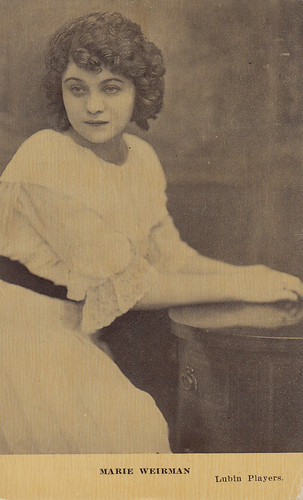
American postcard published by Kraus Mfg. Co., N.Y., no. K 437. Photo: Lubin. Collection: Marlene Pilaete.
American actress Marie Weirman or Marie Wierman (1893–1956) started her film career at the Lubin Manufacruring Company in 1912. Marie Weirman was a silent film actress, who started her career at the Lubin Manufacturing Company in such short dramas as The Blacksmith (Wilbert Melville, 1912). For other companies, she later made Fanny's Melodrama (Wilfrid North, Wally Van, 1914), The Marble Heart (George Lessey, 1915) with King Baggott, and Under Southern Skies (Lucius Henderson, 1915) starring Mary Fuller. According to IMDb, she made nearly 40 films. However, Wikipedia tells another story. In 1912, Marie Wierman became a member of the Lubin Stock Company. She was born Marie Elizabeth Wierman in 1983 in Philadelphia. Marie was the daughter of Mary E. Wierman. From 1912, she was a member of the Lubin Stock Company and worked on films in Maine. As Mary Warren, she was an actress based in Hollywood who appeared in about two dozen silent films between 1918 and 1924, including The Sea Panther (1918), The Vortex (1918), An Honest Man (1918), All Night (1918), What Every Woman Wants (1919), The Final Close-Up (1919), Girls (1919), Prudence on Broadway (1919), The City of Comrades (1919), The Prince of Avenue A (1920), Guile of Women (1921), Voices of the City (1921), Come on Over (1922), The Man Who Won (1923), The Wolf Man (1923), Cupid's Fireman (1923), and In Love with Love (1924). She also made one sound film, Irish Hearts (1934). In 1916, Mary Warren married character actor Lee Phelps. They had two daughters, Marilee and Patricia. Lee Phelps died in 1953. Mary Warren died in 1956, aged 62 years, in Los Angeles, California. She was the mother of actress Marilee Phelps and grandmother of music supervisor Madeleine Smith.
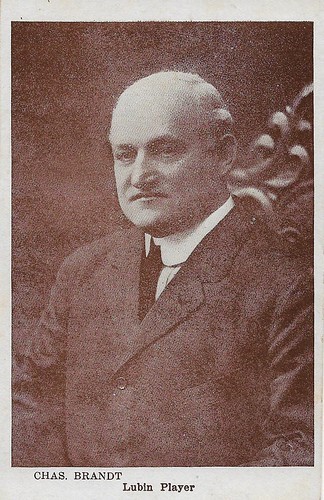
American postcard.Photo: Lubin. Stamp on the back: Empire Theatre.
Charles Brandt (1862-1924) was a well-known stage performer from the 1880s. From 1911, the cheerful, white-haired gentleman starred and supported in more than 60 films for Lubin, often seen as professionals or fathers in dramas and comedies. He first appeared in His Chorus Girl Wife (Harry Solter, 1911) starring Florence Lawrence. Perhaps he will be best remembered in the role of Sam Graham in The Fortune Hunter (Barry O'Neil, 1914) starring William Elliott and Ethel Clayton. In 1917 Brandt moved to the World Film Company, followed by the Betzwood Film Co in 1918. He was last seen in the First National production The Master Mind (Kenneth S. Webb, 1920) starring Lionel Barrymore.
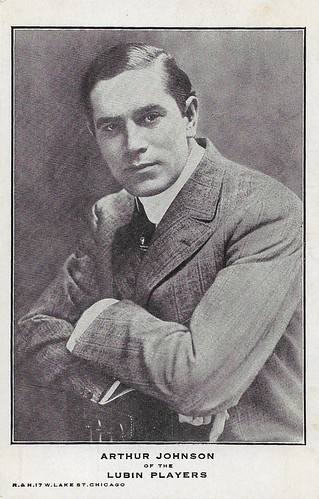
American postcard by R & H, Chicago. Photo: Lubin.
Arthur V. Johnson was born in 1876 in Cincinnati, Ohio, as Arthur Vaughen Johnson. He was a highly prolific actor and director, known for his work at the pre-Hollywood companies of Edison, American Biograph, and Lubin. His high productivity took his toll: in 1915 he had a nervous breakdown due to overwork, he stopped his career, and in early 1916 he died of TBC, almost forty.
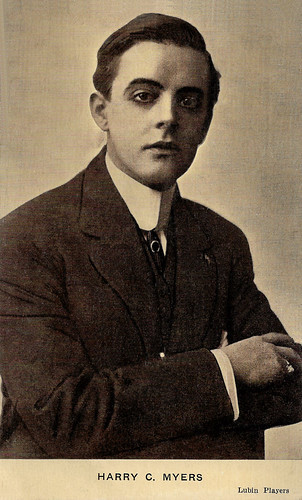
American postcard by Kraus Manufacturing Co., New York. Photo: Lubin.
Harry C. Myers (1882-1938) was an American film actor and director, sometimes credited as Henry Myers. He had been a theatre actor for 10 years before he made his film debut for Lubin in 1909. Myers went on to direct his own comedy shorts featuring him and his wife, Rosemary Theby, for Universal, the Vim Comedy Company, and Pathé studios. Later he played the eccentric alcoholic millionaire in Chaplin's City Lights (1931).
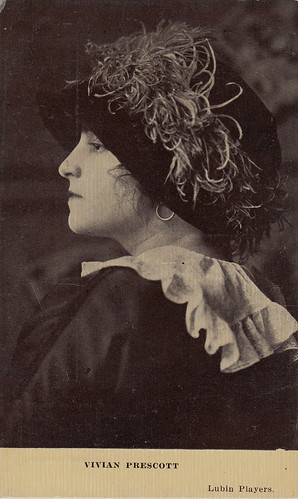
American postcard published by Kraus Mfg. Co., N.Y., no. K 445. Photo: Lubin. Collection: Marlene Pilaete.
Vivian Prescott was an Italian born American actress. She appeared in 202 films between 1909 and 1917. Vivian Prescott was born in Genoa, Italy. She spent some time on the American stage before entering silent pictures. She started at the Biograph comedy where D.W. Griffith directed her in such short silent films as Winning Back His Love (D. W. Griffith, 1910), Fisher Folks (D. W. Griffith, 1911), and The Primal Call (D. W. Griffith, 1911), all starring Wilfred Lucas. She also played in The Sands of Dee (D. W. Griffith, 1912) starring Mae Marsh and Robert Harron. The film is used in the opening scene of the psychological horror film The Spiral Staircase (Robert Siodmak, 1946) in a recreation of early film exhibition. The Spiral Staircase is set in 1906, making the appearance of this 1912 film anachronistic. Vivian Prescott moved to Independent Moving Pictures (IMP) where she appeared in The Man of the West (Otis Turner, 1912) starring King Baggot. For Lubin, she made a series of short comedies including Bob Builds a Chicken House (N.N., 1913), Bob Buys an Auto (Joseph W. Smiley, 1913) and Bob Builds a Boat (1913). In this series, Robert Fischer starred as Bob, and Prescott played his daughter. She also appeared in Man's Enemy (Frank Powell, 1914) starring Lillian Gish. Her final film was the short A Gentle Volunteer (Ben F. Wilson, 1916). Between 1909 and 1916 she made over 200 films. Her off-screen pseudonym was Violet Crawford.
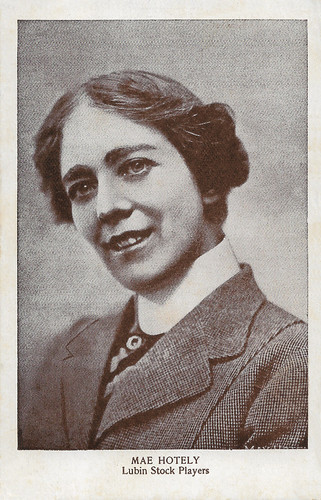
American postcard. Photo: Lubin.
Mae Hotely (1872-1954) was a brunette early silent screen comedienne, who starred in films for Lubin, produced by her husband Arthur Hotaling out of Jacksonville, Florida. She appeared in 85 films between 1911 and 1929.
Sources: Philadelphia Area Archives Research Portal (PAARP), Wikipedia, and IMDb.
Check out our earlier Before Hollywood posts: Vitagraph, Essanay, and Biograph.

British postcard, no. 78. Photo: Lubin. Collection: Marlene Pilaete.
Cute Buster Johnson (1908-1969) was the most famous child star of the Lubin company. Only 3 1/2 years old, he was extremely popular in 1912. Buster Johnson was born in 1908 in Brooklyn, New York as Hoyt Roswell Johnson. His parents were Roswell Joshua Johnson, a film cameraman for Lubin, and Florence S. Johnson. He had a sister who was named Ormi Hawley Johnson. His godmothers were the film stars Ormetta Hawley and Mary Pickford. The adorable little boy made his debut in the silent short The Kiddies' Christmas (N.N., 1911) at the Lubin Manufacturing Company. He was presented in the media as 'Lubin's Child Wonder', who played "both boys and girls with intelligence". The short comedy Buster's Dream (Charles H. France, 1912) led to the Buster series with such films as Buster and the Cannibal's Child (Charles H. France, 1912), and Buster and the Gypsies (Charles H. France, 1912). His co-stars were the child actors Henrietta O'Beck en Brooks McCloskey. The following year, Buster appeared in his last film, ironically called His First Experience (Arthur Hotaling, 1913) in which he played the son of Mae Hotely. In 1914, the Lubin Company had a fire that resulted in financial problems. It’s possible that because of this, they couldn’t afford all the actors they had on the roster, and perhaps they had to drop him. In all, Buster was in 14 films. Census records show that in 1930, he was living with family and was a bookkeeper at a bank. In 1934 he was married to Vivien Isabel Mehrhof in Ridgefield, New Jersey. Buster Johnson died in 1969 in the USA. He was 61.

English postcard, no. 38. Photo: Lubin.
Romaine Fielding (1867-1927) was an American actor, screenwriter, and silent film director known for his dramatic Westerns. Fielding worked for the Solax Film Company of New York before joining Lubin in November 1911 at the age of 44. Despite his age, he could easily portray much younger characters. In June 1912 Siegmund Lubin placed Fielding in charge of the Lubin Southwest Company as director, despite the fact that until then he had only acted. It was the start of a rapid rise to fame. Fielding would write and direct films as well as star in them. He broke with convention, challenging stereotypical casting of Indians and Mexicans as villains, such as Who is the Savage? (1913), starring Mary Ryan, Fielding's regular co-star in these years. His films often ended unexpectedly on a downbeat note. His work was praised in the trade press for its visual beauty combined with realism. His five-reel thriller The Golden God (1914) employed about 5,000 local extras and featured a cavalry and artillery charge. At one time he filmed a train smash at great expense. Lubin used the costly footage in five different films. Fielding made a number of Mexican-themed Western-style films and adventure films on location in California, Arizona, and New Mexico, but little of his work has survived. In July 1913, Motion Picture Story magazine announced that Fielding had come top of their readers poll with 1,311,018 votes.

English postcard. Photo: Lubin.
American film actor and director Harry C. Myers (1882-1938) was married to the actress Rosemary Theby. Myers had been a theatre actor for 10 years before he went to work for Lubin in 1909. A still existing example of Myers' career at Lubin is the drama When the Earth Trembled (Barry O'Neill, 1913), possibly the first fiction film to depict the 1906 San Francisco earthquake.

English postcard, no. 34. Photo: Lubin.
Canadian-born actress Florence Lawrence (1886-1938) began her career in the motion picture industry with a role in an Edison Company short, Daniel Boone/Pioneer Days in America (1907). Next, she worked for the Vitagraph Company. At the American Mutoscope and Biograph Company, Lawrence appeared in most of the sixty short films that D.W. Griffith directed in 1908. She became famous, known as “the Biograph girl.” In 1910, producer Carl Laemmle of the Independent Motion Picture Company (IMP) hired her. Lawrence was the object of a notorious publicity stunt. Her “death” in a streetcar accident was widely announced, followed by her resurrection in the first publicity tour in film history. Lawrence and her husband Harry Solter worked at IMP for eleven months and made approximately fifty films. Lawrence and Solter then joined Lubin in early 1911, but they left Lubin within a year, and, with Solter, started one of the first US film companies to be headed by a woman: the Victor Company.

English postcard, no. 44. Photo: Lubin.
Frank Spottiswoode Aitken (1868-1933) was a Scottish-American actor of the silent era. His film debut came at Lubin in the short comedy A Change of Heart (N.N., 1910) with Edna Luby. The following year, he appeared for Lubin in several shorts including Her Humble Ministry (Harry Solter, 1911) with Arthur V. Johnston and Florence Lawrence. Later, he played Dr. Cameron in D. W. Griffith's epic drama The Birth of a Nation (1915).
A running legal battle with Thomas Edison
Siegmund Lubin was born in Germany in 1851. He was educated at Heidelberg University and, following in the footsteps of his father, earned his degree in ophthalmology. Lubin traveled to the United States, first in 1868, and then immigrated permanently in 1876. He lived in New Haven, Connecticut, where he met his wife, Annie Abrams.
After they married, they traveled the United States together attending fairs and exhibitions where Lubin conducted eye examinations and sold eyeglasses. In 1882, after the birth of their daughter Edith, the family moved to Philadelphia where Lubin opened an optical shop at 237 North Eighth Street. His family occupied the second-floor apartment.
Lubin continued to travel around the country to attend exhibitions, and it was during a trip to New Orleans that he was first introduced to and became interested in the burgeoning field of Motion picture recording. "Pop" Lubin saw the potential in selling similar equipment as well as in making films. By 1896, Lubin had established his motion picture business, "Life Motion Pictures," using profits from his optical shop and the investments of family and friends.
He soon developed his own projector, the "Cineograph," that he manufactured, marketed, and sold to the general public, along with other varieties of projectors and films. His lower price and marketing know-how brought reasonable success. In 1897 Lubin began making films for commercial release. He staged and filmed re-enactments of famous boxing matches, battles of the Spanish-American War, and news stories.
Initially, Lubin filmed in parks and in his own backyard. Certain his business could prosper, the following year he rented low-cost space on the roof of a building in Philadelphia's business district where he built a more formal film studio. He exhibited his new equipment at the 1899 National Export Exposition in Philadelphia and the 1901 Pan-American Exposition in Buffalo, New York. In 1902, Lubin formed the Lubin Manufacturing Company and incorporated it in 1909 in Philadelphia, Pennsylvania. A notable film was Meet Me at the Fountain in 1904.
For years the Lubin Manufacturing Company, like most of the other major film studios, had a running legal battle with Thomas Edison that saw repeated lawsuits brought against Lubin for patent infringement. In 1908, Lubin gave up the costly fight with Edison and became part of the Motion Picture Patents Company, a monopoly on production and distribution set up by Edison.

English postcard. Photo: Lubin.
Arthur V. Johnson (1876-1916) was a highly prolific American actor and director, known for his work at the pre-Hollywood companies of Edison, American Biograph, and Lubin. In 1911 Johnson accepted an offer from Lubin that allowed him to direct as well as act. With Lottie Briscoe, his frequent co-star at Lubin, Johnson directed and starred in The Beloved Adventurer (1914), a 15 episode serial by Emmett Campbell Hall. His high productivity took its toll: in 1915 he had a nervous breakdown due to overwork, he stopped his career, and died of TBC, almost forty.

English postcard. Photo: Lubin.
American stage actress May Buckley (1875-?) became a popular film heroine with the role of 'Marguerite Moreland' in the Lubin production Paid in His Own Coin (1912). The following year she moved on to Selig, but later that year, she left the film business. Her private life was often in newspaper headlines, especially in 1901, when a man who claimed to be her husband shot at her in a hotel dining room, wounding one of her dining companions.

English postcard, no. 40. Photo: Lubin.
American actor Noah Reynolds (?-1948) appeared in a dozen Lubin shorts between 1910 and 1912. He was known for such Lubin shorts as the Western Percy the Cowboy (1910) in which he played the title role, Making a Man of Him (1910) with Harry Myers, and Archibald the Hero (1911), again as the title figure. He died in 1948 in North Philadelphia, Pennsylvania, USA.

British postcard, no. 45. Photo: Gilbert & Bacon, Philadelphia / Lubin. Collection: Marlene Pilaete.
Eleanor Caines (1870 or 1880-1913) was an American silent film actress. She spent most of her film career at the Lubin Film Company. According to IMDb, Eleanor Caines was born in 1870 in Philadelphia, Pennsylvania, USA. In 1909, she began her film career at Lubin in the short comedy Blissville the Beautiful (1909) with George Reehm and Harry Myers. In the following years, she appeared in some 30 Lubin productions. Eleanor Caines died in 1913 in her hometown Philadelphia at the age of 43. The cause of her death was surgery after an accident. She was married to William Robson with whom she had a child, and till her death to Jack Le Faint.

British postcard, no. 121. Photo: Lubin. Collection: Marlene Pilaete.
American silent screen motion picture actress Edna Payne (1891-1953) is regarded as a 'pioneer' in the film industry because she was in many short films from 1911 through 1917.
Edna Payne was born in 1891 in New York City. Petite, blue-eyed, and brown-haired, Edna was born "in the trunk". Her parents were both stage actors, so Payne began her career as a child in Vaudeville. She made her film debut in Higgenses Versus Judsons (1911). She played the lead in reel dramas, and later in a few reel Westerns including The Girl Stage Driver (1914). Although her film career was confined to the 1910s, she took part in countless productions. In 1917 she finished her acting career when she married actor Jack Rollens. They had two children, Edna J (1919), and Jack A (1921), but the couple divorced in 1925. Edna Payne died of a liver ailment in 1953, aged 61, in Los Angeles, California.

English postcard. Photo: Lubin.
Mae Hotely (1872-1954) was a brunette early silent screen comedienne, who starred in films for Lubin, produced by her husband Arthur Hotaling out of Jacksonville, Florida. She appeared in 85 films between 1911 and 1929.
A state of the art studio named Lubinville
The insatiable appetite of the American public for films saw Lubin's company undergo enormous growth. Aided by French-born writer and poet Hugh Antoine D'Arcy, who served as the studio's publicity manager, in 1910 Siegmund Lubin built a state of the art studio on the corner of Indiana Avenue and Twentieth Street in Philadelphia that became known as "Lubinville." The studio included an open tank under the floor that could be flooded to stage scenes involving large volumes of water as well as a cutting edge lighting system for use on cloudy days. There were also costume rooms, property storage rooms for set building, an editing room, a laboratory, and a cafeteria.
The facility allowed several film productions to be undertaken simultaneously. Lubin began to invest in the quality of his films and actors, for the first time. He recruited famous actresses and actors, such as Florence Lawrence, Ormi Hawley, and John Halliday, who brought greater acclaim to his productions.
The Lubin Manufacturing Company expanded production beyond Philadelphia, with facilities at 750 Riverside Avenue in Jacksonville, Florida, Los Angeles, and then in Coronado, California. In 1912, Lubin purchased a 350-acre (1.4 km2) estate in Betzwood, in what was then rural countryside in the northwest outskirts of Philadelphia, and converted the property into a studio and film lot.
That same year, director and actor Romaine Fielding travelled out to Prescott, Arizona with cast and crew and set up offices at 712 Western Avenue and an outdoor stage for shooting interiors behind Mercy Hospital (now the site of Prescott College). He filmed approximately a dozen films there before moving to Tucson, Arizona, where he directed another 60 or so silent short films. William Duncan and Selig Polyscope Company took over the Prescott facility.

English postcard, no. 47. Photo: Lubin.
American actress Rita Davis is known for such early silent Lubin films as Three Hearts (N.N., 1910), Faith Lost and Won (1910), and The Widow's Choice (1911).

English postcard, no. 39. Photo: Lubin.
Ethel Elder was an American silent film actress who worked for the Lubin company. 'Miss Elder' is known for such short films as The Mystery (1912), The Path of Genius (1912), and Billy's Surrender (1912).

English postcard, no. 37. Photo: Lubin.
Albert McGovern (1882-?) was an American actor and director who worked for the Lubin company. Between 1910 and 1914 he played in more than 30 short silent films.

British postcard, no. 72. Photo: Lubin. Collection: Marlene Pilaete.
American actress Ormi Hawley (1889-1942) was a silent film actress who worked for the Lubin Manufacturing Company and later for Fox, Mutual, and Paramount. Dubbed "The Lillian Russell of the Pictures", she usually played gracious society roles or aristocrats. Between 1911 and 1919, she appeared in more than 300 pictures. Ormetta Grace Hawley was born in 1889 in Holyoke, Massachusetts. She attended the New England Conservatory of Music. In her teens, she began her acting career in live theatre with a stock theater company in Boston. In 1911, she turned to the new silent film industry with Lubin Studios in Philadelphia, Pennsylvania. There she appeared in the Jules Verne adaptation Michael Strogoff (Lloyd B. Carleton, 1914), featuring Jacob P. Adler, and The Shanghaied Baby (George Terwilliger, 1915). After being retrenched by Lubin in 1916, she worked for Mutual, Fox, Paramount, and other companies. She played in such dramas as Where Love Leads (Frank Griffin, 1916) with Rockliffe Fellowes, Runaway Romany (George W. Lederer, 1917) starring Marion Davies, and Mrs. Dane's Defense (Hugh Ford, 1918) starring Pauline Frederick. During her short film career, Ormi Hawley reportedly appeared in more than three hundred motion pictures. A large number were short films. In 1919, she made her last films such as The Unwritten Code (Bernard J. Durning, 1919) starring Shirley Mason and Matt Moore, and The Splendid Romance (Edward José, 1919) starring Enrico Caruso. One of her later jobs was managing the All American Girl's Symphony Orchestra. From 1928 till her death, Hawley was married to Charles Fulcher. For the last 15 years of her life, Hawley and her husband operated a farm near Camden, New York. She also painted portraits and wrote stories for children. Ormi Hawley died in a hospital in Rome, New York, in 1942. Her obituary in the New York Times claimed she was in 370 films.

British postcard, no. 103. Photo: Lubin. Collection: Marlene Pilaete.
Silent film actress Jennie Nelson was born in Copenhagen, Denmark. In 1910, she made her film debut at the Lubin Manufacturing Company in the short comedy Spoony Sam (1910) featuring George Reehm. The actress became known at Lubin with such short silent films as the war drama The Battle of Shiloh (Joseph W. Smiley, 1913) and the comedy Jane's Waterloo (Joseph W. Smiley, 1913). For Universal, she later appeared in the comedy Lucile the Waitress (William Bailey, 1916). Her final film was for the Victor film company, the comedy Signs of Trouble (William Bailey. 1917). Between 1910 and 1917, she appeared in 32 films.

British postcard in the "Pictures" Portrait Gallery, London.
Ethel Clayton (1882-1966) was an American stage and screen actress and singer. In 1909 she started film acting with the company Essanay. After five films she left Essanay and the film sets, but in 1912 she was lured back, but now to the company Lubin, first acting in For the Love of a Girl (1912), opposite Harry Myers, with whom she would often act together. Clayton got first billing or was at least the female lead in many films. After 27 more shorts at Lubin, she acted in her first feature there, When the Earth Trembled (Barry O'Neil, 1913), a family and business drama against the background of the 1906 San Francisco earthquake. More shorts but also features followed, such as The Lion and the Mouse (Barry O'Neill, 1914) and The Fortune Hunter (Barry O'Neill, 1914). Clayton stayed with Lubin until 1916, when she first shifted to World Film, followed by Paramount and other companies.
A heavy billed as Babe Hardy
Some of the pioneer actors who worked for Lubin included Romaine Fielding, Ed Genung, Harry Myers, Florence Hackett, Alan Hale, Arthur V. Johnson, Lottie Briscoe, Florence Lawrence, Ethel Clayton, Gladys Brockwell, Edwin Carewe, Ormi Hawley, Rosemary Theby, Betty Brice, Alice Mann, and Pearl White.
Lubin films also marked the first film appearance of Oliver Hardy , who started working at Lubin's Jacksonville, Florida studio in 1913. Hardy's first onscreen appearance was in Outwitting Dad (1914) where he was billed as O. N. Hardy. In many of his later films at Lubin, he was billed as “Babe Hardy”. He was most often cast as “the heavy” or the villain and had roles in comedy shorts, appearing in some 50 short one-reeler films at Lubin by 1915.
However, the company's downfall came even faster than its meteoric rise. Despite Lubin's efforts, by early 1912, the Lubin Manufacturing Company began to fall behind the more progressive members of the Motion Picture Patents Company and other independent producers of films in terms of overall quality and film length. Lubin was not as adroit as its competitors in shifting to quality feature-length films.
Also, a disastrous fire at its main studio in June 1914, damaged nearby buildings and destroyed the negatives for a number of unreleased new films, which severely hurt the business. When World War I broke out in Europe in September of that year, Lubin and other American filmmakers', lost a large source of income from these foreign sales. In 1915, Lubin was forced to begin consolidating his business and he closed the studios one-by-one.
Despite efforts of one employee to move the company to California, the eastern branch of the Lubin Manufacturing Company would remain the dominant base of operations. The Lubin company entered into an agreement to form a film distribution partnership, with Vitagraph Studios, Selig Polyscope Company, and Essanay Studios, known as V-L-S-E, Incorporated. Lubin also tried to re-release popular films as well as to sign more famous actors, such as Charlie Chaplin .
However, none of these efforts changed the company's fate. The United States Supreme Court rulings against the monopoly of the Motion Picture Patents Company spelled the end of Lubin's business. After making more than a thousand films the corporation was forced into bankruptcy and on 1 September 1916, the Lubin Manufacturing Company closed its doors for good. Siegfried Lubin went back to his work as an optician and died in 1923.

American postcard by Kraus Manufacturing Company, New York, 1913. Photo: Lubin.
Peter Lang (1859-1932) was an American actor. After some 25 shorts at Lubin, Lang's first feature at Lubin was When the Earth Trembled (Barry O'Neil, 1913). After that film, Lang shifted to Famous Players, playing in feature-length dramas like An American Citizen (1914), starring John Barrymore. But in 1914 Lang was back at Lubin for features there such as Michael Strogoff (Lloyd B. Carleton, 1914), and the Western The Valley of Lost Hope (Romaine Fielding, 1916).

American postcard published by Kraus Mfg. Co., N.Y. Photo: Lubin. Collection: Marlene Pilaete.
Florence Williams was a matron-like American silent film actress. She started her film career at the Lubin Manufacturing Company in the short comedy Getting Married (Arthur Hotaling, 1913) with Robert Fischer and Jennie Nelson. According to IMDb, she was known for the short drama The Wolf (Barry O'Neil, 1914), The College Widow (Barry O'Neil, 1915) with Ethel Clayton, and The Sporting Duchess (Barry O'Neil, 1915). She ended her film career with Otto the Sleuth (Edwin McKim, 1916), an episode of the Otto comedies with Davy Don as Otto.

American postcard published by Kraus Mfg. Co., N.Y. Photo: Lubin. Collection: Marlene Pilaete.
Howard M. Mitchell (1883-1958) was an American actor and film director. He appeared in 270 films between 1910 and 1952 and directed 38 silent films between 1915 and 1927. Howard M. Mitchell was born in 1883 in Pittsburgh, Pennsylvania. In 1909, he started his film career as an actor in the Lubin Manufacturing Company's Martyr or Crank? (N.N., 1909) with Harry Myers. For Lubin followed several short films such as The Irish Boy (1910), The Miner's Sweetheart (1910), and A Change of Heart (1910) with Spottiswoode Aitken. In 1911 he married actress Mary Land. Till 1916, he appeared in many short films for Lubin and Thanhouser. He then focused on directing and made such films as The Mother Heart (1921), Lovetime (1921), and Romance Ranch (1924). In 1927, Howard M. Mitchell returned to the screen in A Bowery Cinderella (Burton L. King, 1927). During the following decades, he worked as a bit player in countless films. He could be glimpsed in films like They Won't Forget (Mervyn LeRoy, 1937) with Claude Rains, The Great Waltz (Julien Duvivier, 1938) with Luise Rainer, and Queen of the Mob (James P. Hogan, 1940) with Ralph Bellamy. His final film appearance was in Carrie (William Wyler, 1952) starring Laurence Olivier and Jennifer Jones. Howard M. Mitchell died in 1958 in Hollywood, California.

American postcard published by Kraus Mfg. Co., N.Y. Photo: Lubin. Collection: Marlene Pilaete.
Lottie Briscoe (1883-1950) was a raven-haired American stage and silent screen actress. After starting her film career with Essanay in Chicago, Lottie worked for the Lubin Company from 1912 to 1915. There she formed a popular couple with matinée idol Arthur V. Johnson. Briscoe appeared in over 94 motion pictures. Lottie Briscoe was born in 1883 in St. Louis, Missouri. Her parents were Mr. and Mrs. T. D. Briscoe. Her father may have been involved in theatre work and her mother was known to the theatre community as a likable stage mother. A sister, Olive Helen Briscoe, had long a career in vaudeville as a singer and comedian. Lottie was a child performer from the age of four. She then graduated to ingénue roles at the Orpheum Theater in Philadelphia. Around 1909 Briscoe, along with Harry McRae Webster, joined the fledgling Essanay Studios in Chicago. At least two films during this period, both one-reelers from January 1911, are known to exist today; The Sophomore’s Romance and A Sin Unpardonable. From 1912 to 1915, Lottie worked for the Lubin Company, where she was popularly paired with matinée idol Arthur V. Johnson. Their films include The Country School Teacher (N.N., 1912) and The Power of the Cross (Arthur V. Johnson, 1913). Their most ambitious project together during this period was probably The Belovéd Adventurer (1914), a 15-episode serial written by Emmett Campbell Hall. In January 1916, Arthur V. Johnson died shortly after the release of their latest film, the Maie B. Hovey story The Lost Rose (1919). Lottie Briscoe left the film business. In 1918, she only briefly returned to play Gertie Farish in her final film, The House of Mirth (Albert Capellani, 1918). On the stage, she played the title role in a domestic comedy by George Kelly entitled 'Mrs. Wellington's Surprise'. In 1922 Briscoe signed to appear in a leading role with William Faversham in 'The Squaw Man'. She continued to appear in Vaudeville before being confined at home due to a debilitating illness. Lottie Briscoe died in 1950 in New York City, at the age of 66. She was married to Harry McRae Webster (1903-1911) and Harry Mountford (1921-). Harry McRae Webster was a motion picture director of some note before he was sued in the early 1920s by a film studio over the unauthorised use of nude models in one of his movies. Mountford was formerly an executive secretary of the White Rats Actors Union which was disbanded in 1930.

American postcard published by Kraus Mfg. Co., N.Y., no. K 437. Photo: Lubin. Collection: Marlene Pilaete.
American actress Marie Weirman or Marie Wierman (1893–1956) started her film career at the Lubin Manufacruring Company in 1912. Marie Weirman was a silent film actress, who started her career at the Lubin Manufacturing Company in such short dramas as The Blacksmith (Wilbert Melville, 1912). For other companies, she later made Fanny's Melodrama (Wilfrid North, Wally Van, 1914), The Marble Heart (George Lessey, 1915) with King Baggott, and Under Southern Skies (Lucius Henderson, 1915) starring Mary Fuller. According to IMDb, she made nearly 40 films. However, Wikipedia tells another story. In 1912, Marie Wierman became a member of the Lubin Stock Company. She was born Marie Elizabeth Wierman in 1983 in Philadelphia. Marie was the daughter of Mary E. Wierman. From 1912, she was a member of the Lubin Stock Company and worked on films in Maine. As Mary Warren, she was an actress based in Hollywood who appeared in about two dozen silent films between 1918 and 1924, including The Sea Panther (1918), The Vortex (1918), An Honest Man (1918), All Night (1918), What Every Woman Wants (1919), The Final Close-Up (1919), Girls (1919), Prudence on Broadway (1919), The City of Comrades (1919), The Prince of Avenue A (1920), Guile of Women (1921), Voices of the City (1921), Come on Over (1922), The Man Who Won (1923), The Wolf Man (1923), Cupid's Fireman (1923), and In Love with Love (1924). She also made one sound film, Irish Hearts (1934). In 1916, Mary Warren married character actor Lee Phelps. They had two daughters, Marilee and Patricia. Lee Phelps died in 1953. Mary Warren died in 1956, aged 62 years, in Los Angeles, California. She was the mother of actress Marilee Phelps and grandmother of music supervisor Madeleine Smith.

American postcard.Photo: Lubin. Stamp on the back: Empire Theatre.
Charles Brandt (1862-1924) was a well-known stage performer from the 1880s. From 1911, the cheerful, white-haired gentleman starred and supported in more than 60 films for Lubin, often seen as professionals or fathers in dramas and comedies. He first appeared in His Chorus Girl Wife (Harry Solter, 1911) starring Florence Lawrence. Perhaps he will be best remembered in the role of Sam Graham in The Fortune Hunter (Barry O'Neil, 1914) starring William Elliott and Ethel Clayton. In 1917 Brandt moved to the World Film Company, followed by the Betzwood Film Co in 1918. He was last seen in the First National production The Master Mind (Kenneth S. Webb, 1920) starring Lionel Barrymore.

American postcard by R & H, Chicago. Photo: Lubin.
Arthur V. Johnson was born in 1876 in Cincinnati, Ohio, as Arthur Vaughen Johnson. He was a highly prolific actor and director, known for his work at the pre-Hollywood companies of Edison, American Biograph, and Lubin. His high productivity took his toll: in 1915 he had a nervous breakdown due to overwork, he stopped his career, and in early 1916 he died of TBC, almost forty.

American postcard by Kraus Manufacturing Co., New York. Photo: Lubin.
Harry C. Myers (1882-1938) was an American film actor and director, sometimes credited as Henry Myers. He had been a theatre actor for 10 years before he made his film debut for Lubin in 1909. Myers went on to direct his own comedy shorts featuring him and his wife, Rosemary Theby, for Universal, the Vim Comedy Company, and Pathé studios. Later he played the eccentric alcoholic millionaire in Chaplin's City Lights (1931).

American postcard published by Kraus Mfg. Co., N.Y., no. K 445. Photo: Lubin. Collection: Marlene Pilaete.
Vivian Prescott was an Italian born American actress. She appeared in 202 films between 1909 and 1917. Vivian Prescott was born in Genoa, Italy. She spent some time on the American stage before entering silent pictures. She started at the Biograph comedy where D.W. Griffith directed her in such short silent films as Winning Back His Love (D. W. Griffith, 1910), Fisher Folks (D. W. Griffith, 1911), and The Primal Call (D. W. Griffith, 1911), all starring Wilfred Lucas. She also played in The Sands of Dee (D. W. Griffith, 1912) starring Mae Marsh and Robert Harron. The film is used in the opening scene of the psychological horror film The Spiral Staircase (Robert Siodmak, 1946) in a recreation of early film exhibition. The Spiral Staircase is set in 1906, making the appearance of this 1912 film anachronistic. Vivian Prescott moved to Independent Moving Pictures (IMP) where she appeared in The Man of the West (Otis Turner, 1912) starring King Baggot. For Lubin, she made a series of short comedies including Bob Builds a Chicken House (N.N., 1913), Bob Buys an Auto (Joseph W. Smiley, 1913) and Bob Builds a Boat (1913). In this series, Robert Fischer starred as Bob, and Prescott played his daughter. She also appeared in Man's Enemy (Frank Powell, 1914) starring Lillian Gish. Her final film was the short A Gentle Volunteer (Ben F. Wilson, 1916). Between 1909 and 1916 she made over 200 films. Her off-screen pseudonym was Violet Crawford.

American postcard. Photo: Lubin.
Mae Hotely (1872-1954) was a brunette early silent screen comedienne, who starred in films for Lubin, produced by her husband Arthur Hotaling out of Jacksonville, Florida. She appeared in 85 films between 1911 and 1929.
Sources: Philadelphia Area Archives Research Portal (PAARP), Wikipedia, and IMDb.
Check out our earlier Before Hollywood posts: Vitagraph, Essanay, and Biograph.
Published on February 20, 2021 22:00
February 19, 2021
Recently acquired: caricatures from Germany and Italy
Ivo Blom recently acquired two series of caricatures of film stars. One series dates from the early 1930s and was published by an unknown German publisher and the caricatures were drawn by the German illustrator Eberhard Renziehausen, who signed as 'Rienzi'. The other series was made in Italy in the 1910s. The four caricatures were designed by Sandro Properzi for the Roman magazine Le Maschere.
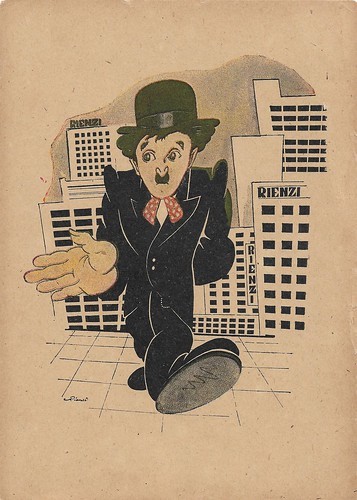
German collectors card. Caricature by Rienzi .
English comedian Charles ‘Charlie’ Chaplin (1889-1977) was one of the most creative and influential personalities of the silent-film era. His most famous role was that of The Tramp with his toothbrush mustache, undersized bowler hat, and bamboo cane who struggled to survive while keeping his dignity in a world with great social injustice.
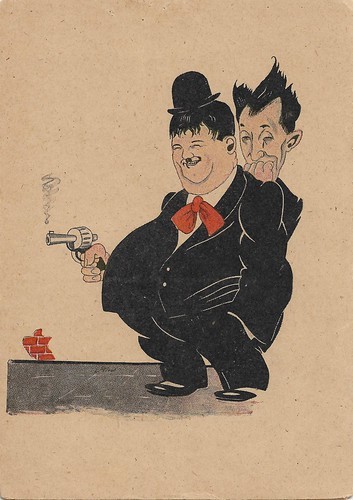
German collectors card. Caricature by Rienzi. In Germany, Laurel & Hardy are known as Dick und Doof.
Thin Englishman Stan Laurel (1890–1965) and heavyset American Oliver Hardy (1892-1957) were a comedy double act during the early classical Hollywood era. They became well known during the late 1920s through the mid-1940s for their slapstick comedy with Laurel playing the clumsy and childlike friend of the pompous Hardy.
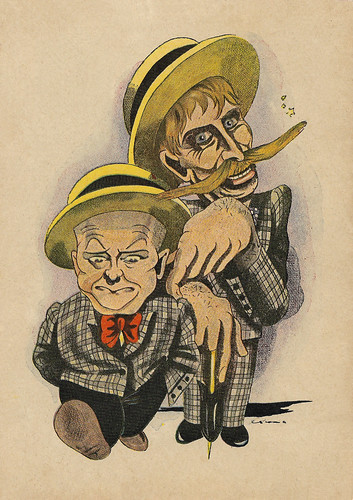
German collectors card. Caricature by Rienzi.
The Danish double-act Fy og Bi (Fyrtårnet og Bivognen) was the most famous comedy couple of the European silent cinema. Long Carl Schenstrom (1881-1942) and short Harald Madsen (1890-1949) became very popular in the 1920s with their short slapstick films. In Germany and Austria, Fy og Bi are known as Pat & Patachon, in the Netherlands as Watt & Halfwatt, in France as Doublepatte et Patachon, in Great Britain as Long & Short, in Sweden as Telegrafstopen och Tilhengern, and in the US as Ole & Aksel. Before Abbott & Costello, Martin & Lewis and Laurel & Hardy, Fy & Bi were the world's first internationally famous comedy team.
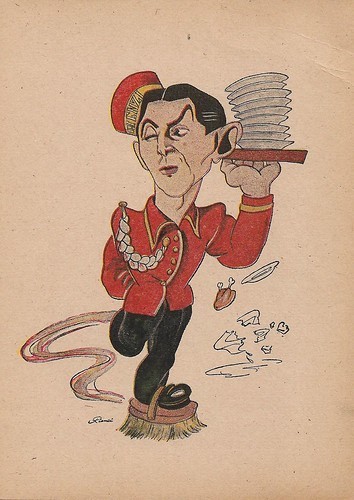
German collectors card. Caricature by Rienzi.
German-Austrian comedian, director, and author Theo Lingen (1903-1978) enjoyed for decades huge popularity as a devoted servant or bureaucratic dignitary in films. The German and Austrian comedy isn’t imaginable without this brilliant character actor.
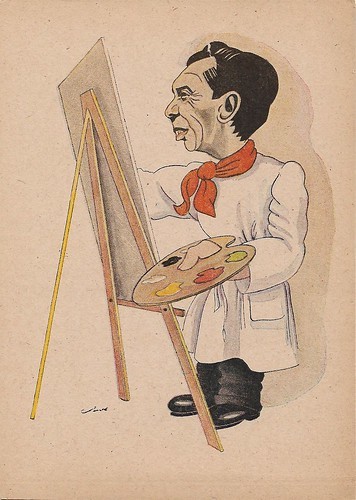
German collectors card. Caricature by Rienzi.
German character actor Rudolf Platte (1904-1984) played both cheerfully talkative and reserved and shy, but loving people in more than 200 films. After his death, the media hailed him as Berlin’s ‘last true folk actor’.
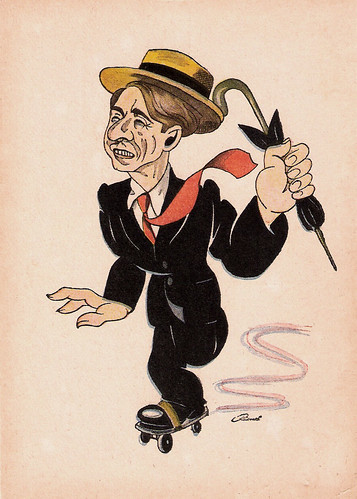
German collectors card. Caricature by Rienzi.
Paul Kemp (1899-1953) was one of the most popular comedians of the German cinema in the 1930s. For a short time, he was even in greater favour of the audience than Heinz Rühmann.
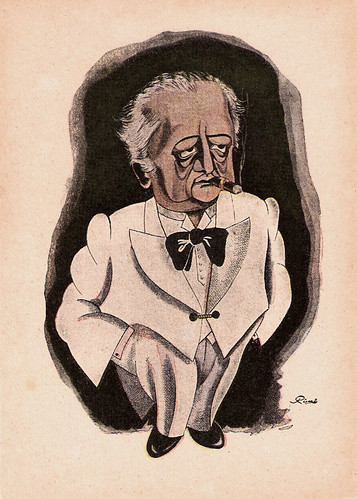
German collectors card. Design: Rienzi.
Aribert Wäscher (1895–1961) was a German actor, who acted from the silent era up to the mid-1950s. He had important parts in Viktor und Viktoria (1933), Petersburger Nächte (1935), Amphitryon (1935), Madame Bovary (1937), Brillanten (1937), Es war eine rauschende Ballnacht (1939), Rembrandt (1942), Berliner Ballade (1948), and The Man Between (1953), often playing antipathic antagonists.
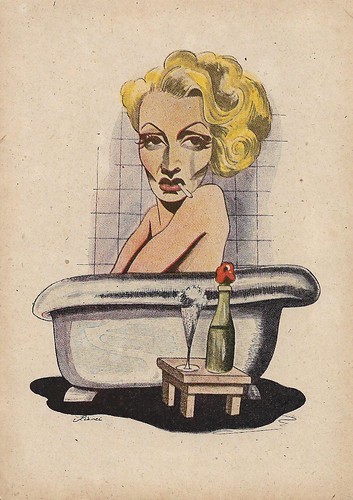
German postcard, 1930s. Caricature by Rienzi (Eberhard Renziehausen).
Marlene Dietrich (1901-1992) was the first German actress who became successful in Hollywood. Throughout her long career, she constantly re-invented herself. In 1920s Berlin, she started as a cabaret singer, chorus girl, and film actress. In the 1930s, she became a Hollywood star, then a World War II frontline entertainer, and finally, she was an international stage show performer from the 1950s till the 1970s. Now we remember her as one of the icons of the 20th century.
Italian caricatures by Sandro Properzi
Sandro Properzi was a prolific Italian caricaturist and postcard, sheet music, and poster designer, e.g. for furniture-maker Poltrona Frau. He was also the art director of the films L'Inferno/Dante's Inferno (Francesco Bertolini, Adolfo Padovan, Giuseppe de Liguoro, 1911) - faithfully recreating the settings from Gustave Doré's art, La Sacra Bibbia/After Six Days (Pier Antonio Gariazzo, Armando Vey, 1920) and I quattro moschettieri/The Four Musketeers (Carlo Campogalliani, 1936). Properzi was also an artist who exhibited his paintings and watercolors at the yearly exhibition of Palazzo della Permanente, the Modern Art Museum in Milano, in 1915, 1923, and 1925.
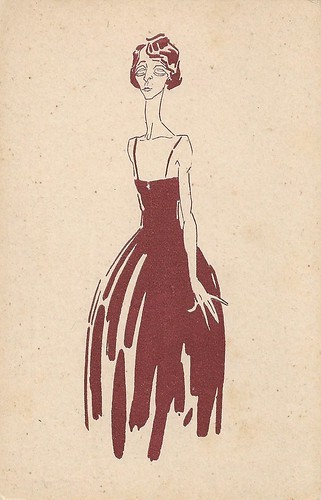
Italian postcard. Caricature by Sandro Properzi for Le Maschere, Rome.
Polish - some say Ukrainian - actress Diana Karenne (1888-1940) was one of the divas of Italian silent cinema.
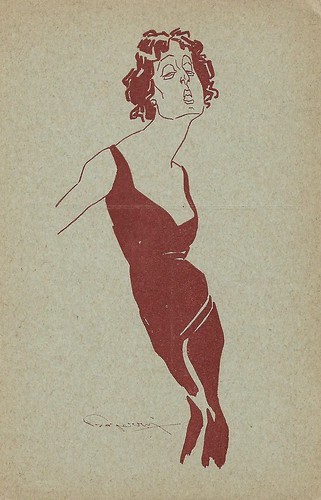
Italian postcard. Caricature by Sandro Properzi for Le Maschere, Rome.
Fascinating and enigmatic Pina Menichelli (1890-1984) was the most bizarre Italian diva of the silent era. With her contorted postures and disdainful expression, she impersonated the striking femme fatale.
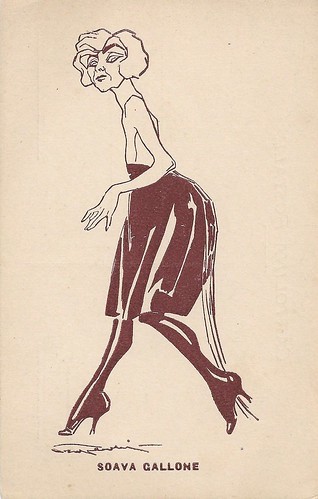
Italian postcard. Caricature by Sandro Properzi for Le Maschere, Rome.
Polish actress Soava Gallone (1880-1957) was one of the divas of Italian silent cinema.
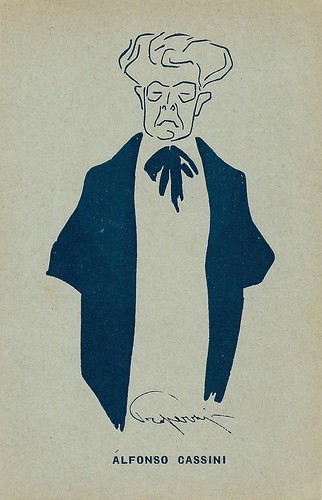
Italian postcard. Caricature by Sandro Properzi for Le Maschere, Rome.
Alfonso Cassini (1858-1921) was an Italian actor in theatre and silent cinema.
More? Check out this earlier post on film star caricatures. And next Saturday, EFSP will present a post with caricatures of female stars from the collection of Marlene Pilaete.

German collectors card. Caricature by Rienzi .
English comedian Charles ‘Charlie’ Chaplin (1889-1977) was one of the most creative and influential personalities of the silent-film era. His most famous role was that of The Tramp with his toothbrush mustache, undersized bowler hat, and bamboo cane who struggled to survive while keeping his dignity in a world with great social injustice.

German collectors card. Caricature by Rienzi. In Germany, Laurel & Hardy are known as Dick und Doof.
Thin Englishman Stan Laurel (1890–1965) and heavyset American Oliver Hardy (1892-1957) were a comedy double act during the early classical Hollywood era. They became well known during the late 1920s through the mid-1940s for their slapstick comedy with Laurel playing the clumsy and childlike friend of the pompous Hardy.

German collectors card. Caricature by Rienzi.
The Danish double-act Fy og Bi (Fyrtårnet og Bivognen) was the most famous comedy couple of the European silent cinema. Long Carl Schenstrom (1881-1942) and short Harald Madsen (1890-1949) became very popular in the 1920s with their short slapstick films. In Germany and Austria, Fy og Bi are known as Pat & Patachon, in the Netherlands as Watt & Halfwatt, in France as Doublepatte et Patachon, in Great Britain as Long & Short, in Sweden as Telegrafstopen och Tilhengern, and in the US as Ole & Aksel. Before Abbott & Costello, Martin & Lewis and Laurel & Hardy, Fy & Bi were the world's first internationally famous comedy team.

German collectors card. Caricature by Rienzi.
German-Austrian comedian, director, and author Theo Lingen (1903-1978) enjoyed for decades huge popularity as a devoted servant or bureaucratic dignitary in films. The German and Austrian comedy isn’t imaginable without this brilliant character actor.

German collectors card. Caricature by Rienzi.
German character actor Rudolf Platte (1904-1984) played both cheerfully talkative and reserved and shy, but loving people in more than 200 films. After his death, the media hailed him as Berlin’s ‘last true folk actor’.

German collectors card. Caricature by Rienzi.
Paul Kemp (1899-1953) was one of the most popular comedians of the German cinema in the 1930s. For a short time, he was even in greater favour of the audience than Heinz Rühmann.

German collectors card. Design: Rienzi.
Aribert Wäscher (1895–1961) was a German actor, who acted from the silent era up to the mid-1950s. He had important parts in Viktor und Viktoria (1933), Petersburger Nächte (1935), Amphitryon (1935), Madame Bovary (1937), Brillanten (1937), Es war eine rauschende Ballnacht (1939), Rembrandt (1942), Berliner Ballade (1948), and The Man Between (1953), often playing antipathic antagonists.

German postcard, 1930s. Caricature by Rienzi (Eberhard Renziehausen).
Marlene Dietrich (1901-1992) was the first German actress who became successful in Hollywood. Throughout her long career, she constantly re-invented herself. In 1920s Berlin, she started as a cabaret singer, chorus girl, and film actress. In the 1930s, she became a Hollywood star, then a World War II frontline entertainer, and finally, she was an international stage show performer from the 1950s till the 1970s. Now we remember her as one of the icons of the 20th century.
Italian caricatures by Sandro Properzi
Sandro Properzi was a prolific Italian caricaturist and postcard, sheet music, and poster designer, e.g. for furniture-maker Poltrona Frau. He was also the art director of the films L'Inferno/Dante's Inferno (Francesco Bertolini, Adolfo Padovan, Giuseppe de Liguoro, 1911) - faithfully recreating the settings from Gustave Doré's art, La Sacra Bibbia/After Six Days (Pier Antonio Gariazzo, Armando Vey, 1920) and I quattro moschettieri/The Four Musketeers (Carlo Campogalliani, 1936). Properzi was also an artist who exhibited his paintings and watercolors at the yearly exhibition of Palazzo della Permanente, the Modern Art Museum in Milano, in 1915, 1923, and 1925.

Italian postcard. Caricature by Sandro Properzi for Le Maschere, Rome.
Polish - some say Ukrainian - actress Diana Karenne (1888-1940) was one of the divas of Italian silent cinema.

Italian postcard. Caricature by Sandro Properzi for Le Maschere, Rome.
Fascinating and enigmatic Pina Menichelli (1890-1984) was the most bizarre Italian diva of the silent era. With her contorted postures and disdainful expression, she impersonated the striking femme fatale.

Italian postcard. Caricature by Sandro Properzi for Le Maschere, Rome.
Polish actress Soava Gallone (1880-1957) was one of the divas of Italian silent cinema.

Italian postcard. Caricature by Sandro Properzi for Le Maschere, Rome.
Alfonso Cassini (1858-1921) was an Italian actor in theatre and silent cinema.
More? Check out this earlier post on film star caricatures. And next Saturday, EFSP will present a post with caricatures of female stars from the collection of Marlene Pilaete.
Published on February 19, 2021 22:00
February 18, 2021
9 (2009)
The animation film 9 (Shane Acker, 2009) is situated in a world destroyed in a war between man and machine. The film was produced by Russian director Timur Bekmambetov, Jim Lemley, Dana Ginsburg, and Tim Burton.
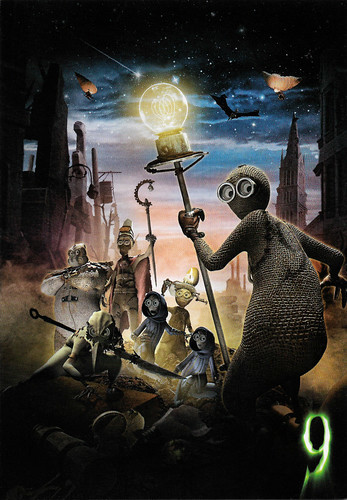
Belgian postcard by Boomerangjack. Photo: Cinenews.be. Publicity still for 9 (Shane Acker, 2009).
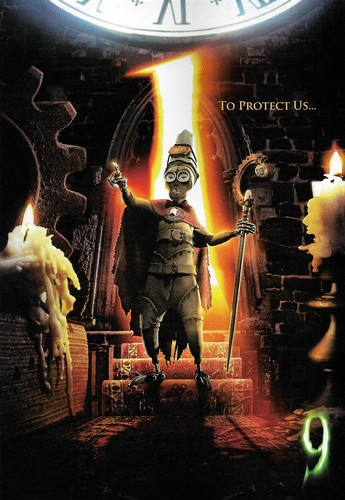
Belgian postcard by Boomerangjack. Photo: Cinenews.be. Publicity still for 9 (Shane Acker, 2009). Caption: 1 - to protect us...
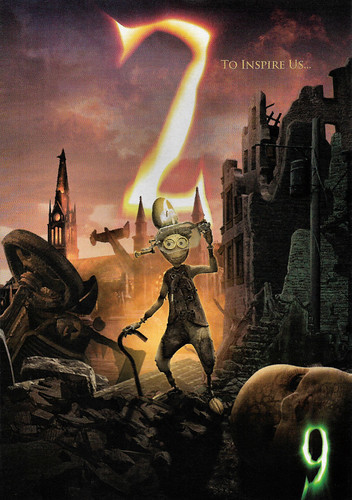
Belgian postcard by Boomerangjack. Photo: Cinenews.be. Publicity still for 9 (Shane Acker, 2009). Caption: 2 - to inspire us...
A battle against a Transformer-like red-eyed monster called the Beast
A hand-stitched doll with the number 9 written on its back (and with the voice of Elijah Wood) comes to life. The world he has awakened in is frightening, but #9 quickly learns that he is not alone and that there are others like him, also with a single digit written on their back.
The first one he encounters is #2 who tells him something of what happened to the world. 2 is also thrilled with the disk 9 is carrying, one with three unique symbols on the front.
They meet also #1 through #8, including the domineering war veteran #1 (voice of Christopher Plummer), the aging inventor #2 (voice of Martin Landau), the stout mechanic #5 (voice of John C. Reilly), the visionary artist #6 (voice of Crispin Glover), and the fearless warrior #7 (voice of Jennifer Connelly).
They find themselves in a battle against a Transformer-like red-eyed monster called the Beast in which #9 shows unique leadership skills. The nine will prove capable of salvaging what still remains of this world, and laying the groundwork for a hopeful future.
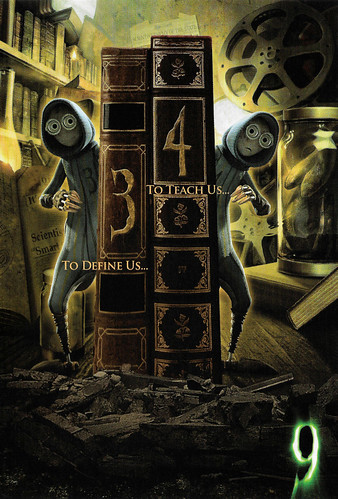
Belgian postcard by Boomerangjack. Photo: Cinenews.be. Publicity still for 9 (Shane Acker, 2009). Caption: 3 - to define us.... / 4 - to teach us...
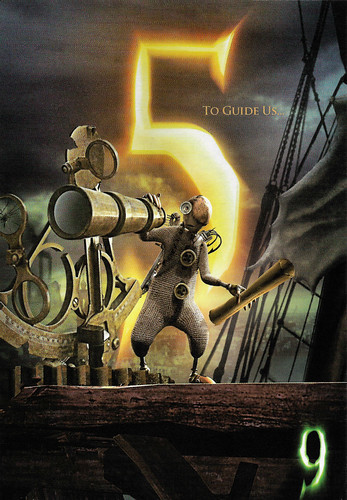
Belgian postcard by Boomerangjack. Photo: Cinenews.be. Publicity still for 9 (Shane Acker, 2009). Caption: 5 - to guide us...
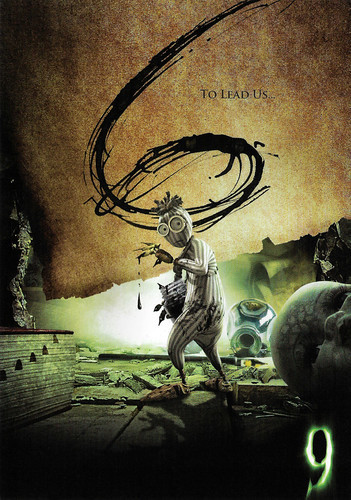
Belgian postcard by Boomerangjack. Photo: Cinenews.be. Publicity still for 9 (Shane Acker, 2009). Caption: 6 - to lead us...
A ground-breaking post-apocalyptic fable
Wikipedia describes 9 as "a 2009 computer-animated post-apocalyptic action film". The film is based on a short film that Shane Acker, then a student at UCLA, made in 2005. This film, also titled 9, was nominated for a 2006 Oscar.
So Acker was permitted to make his feature directorial debut with an expanded version of his ground-breaking post-apocalyptic fable. 9 (Shane Acker, 2009) was the second animated feature film to be released by Focus Features. The first was Coraline (Henry Selick, 2009) based on the book by Neil Gaiman.
The first images of 9 (Shane Acker, 2009) are spellbinding. In close-up, thick fingers make the final stitches in a roughly humanoid little rag doll, and binocular eyes are added. This creature comes to life, walks on tottering legs, and ventures fearfully into the devastation of a bombed-out cityscape.
9 (2009) received generally mixed reviews. The general sentiment by critics was that the film is "long on imaginative design but less substantial in the narrative."
Roger Ebert gave the film 3 out of 4 stars in the Chicago Sun-Times : "9 is nevertheless worth seeing. It might have been an opportunity for the sort of challenging speculation sci-fi is best at, however, and the best reason to see it is simply because of the creativity of its visuals. They're entrancing."
Variety 's Todd McCarthy wrote: "In the end, the picture's impact derives mostly from its design and assured execution." 9 earned $48.4 million on a $30 million budget.
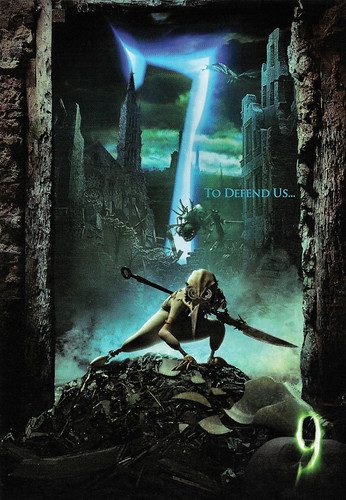
Belgian postcard by Boomerangjack. Photo: Cinenews.be. Publicity still for 9 (Shane Acker, 2009). Caption: 7 - to defend us...
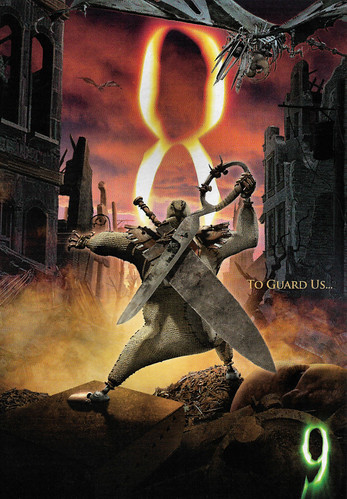
Belgian postcard by Boomerangjack. Photo: Cinenews.be. Publicity still for 9 (Shane Acker, 2009). Caption: 8 - to guard us...
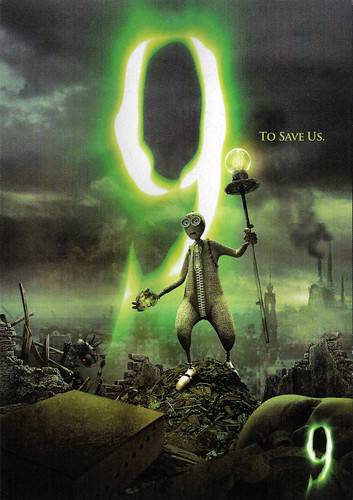
Belgian postcard by Boomerangjack. Photo: Cinenews.be. Publicity still for 9 (Shane Acker, 2009). Caption: 9 - to save us.
Sources: Roger Ebert (Roger Ebert.com), Jason Buchanan (AllMovie), Wikipedia, and IMDb.

Belgian postcard by Boomerangjack. Photo: Cinenews.be. Publicity still for 9 (Shane Acker, 2009).

Belgian postcard by Boomerangjack. Photo: Cinenews.be. Publicity still for 9 (Shane Acker, 2009). Caption: 1 - to protect us...

Belgian postcard by Boomerangjack. Photo: Cinenews.be. Publicity still for 9 (Shane Acker, 2009). Caption: 2 - to inspire us...
A battle against a Transformer-like red-eyed monster called the Beast
A hand-stitched doll with the number 9 written on its back (and with the voice of Elijah Wood) comes to life. The world he has awakened in is frightening, but #9 quickly learns that he is not alone and that there are others like him, also with a single digit written on their back.
The first one he encounters is #2 who tells him something of what happened to the world. 2 is also thrilled with the disk 9 is carrying, one with three unique symbols on the front.
They meet also #1 through #8, including the domineering war veteran #1 (voice of Christopher Plummer), the aging inventor #2 (voice of Martin Landau), the stout mechanic #5 (voice of John C. Reilly), the visionary artist #6 (voice of Crispin Glover), and the fearless warrior #7 (voice of Jennifer Connelly).
They find themselves in a battle against a Transformer-like red-eyed monster called the Beast in which #9 shows unique leadership skills. The nine will prove capable of salvaging what still remains of this world, and laying the groundwork for a hopeful future.

Belgian postcard by Boomerangjack. Photo: Cinenews.be. Publicity still for 9 (Shane Acker, 2009). Caption: 3 - to define us.... / 4 - to teach us...

Belgian postcard by Boomerangjack. Photo: Cinenews.be. Publicity still for 9 (Shane Acker, 2009). Caption: 5 - to guide us...

Belgian postcard by Boomerangjack. Photo: Cinenews.be. Publicity still for 9 (Shane Acker, 2009). Caption: 6 - to lead us...
A ground-breaking post-apocalyptic fable
Wikipedia describes 9 as "a 2009 computer-animated post-apocalyptic action film". The film is based on a short film that Shane Acker, then a student at UCLA, made in 2005. This film, also titled 9, was nominated for a 2006 Oscar.
So Acker was permitted to make his feature directorial debut with an expanded version of his ground-breaking post-apocalyptic fable. 9 (Shane Acker, 2009) was the second animated feature film to be released by Focus Features. The first was Coraline (Henry Selick, 2009) based on the book by Neil Gaiman.
The first images of 9 (Shane Acker, 2009) are spellbinding. In close-up, thick fingers make the final stitches in a roughly humanoid little rag doll, and binocular eyes are added. This creature comes to life, walks on tottering legs, and ventures fearfully into the devastation of a bombed-out cityscape.
9 (2009) received generally mixed reviews. The general sentiment by critics was that the film is "long on imaginative design but less substantial in the narrative."
Roger Ebert gave the film 3 out of 4 stars in the Chicago Sun-Times : "9 is nevertheless worth seeing. It might have been an opportunity for the sort of challenging speculation sci-fi is best at, however, and the best reason to see it is simply because of the creativity of its visuals. They're entrancing."
Variety 's Todd McCarthy wrote: "In the end, the picture's impact derives mostly from its design and assured execution." 9 earned $48.4 million on a $30 million budget.

Belgian postcard by Boomerangjack. Photo: Cinenews.be. Publicity still for 9 (Shane Acker, 2009). Caption: 7 - to defend us...

Belgian postcard by Boomerangjack. Photo: Cinenews.be. Publicity still for 9 (Shane Acker, 2009). Caption: 8 - to guard us...

Belgian postcard by Boomerangjack. Photo: Cinenews.be. Publicity still for 9 (Shane Acker, 2009). Caption: 9 - to save us.
Sources: Roger Ebert (Roger Ebert.com), Jason Buchanan (AllMovie), Wikipedia, and IMDb.
Published on February 18, 2021 22:00
February 17, 2021
Florence Vidor
American silent film actress Florence Vidor (1895-1977) started her career at Vitagraph and her first husband King Vidor's own company. Later she worked for Paramount, especially in sophisticated comedies by Ernst Lubitsch and others.
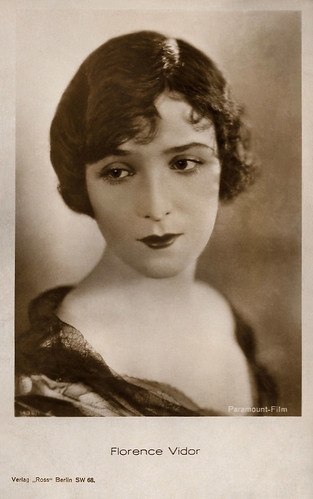
German postcard by Ross Verlag, no. 1435/1, 1927-1928. Photo: Paramount-Film.
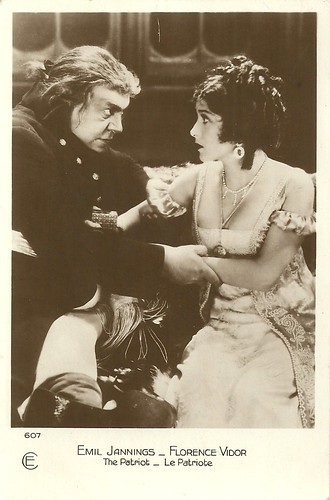
French postcard by Cinémagazine-Edition, no. 607. Emil Jannings and Florence Vidor in The Patriot (Ernst Lubitsch, 1928).
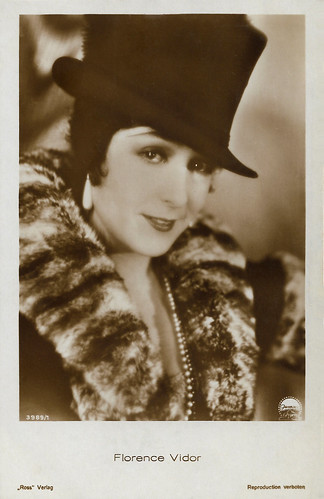
German postcard by Ross Verlag, no. 3989/1, 1928-1929. Photo: Paramount.
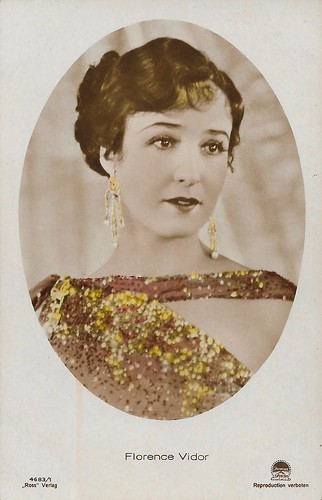
German postcard by Ross Verlag, no. 4683/1, 1929-1930. Photo: Paramount. See also this postcard, Vidor wears the same dress.
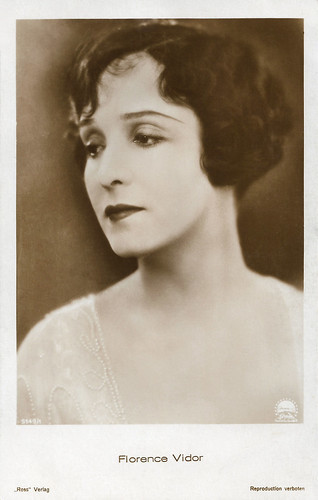
German postcard by Ross Verlag, no. 5149/1, 1930-1931. Photo: Paramount.
In silent films through the influence of her husband
Florence Vidor was born Florence Cobb in Texas in 1895, the child of John and Ida Cobb. Her parents had married in Houston in 1894 but they divorced only three years later. Ida remained in Houston and soon married John P. Arto, a real estate man who later served as deputy chief of the city's fire department.
Florence Vidor started working in silent films through the influence of her husband, film director King Vidor, whom she had married in 1915. She signed her first contract with Vitagraph Studios in 1916 and became known for her part in the Charles Dickens adaptation A Tale of Two Cities (Frank Lloyd, 1917).
At Jesse Lasky/Paramount, Vidor was paired with Sessue Hayakawa in several films such as The Secret Game (William C. de Mille, 1917), and with crossdresser Julian Eltinge, such as The Countess Charming (Donald Crisp, 1917).
From 1919, King Vidor also directed her at his own studio, Vidor Village, in films such as The Other Half (1919), Conquering the Woman (1922), and most memorable, Alice Adams (1923).
A touching melodrama was the Thomas Ince production Hail the Woman (John Griffith Wray, 1921), which when found and restored in recent years still emoted audiences.

French postcard by Cinémagazine-Édition, Paris, no. 65. Photo: Paramount.
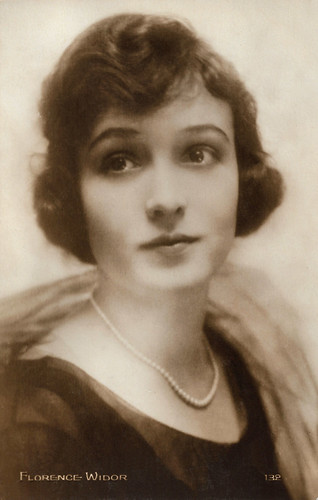
French postcard by Editions Cinémagazine, no. 132.
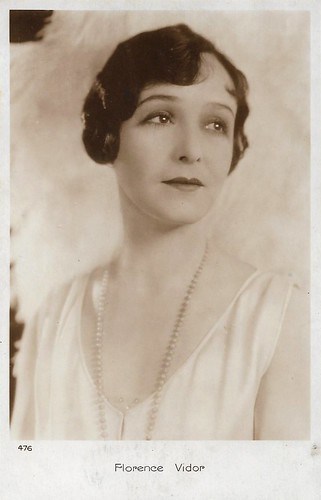
French postcard by Cinémagazine-Edition, Paris, no. 476.
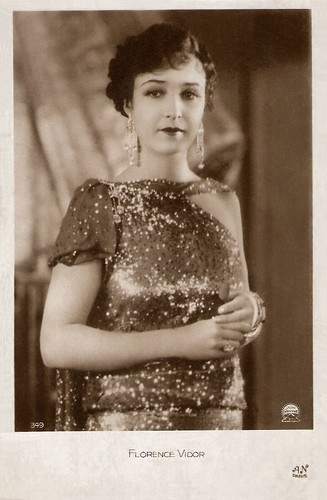
French postcard by A.N., Paris, no. 349. Photo: Paramount.
A major box office attraction for Paramount
Throughout the 1920s, Florence Vidor was a major box office attraction for Paramount Pictures. Her forte was sophisticated comedies. Memorable was the witty comedy The Marriage Circle (1924) by Ernst Lubitsch , also with Monte Blue , Creighton Hale, Adolphe Menjou , and Marie Prevost . Lubitsch directed her again in the Emil Jannings vehicle The Patriot (1928).
Also memorable were The Grandduchess and the Waiter (Malcolm St. Clair, 1926) with again Adolphe Menjou , and The Magnificent Flirt (Harry d'Abbadie d'Arrast, 1928) with Loretta Young. Yet, Vidor's performance with Gary Cooper in Doomsday (Rowland V. Lee, 1928) was less successful.
Florence Vidor's career ended with the advent of sound films. In 1929 she became so frustrated by the difficulties of making the partial sound film Chinatown Nights that she retired from acting before the production was completed. Director William A. Wellman had to use a voice double to complete some of her scenes.
Florence and King Vidor divorced in 1924. Their marriage produced a daughter, Suzanne (1918–2003). Despite the end of their marriage, Florence continued to use Vidor as her surname.
In 1926, she married classical violinist Jascha Heifetz. They had two children together and Heifetz also adopted Suzanne before divorcing in 1945. Florence Vidor died in California in 1977. She was 82.
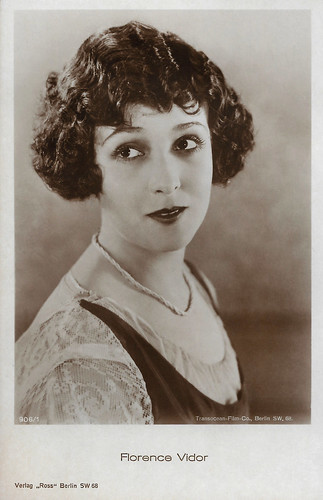
German postcard by Ross Verlag, Berlin, no. 906/1, 1925-1926. Photo: Transocean-Film-Co., Berlin.
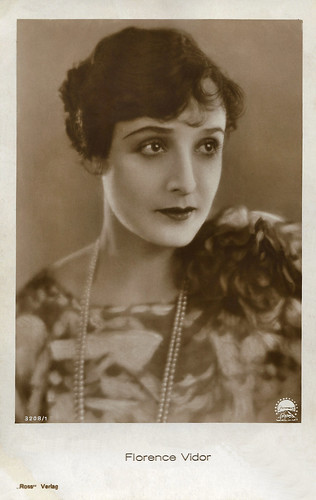
German postcard by Ross Verlag, no. 3208/1, 1928-1929. Photo: Paramount.
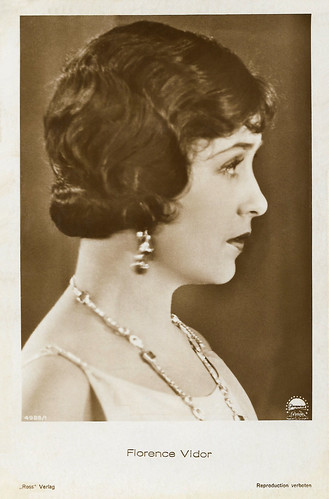
German postcard by Ross Verlag, no. 4988/1, 1929-1930. Photo: Paramount Pictures.

German postcard by Ross Verlag, no. 5149/1, 1930-1931. Photo: Paramount.
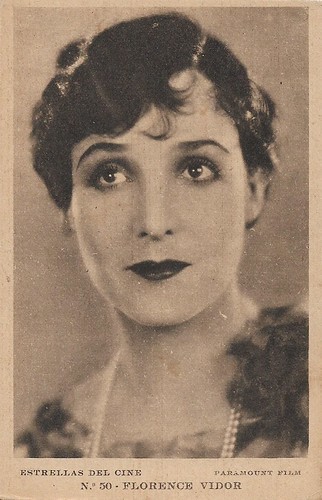
Spanish postcard in the Estrellas del cine series by Editorial Grafica, Barcelona, no. 50. Photo: Paramount Film.
Sources: (IMDb), Wikipedia (English, French, and German), and .

German postcard by Ross Verlag, no. 1435/1, 1927-1928. Photo: Paramount-Film.

French postcard by Cinémagazine-Edition, no. 607. Emil Jannings and Florence Vidor in The Patriot (Ernst Lubitsch, 1928).

German postcard by Ross Verlag, no. 3989/1, 1928-1929. Photo: Paramount.

German postcard by Ross Verlag, no. 4683/1, 1929-1930. Photo: Paramount. See also this postcard, Vidor wears the same dress.

German postcard by Ross Verlag, no. 5149/1, 1930-1931. Photo: Paramount.
In silent films through the influence of her husband
Florence Vidor was born Florence Cobb in Texas in 1895, the child of John and Ida Cobb. Her parents had married in Houston in 1894 but they divorced only three years later. Ida remained in Houston and soon married John P. Arto, a real estate man who later served as deputy chief of the city's fire department.
Florence Vidor started working in silent films through the influence of her husband, film director King Vidor, whom she had married in 1915. She signed her first contract with Vitagraph Studios in 1916 and became known for her part in the Charles Dickens adaptation A Tale of Two Cities (Frank Lloyd, 1917).
At Jesse Lasky/Paramount, Vidor was paired with Sessue Hayakawa in several films such as The Secret Game (William C. de Mille, 1917), and with crossdresser Julian Eltinge, such as The Countess Charming (Donald Crisp, 1917).
From 1919, King Vidor also directed her at his own studio, Vidor Village, in films such as The Other Half (1919), Conquering the Woman (1922), and most memorable, Alice Adams (1923).
A touching melodrama was the Thomas Ince production Hail the Woman (John Griffith Wray, 1921), which when found and restored in recent years still emoted audiences.

French postcard by Cinémagazine-Édition, Paris, no. 65. Photo: Paramount.

French postcard by Editions Cinémagazine, no. 132.

French postcard by Cinémagazine-Edition, Paris, no. 476.

French postcard by A.N., Paris, no. 349. Photo: Paramount.
A major box office attraction for Paramount
Throughout the 1920s, Florence Vidor was a major box office attraction for Paramount Pictures. Her forte was sophisticated comedies. Memorable was the witty comedy The Marriage Circle (1924) by Ernst Lubitsch , also with Monte Blue , Creighton Hale, Adolphe Menjou , and Marie Prevost . Lubitsch directed her again in the Emil Jannings vehicle The Patriot (1928).
Also memorable were The Grandduchess and the Waiter (Malcolm St. Clair, 1926) with again Adolphe Menjou , and The Magnificent Flirt (Harry d'Abbadie d'Arrast, 1928) with Loretta Young. Yet, Vidor's performance with Gary Cooper in Doomsday (Rowland V. Lee, 1928) was less successful.
Florence Vidor's career ended with the advent of sound films. In 1929 she became so frustrated by the difficulties of making the partial sound film Chinatown Nights that she retired from acting before the production was completed. Director William A. Wellman had to use a voice double to complete some of her scenes.
Florence and King Vidor divorced in 1924. Their marriage produced a daughter, Suzanne (1918–2003). Despite the end of their marriage, Florence continued to use Vidor as her surname.
In 1926, she married classical violinist Jascha Heifetz. They had two children together and Heifetz also adopted Suzanne before divorcing in 1945. Florence Vidor died in California in 1977. She was 82.

German postcard by Ross Verlag, Berlin, no. 906/1, 1925-1926. Photo: Transocean-Film-Co., Berlin.

German postcard by Ross Verlag, no. 3208/1, 1928-1929. Photo: Paramount.

German postcard by Ross Verlag, no. 4988/1, 1929-1930. Photo: Paramount Pictures.

German postcard by Ross Verlag, no. 5149/1, 1930-1931. Photo: Paramount.

Spanish postcard in the Estrellas del cine series by Editorial Grafica, Barcelona, no. 50. Photo: Paramount Film.
Sources: (IMDb), Wikipedia (English, French, and German), and .
Published on February 17, 2021 22:00
February 16, 2021
Recently acquired: Dutch pop stars of the 1960s
Recently, we found on British eBay a series of great postcards of Dutch pop artists of the 1960s. All were published by 't Sticht, a publisher from the city of Utrecht, which later emerged with another postcard publisher from Utrecht, Takken. We were kids when these postcards were published and the stars on them would become legends and their songs evergreens, anyway in the Netherlands. So this post is a happy, sentimental journey for us, and we do hope you'll enjoy it too.
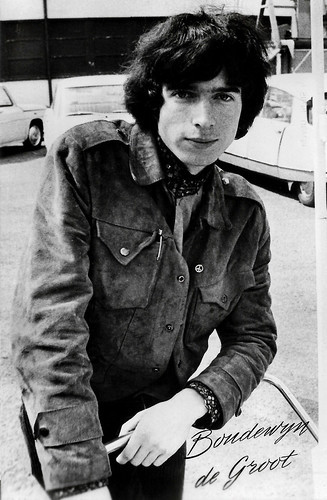
Dutch postcard by 't Sticht, Utrecht, no. AX 6631.
Dutch singer, songwriter, and actor Boudewijn de Groot (1944) is known as a troubadour with a Dylan-esque impact. In the 1960s and 1970s, he shot to fame in the Netherlands and Belgium with hits like 'Welterusten Meneer De President' (Goodnight Mr. President), 'Het Land Van Maas En Waal' (The Land Of Meuse And Waal), and 'Jimmy' (1973). In the 1980s he started a new career as a composer of film music and as an actor. In the late 1990s, he made a very successful comeback.
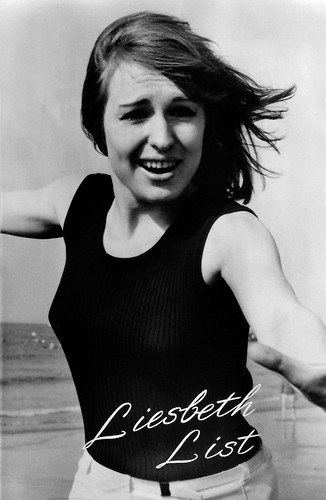
Dutch postcard, 1967 by 't Sticht, Utrecht, no. AX 6305.
Dutch singer and actress Liesbeth List (1941) passed away last year, on 25 March 2020. List was known as the Grande Dame of the Dutch chanson, thanks to songs like 'Pastorale', 'Aan de andere kant van de heuvels' (On the other side of the hills), and 'Kinderen een kwartje' (Children a quarter). She became popular during the 1960s and frequently collaborated with Ramses Shaffy. List sang Jacques Brel's chansons in a Dutch translation, and also acted in a few Dutch films.
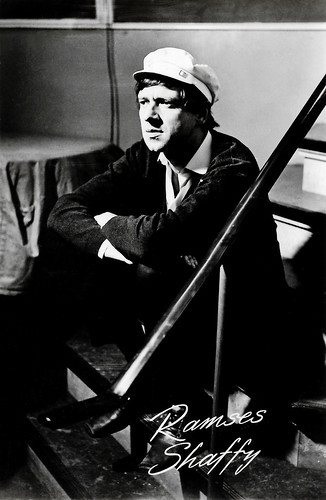
Dutch postcard by Uitg. 't Sticht, Utrecht, no. AX 6783. Photo: Philips grammofoonplaten (Philips records).
French-Dutch singer and actor Ramses Shaffy (1933-2009) is an icon of the Dutch entertainment world. He became popular during the 1960s. His most famous songs include 'Zing, vecht, huil, bid, lach, werk en bewonder' (Sing, fight, cry, pray, laugh, work and admire), 'We zullen doorgaan' (We shall go on), 'Pastorale' (Sun and Moon), 'Sammy' and 'Laat me' (Let me). He frequently collaborated with Dutch singer Liesbeth List. About his career and life, both a musical and a TV series were produced.
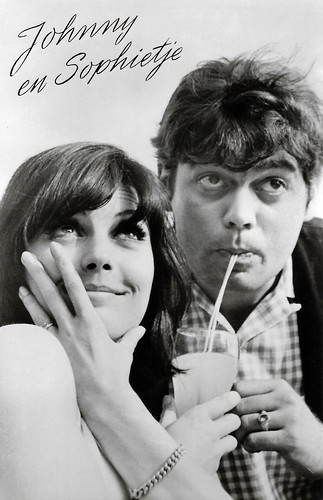
Dutch postcard by 't Sticht, Utrecht, no. AX 6430. Photo: Philips grammofoonplaten (Philips Records).
From 1959 on, Dutch singer and actor Johnny Lion (1941-2019) had success with his band the Jumping Jewels. Solo, he had single luck with the evergreen 'Sophietje' which he wrote for his girlfriend, Dutch model Sophie van Kleef. Johnny also appeared in some Dutch films.
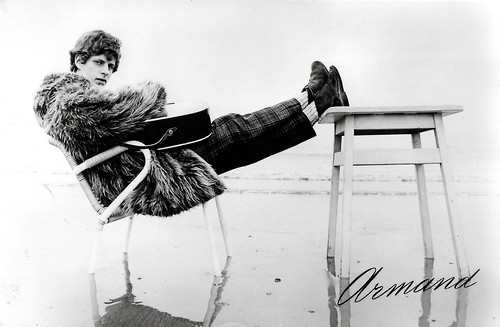
Dutch postcard by 't Sticht, Utrecht, no. AX 6881. Photo: Fontana.
Dutch protest singer Armand (1946-2015) was known as 'the Dutch Bob Dylan'. Armand came to the fore during the hippie generation and was well known as an advocate of cannabis. His greatest hit song was 'Ben ik te min' (Am I not good enough?) in 1967. During a career lasting fifty years, Armand wrote and recorded at least eleven solo studio albums and dozens of singles.
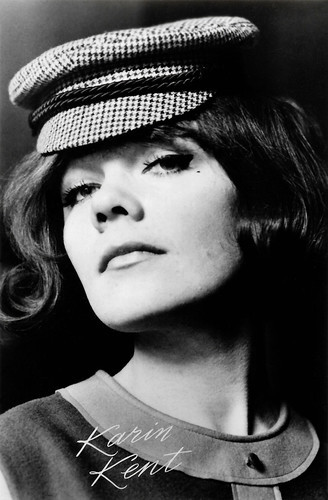
Dutch postcard by 't Sticht, Utrecht, no. AX 6853.
Karin Kent (1943) was a Dutch pop singer, who was very popular in the Netherlands during the late 1960s thanks to such smash hits as 'Dans je de hele nacht met mij?' (Do you dance all night with me?).

Dutch postcard by 't Sticht, Utrecht, no. AX 6877. Photo: Decca. Boudewijn de Groot.
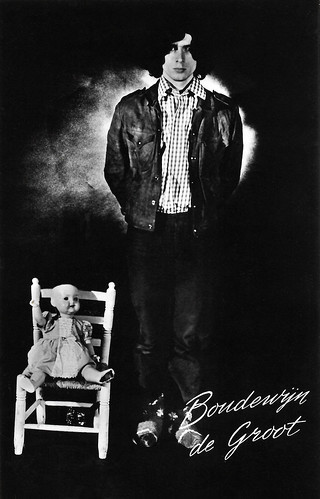
Dutch postcard by 't Sticht, Utrecht, no. AX 6939. Boudewijn de Groot.
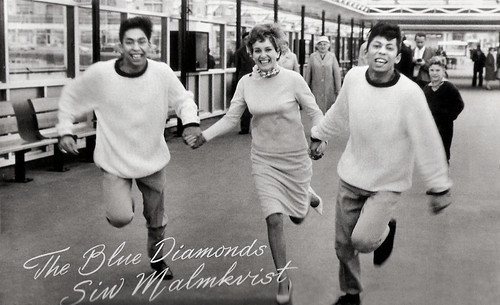
Dutch postcard by Takken, Utrecht / 't Sticht, no. AX 4822. Photo: NV Phonogram, Amsterdam.
Swedish Siw Malmkvist (1936) is a popular pop/schlager singer in Scandinavia and Germany. ‘Siwan’ was the first Swede with a hit on the US Billboard chart with 'Sole Sole Sole', a duet with Umberto Marcato. Malmkvist is a performer with great versatility, and she performed in stage plays, musicals and films.
Dutch-Indonesian brothers Riem de Wolff (1943-2017) and Ruud de Wolff (1941-2000) formed The Blue Diamonds , one of the most successful Dutch pop acts ever. Their hit song 'Ramona' became an evergreen. Incidentally, the brothers also acted in films and on TV.
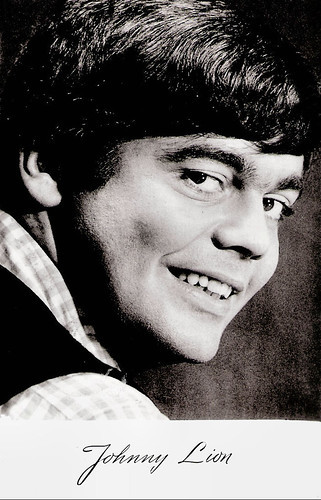
Dutch postcard by 't Sticht, Utrecht. Photo: Philips grammofoonplaten. Sent by mail in 1965. Johnny Lion once more.
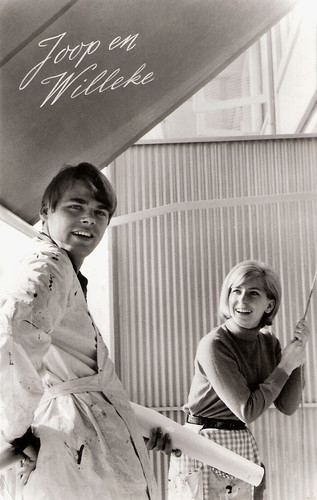
Dutch postcard by 't Sticht, Utrecht, no. 658.
For more than 60 years now Willeke Alberti (1945) is a very popular singer in the Netherlands. During the 1960s she was a teen idol with several #1 hits. Later she starred as an actress on stage, on TV, and in popular films. Through the years, Alberti has become embraced in the Netherlands as a gay icon, due to a combination of her song repertoire, her durability, and her performances in support of manifold (gay) causes. Her first husband was musician Joop Oonk, best known for the band Jumping Jewels.
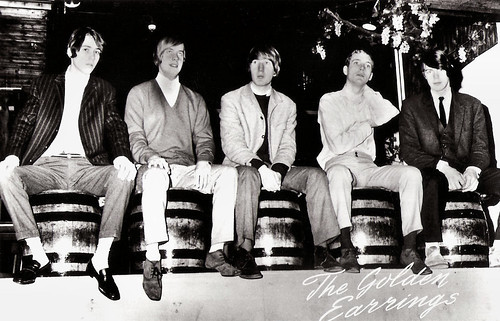
Dutch postcard by 't Sticht, Utrecht, no. AX 6580. The Golden Earrings (later Golden Earring) with left George Kooijmans and right Rinus Gerritsen, but in between?
Golden Earring is a Dutch rock band, founded in 1961 in The Hague as the Golden Earrings (the 's' was dropped in 1969). They achieved worldwide fame with their hits 'Radar Love' (1973), 'Twilight Zone' (1982), and 'When the Lady Smiles' (1984). Recently, George Kooyman has been diagnosed with the muscle disease ALS, and sadly, that means the end of the band performing. During their career, Golden Earring had nearly 30 top-ten singles on the Dutch charts, and over the years they produced 25 studio albums.
For more Dutch pop star postcards check out our Flickr album Dutch Pop Stars or for postcards of international pop stars check out the album Vintage pop stars .

Dutch postcard by 't Sticht, Utrecht, no. AX 6631.
Dutch singer, songwriter, and actor Boudewijn de Groot (1944) is known as a troubadour with a Dylan-esque impact. In the 1960s and 1970s, he shot to fame in the Netherlands and Belgium with hits like 'Welterusten Meneer De President' (Goodnight Mr. President), 'Het Land Van Maas En Waal' (The Land Of Meuse And Waal), and 'Jimmy' (1973). In the 1980s he started a new career as a composer of film music and as an actor. In the late 1990s, he made a very successful comeback.

Dutch postcard, 1967 by 't Sticht, Utrecht, no. AX 6305.
Dutch singer and actress Liesbeth List (1941) passed away last year, on 25 March 2020. List was known as the Grande Dame of the Dutch chanson, thanks to songs like 'Pastorale', 'Aan de andere kant van de heuvels' (On the other side of the hills), and 'Kinderen een kwartje' (Children a quarter). She became popular during the 1960s and frequently collaborated with Ramses Shaffy. List sang Jacques Brel's chansons in a Dutch translation, and also acted in a few Dutch films.

Dutch postcard by Uitg. 't Sticht, Utrecht, no. AX 6783. Photo: Philips grammofoonplaten (Philips records).
French-Dutch singer and actor Ramses Shaffy (1933-2009) is an icon of the Dutch entertainment world. He became popular during the 1960s. His most famous songs include 'Zing, vecht, huil, bid, lach, werk en bewonder' (Sing, fight, cry, pray, laugh, work and admire), 'We zullen doorgaan' (We shall go on), 'Pastorale' (Sun and Moon), 'Sammy' and 'Laat me' (Let me). He frequently collaborated with Dutch singer Liesbeth List. About his career and life, both a musical and a TV series were produced.

Dutch postcard by 't Sticht, Utrecht, no. AX 6430. Photo: Philips grammofoonplaten (Philips Records).
From 1959 on, Dutch singer and actor Johnny Lion (1941-2019) had success with his band the Jumping Jewels. Solo, he had single luck with the evergreen 'Sophietje' which he wrote for his girlfriend, Dutch model Sophie van Kleef. Johnny also appeared in some Dutch films.

Dutch postcard by 't Sticht, Utrecht, no. AX 6881. Photo: Fontana.
Dutch protest singer Armand (1946-2015) was known as 'the Dutch Bob Dylan'. Armand came to the fore during the hippie generation and was well known as an advocate of cannabis. His greatest hit song was 'Ben ik te min' (Am I not good enough?) in 1967. During a career lasting fifty years, Armand wrote and recorded at least eleven solo studio albums and dozens of singles.

Dutch postcard by 't Sticht, Utrecht, no. AX 6853.
Karin Kent (1943) was a Dutch pop singer, who was very popular in the Netherlands during the late 1960s thanks to such smash hits as 'Dans je de hele nacht met mij?' (Do you dance all night with me?).

Dutch postcard by 't Sticht, Utrecht, no. AX 6877. Photo: Decca. Boudewijn de Groot.

Dutch postcard by 't Sticht, Utrecht, no. AX 6939. Boudewijn de Groot.

Dutch postcard by Takken, Utrecht / 't Sticht, no. AX 4822. Photo: NV Phonogram, Amsterdam.
Swedish Siw Malmkvist (1936) is a popular pop/schlager singer in Scandinavia and Germany. ‘Siwan’ was the first Swede with a hit on the US Billboard chart with 'Sole Sole Sole', a duet with Umberto Marcato. Malmkvist is a performer with great versatility, and she performed in stage plays, musicals and films.
Dutch-Indonesian brothers Riem de Wolff (1943-2017) and Ruud de Wolff (1941-2000) formed The Blue Diamonds , one of the most successful Dutch pop acts ever. Their hit song 'Ramona' became an evergreen. Incidentally, the brothers also acted in films and on TV.

Dutch postcard by 't Sticht, Utrecht. Photo: Philips grammofoonplaten. Sent by mail in 1965. Johnny Lion once more.

Dutch postcard by 't Sticht, Utrecht, no. 658.
For more than 60 years now Willeke Alberti (1945) is a very popular singer in the Netherlands. During the 1960s she was a teen idol with several #1 hits. Later she starred as an actress on stage, on TV, and in popular films. Through the years, Alberti has become embraced in the Netherlands as a gay icon, due to a combination of her song repertoire, her durability, and her performances in support of manifold (gay) causes. Her first husband was musician Joop Oonk, best known for the band Jumping Jewels.

Dutch postcard by 't Sticht, Utrecht, no. AX 6580. The Golden Earrings (later Golden Earring) with left George Kooijmans and right Rinus Gerritsen, but in between?
Golden Earring is a Dutch rock band, founded in 1961 in The Hague as the Golden Earrings (the 's' was dropped in 1969). They achieved worldwide fame with their hits 'Radar Love' (1973), 'Twilight Zone' (1982), and 'When the Lady Smiles' (1984). Recently, George Kooyman has been diagnosed with the muscle disease ALS, and sadly, that means the end of the band performing. During their career, Golden Earring had nearly 30 top-ten singles on the Dutch charts, and over the years they produced 25 studio albums.
For more Dutch pop star postcards check out our Flickr album Dutch Pop Stars or for postcards of international pop stars check out the album Vintage pop stars .
Published on February 16, 2021 22:00
February 15, 2021
Sergio Tòfano
Italian actor Sergio Tòfano (1886-1973) was also a director, playwright, scene designer, and illustrator. In 1917 he invented for a children's magazine the character Signor Bonaventura, whose adventures lasted for more than forty years. Credited as Sto, he made illustrations for many Italian magazines.
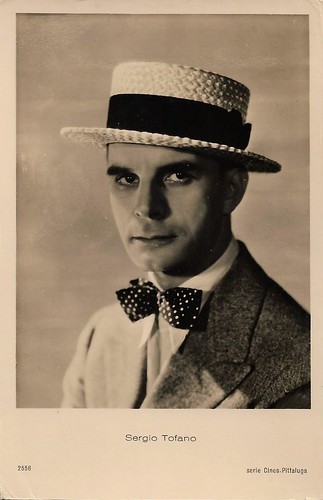
Italian postcard in the Series Cines-Pittaluga, Rome, no. 2556.
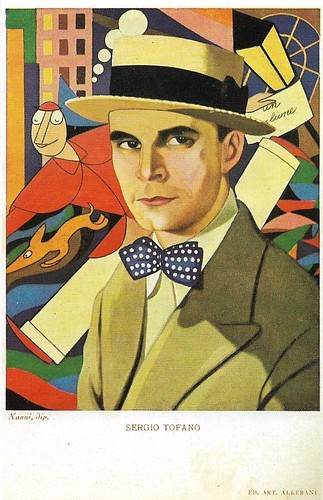
Italian postcard by Ed. Art. Alberani. Painting: Nanni. Behind Tofano the character of Signor Buonaventura, Tofano's creation.
Creator of Signor Bonaventura
Sergio Tòfano was born in Rome, Italy, in 1886.
In 1909, he made his first appearance on stage with Ermete Novelli , then joined Virgilio Talli's company (1912–23). He soon specialised as a comic actor, giving his role a new elegance and complexity.
He interpreted works of multiple authors going from Molnár to G.B. Shaw, from Jules Romains to Luigi Pirandello, from Machiavelli to Molière, from Anton Checkov to Henrik Ibsen, Kaiser, an Bertolt Brecht.
In 1917 Sergio Tòfano invented, for a children's magazine, Il Corriere dei Piccoli, a famous character, Signor Bonaventura, whose adventures lasted for more than forty years. He used to sign as Sto. He wrote and illustrated several children's books and illustrated 'The Chess Set in the Mirror' by Massimo Bontempelli.
In 1924-1926, Tofano worked with the director and playwright Dario Niccodemi, and in 1927-1930 with Luigi Almirante and Giuditta Rissone, co-acting with Elsa Merlini , Vittorio De Sica , Evi Maltagliati , Gino Cervi, and many others.
During those years, he made his memorable performances as Doctor Knock in Jules Romains' homonymous play, and as Professor Toti in Luigi Pirandello's 'Pensaci, Giacomino!'. He also led important theatrical firms. After the Second World War, he worked with the most important innovative stage directors such as Luchino Visconti and Giorgio Strehler.
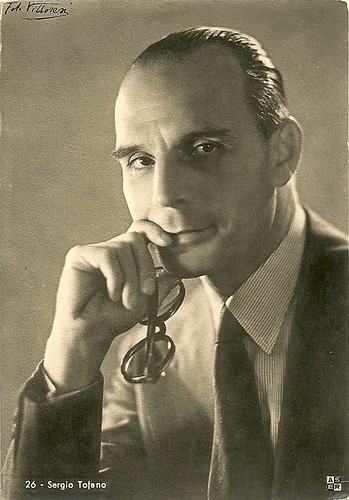
Italian postcard by ASER (A. Scarmiglia Ed., Roma), no. 26. Photo: Villoresi.
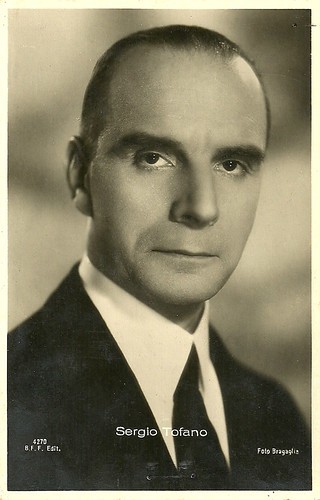
Italian postcard by B.F.F. Edit., no. 4270. Photo: Bragaglia.
Stealing the show in The Cherry Orchard
After a one-off performance in the silent film Tigrana (Edouard Micheroux de Dillon, 1916), Sergio Tòfano's film acting career really set off with his part of the usher Otello in the comedy La segretaria privata/The Private Secretary (Goffredo Alessandrini, 1931), starring Elsa Merlini and Nino Besozzi.
Many other comedies at Cines-Pittaluga followed in the early 1930s, such as La telefonista/The Telephone Operator (Nunzio Malasomma, 1932) with Isa Pola and Paprika (Carl Boese, 1933) with Elsa Merlini , while he had the lead in O la borsa, o la vita/Your Money or Your Life (Carlo Ludovico Bragaglia, 1933) and in Seconda B (Goffredo Alessandrini, 1934).
Over the years, Tofano would work with a wide range of directors such as Mario Mattoli, Luigi Comencini, Pasquale Festa Campanile, Nanni Loy, Bernardo Bertolucci and Mario Monicelli.He would also direct two films, Cenerentola e il Signor Bonaventura/Princess Cinderella (1941), based on the characters of his popular comic strip series Signor Bonaventura and shot at the Pisorno studios in Tirrenia, and Gian Burrasca (1943).
From the start of television in Italy, Tofano acted in teleplays in the 1950s and 1960s such as Orgoglio e pregiudizio/Pride and Prejudice (1957), L'idiota/The idiot (1959), Mastro don Gesualdo (1964), Il conte di Montecristo/The Count of Monte Cristo (1966), I promessi sposi/The Betrothed (1967), Le mie prigioni/My prisons (1968), after the eponymous novel by Silvio Pellico, and I fratelli Karamazov/The Brothers Karamazov (1969), plus two performances in the crime series Le inchieste del commissario Maigret/The Investigations by Commissioner Maigret (1965-1968).
Sergio Tòfano married actress Rosetta Cavallari (1902-1960) in 1923. They had a son, Gilberto Tofano, later a stage and TV director. In 1953 Tofano started teaching at the Roman theatre academy. After his retirement in 1960, he continued to teach and to play parts on television. In the same year, his wife, who suffered from depressions, killed herself. In 1973 Tofano died himself, in Rome, at the age of 87. He was buried at the family tomb in Milan, next to his wife.
In his text on Tofano, Sergio Romano remembered in Corriere della Sera (2012), how impressive Tofano's part had been of the old servant Firs in the final scene of 'The Cherry Orchard', directed by Luchino Visconti in 1965, one of Tofano's last stage performances. "But on the almost empty stage appeared Firs, forgotten by those to whom he had dedicated his life. In those few last minutes, while laying down on a sofa, he remembered the past and mumbled his last sentences. Tofano stole the show from Paolo Stoppa , Rina Morelli, Massimo Girotti , Lucilla Morlacchi, Ottavia Piccolo. At that moment the applause and some tears too were all for him."
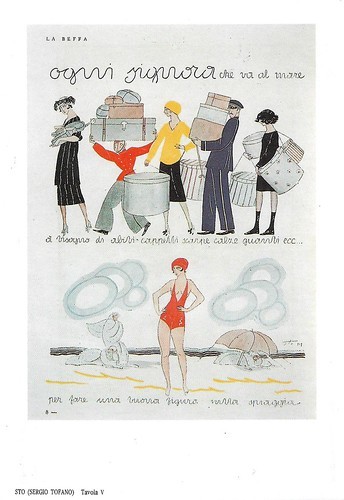
Italian postcard by Stampa alternativa nuovo equilibri, Tavola V. Reprint of an old magazine illustration by Sto (Sergio Tofano) 'Ogni signora che va al mare [a bisogno di abiti, cappelli, scarpe, calze, guanti ecc. per fare una nuova figura sulla spiaggia]', Satana-Beffa 22, Milano 1919.
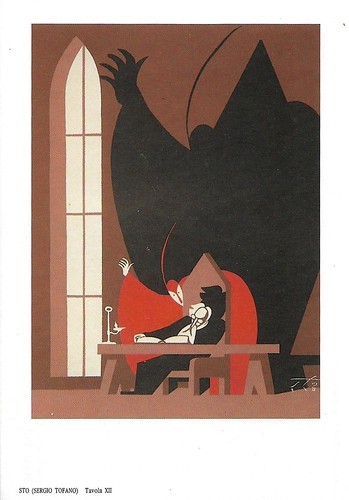
Italian postcard by Stampa alternativa nuovo equilibri, Tavola XII. Reprint of old magazine illustration by Sto (Sergio Tofano), 'Faust', in Il Cantastorie di Campari, Milano, 1928.
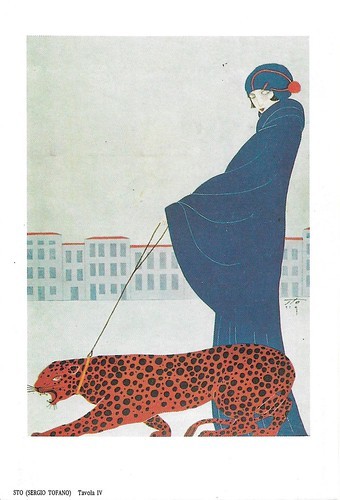
Italian postcard by Stampa alternativa nuovo equilibri, Tavola IV. Reprint of old magazine illustration by Sto (Sergio Tofano), 'Lady with leopard', in Lidel 17, Milano 1919. The picture must refer to fashion icon Marchesa Luisa Casati who lived in Venice between 1910 and 1919 and famously posed with a pet leopard.
Sources: Lungomarecastiglioncello, Wikipedia (English and Italian), and .

Italian postcard in the Series Cines-Pittaluga, Rome, no. 2556.

Italian postcard by Ed. Art. Alberani. Painting: Nanni. Behind Tofano the character of Signor Buonaventura, Tofano's creation.
Creator of Signor Bonaventura
Sergio Tòfano was born in Rome, Italy, in 1886.
In 1909, he made his first appearance on stage with Ermete Novelli , then joined Virgilio Talli's company (1912–23). He soon specialised as a comic actor, giving his role a new elegance and complexity.
He interpreted works of multiple authors going from Molnár to G.B. Shaw, from Jules Romains to Luigi Pirandello, from Machiavelli to Molière, from Anton Checkov to Henrik Ibsen, Kaiser, an Bertolt Brecht.
In 1917 Sergio Tòfano invented, for a children's magazine, Il Corriere dei Piccoli, a famous character, Signor Bonaventura, whose adventures lasted for more than forty years. He used to sign as Sto. He wrote and illustrated several children's books and illustrated 'The Chess Set in the Mirror' by Massimo Bontempelli.
In 1924-1926, Tofano worked with the director and playwright Dario Niccodemi, and in 1927-1930 with Luigi Almirante and Giuditta Rissone, co-acting with Elsa Merlini , Vittorio De Sica , Evi Maltagliati , Gino Cervi, and many others.
During those years, he made his memorable performances as Doctor Knock in Jules Romains' homonymous play, and as Professor Toti in Luigi Pirandello's 'Pensaci, Giacomino!'. He also led important theatrical firms. After the Second World War, he worked with the most important innovative stage directors such as Luchino Visconti and Giorgio Strehler.

Italian postcard by ASER (A. Scarmiglia Ed., Roma), no. 26. Photo: Villoresi.

Italian postcard by B.F.F. Edit., no. 4270. Photo: Bragaglia.
Stealing the show in The Cherry Orchard
After a one-off performance in the silent film Tigrana (Edouard Micheroux de Dillon, 1916), Sergio Tòfano's film acting career really set off with his part of the usher Otello in the comedy La segretaria privata/The Private Secretary (Goffredo Alessandrini, 1931), starring Elsa Merlini and Nino Besozzi.
Many other comedies at Cines-Pittaluga followed in the early 1930s, such as La telefonista/The Telephone Operator (Nunzio Malasomma, 1932) with Isa Pola and Paprika (Carl Boese, 1933) with Elsa Merlini , while he had the lead in O la borsa, o la vita/Your Money or Your Life (Carlo Ludovico Bragaglia, 1933) and in Seconda B (Goffredo Alessandrini, 1934).
Over the years, Tofano would work with a wide range of directors such as Mario Mattoli, Luigi Comencini, Pasquale Festa Campanile, Nanni Loy, Bernardo Bertolucci and Mario Monicelli.He would also direct two films, Cenerentola e il Signor Bonaventura/Princess Cinderella (1941), based on the characters of his popular comic strip series Signor Bonaventura and shot at the Pisorno studios in Tirrenia, and Gian Burrasca (1943).
From the start of television in Italy, Tofano acted in teleplays in the 1950s and 1960s such as Orgoglio e pregiudizio/Pride and Prejudice (1957), L'idiota/The idiot (1959), Mastro don Gesualdo (1964), Il conte di Montecristo/The Count of Monte Cristo (1966), I promessi sposi/The Betrothed (1967), Le mie prigioni/My prisons (1968), after the eponymous novel by Silvio Pellico, and I fratelli Karamazov/The Brothers Karamazov (1969), plus two performances in the crime series Le inchieste del commissario Maigret/The Investigations by Commissioner Maigret (1965-1968).
Sergio Tòfano married actress Rosetta Cavallari (1902-1960) in 1923. They had a son, Gilberto Tofano, later a stage and TV director. In 1953 Tofano started teaching at the Roman theatre academy. After his retirement in 1960, he continued to teach and to play parts on television. In the same year, his wife, who suffered from depressions, killed herself. In 1973 Tofano died himself, in Rome, at the age of 87. He was buried at the family tomb in Milan, next to his wife.
In his text on Tofano, Sergio Romano remembered in Corriere della Sera (2012), how impressive Tofano's part had been of the old servant Firs in the final scene of 'The Cherry Orchard', directed by Luchino Visconti in 1965, one of Tofano's last stage performances. "But on the almost empty stage appeared Firs, forgotten by those to whom he had dedicated his life. In those few last minutes, while laying down on a sofa, he remembered the past and mumbled his last sentences. Tofano stole the show from Paolo Stoppa , Rina Morelli, Massimo Girotti , Lucilla Morlacchi, Ottavia Piccolo. At that moment the applause and some tears too were all for him."

Italian postcard by Stampa alternativa nuovo equilibri, Tavola V. Reprint of an old magazine illustration by Sto (Sergio Tofano) 'Ogni signora che va al mare [a bisogno di abiti, cappelli, scarpe, calze, guanti ecc. per fare una nuova figura sulla spiaggia]', Satana-Beffa 22, Milano 1919.

Italian postcard by Stampa alternativa nuovo equilibri, Tavola XII. Reprint of old magazine illustration by Sto (Sergio Tofano), 'Faust', in Il Cantastorie di Campari, Milano, 1928.

Italian postcard by Stampa alternativa nuovo equilibri, Tavola IV. Reprint of old magazine illustration by Sto (Sergio Tofano), 'Lady with leopard', in Lidel 17, Milano 1919. The picture must refer to fashion icon Marchesa Luisa Casati who lived in Venice between 1910 and 1919 and famously posed with a pet leopard.
Sources: Lungomarecastiglioncello, Wikipedia (English and Italian), and .
Published on February 15, 2021 22:00
February 14, 2021
Kate Beckinsale
English actress Kate Beckinsale (1973) started her career in British costume dramas during the 1990s. From 2001 on, she starred in such Hollywood blockbusters as Pearl Harbor (2001), Van Helsing (2003), and The Aviator (2004). After her role as Selene in the Underworld film series (2003–2016), Beckinsale is also known for her work in action films.
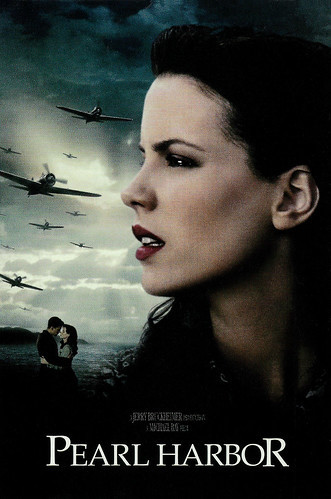
Australian postcard by Avant Card, no. 3 in a series of 5. Photo: Jerry Bruckheimer Films / Buena Vista International / Touchstone Pictures. Kate Beckinsale in Pearl Harbor (Michael Bay, 2001).
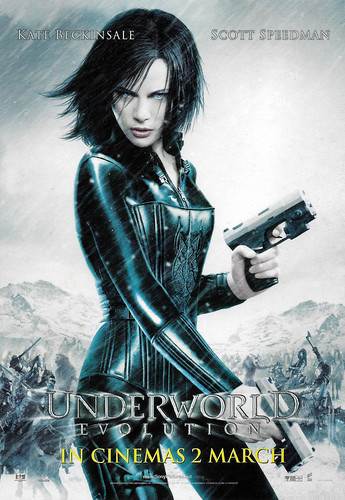
British postcard by Arcards. Photo: Sony Pictures. Kate Beckinsale in Underworld: Evolution (Len Wiseman, 2006).
A tumultuous adolescence
Kate Beckinsale was born in 1973 in Finsbury Park, London, or in Hounslow, Middlesex, England (the sources differ). However, she has resided in London for most of her life.
Her mother is actress Judy Loe, and her father was actor Richard Beckinsale, who starred in popular British television comedies during the 1970s. He passed away tragically early in 1979 at the age of 31. Kate is the younger half-sister of actress Samantha Beckinsale.
Kate attended the private school Godolphin and Latymer School in London for her grade and primary school education. In her teens, she twice won the British bookseller W.H. Smith Young Writers' competition - once for three short stories and once for three poems. After a tumultuous adolescence (including a bout of anorexia), she gradually took up the profession of acting.
Her major acting debut came in the TV film One Against the Wind (Larry Elikann, 1991), about World War II. Kate began attending Oxford University's New College in the fall of 1991, majoring in French and Russian literature. She had already decided that she wanted to act, but to broaden her horizons she chose university over drama school.
While in her first year at Oxford, Kate received her big break in the film adaptation of William Shakespeare's Much Ado About Nothing (Kenneth Branagh, 1993). Kate worked in three other films while attending Oxford, beginning with a part in the medieval historical drama Prince of Jutland (Gabriel Axel, 1994), starring Christian Bale, Gabriel Byrne, and Helen Mirren. The film was shot during the spring of 1993 on location in Denmark, and she filmed her supporting part during New College's Easter break.
Later in the summer of that year, she played the lead in the thriller Uncovered (Jim McBride, 1994). Before she went back to school, her third year at university was spent at Oxford's study-abroad program in Paris. This year caused her to re-evaluate the direction of her life. She faced a choice: continue with school or concentrate on her flourishing acting career. After much thought, she chose an acting career. In the spring of 1994, Kate left Oxford, after finishing three years of study.
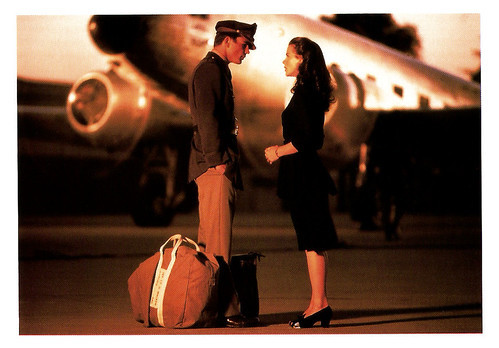
German postcard by Edgar Medien AG. Photo: Touchstone Pictures / Bueno Vista International. Kate Beckinsale and Josh Hartnett in Pearl Harbor (Michael Bay, 2001).
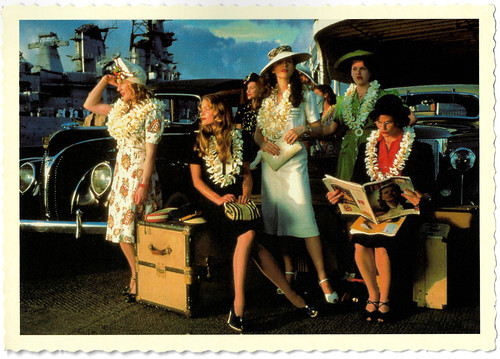
German postcard by Edgar Medien AG. Photo: Touchstone Pictures / Bueno Vista International. Kate Beckinsale in Pearl Harbor (Michael Bay, 2001).
Playing an object of desire
Kate Beckinsale appeared in the BBC/Thames Television costume comedy Cold Comfort Farm (John Schlesinger, 1995), which later opened in American cinemas to spectacular reviews, grossing over $5 million during its American run. It was re-released to U.K. cinemas in the spring of 1997.
Acting on the stage consumed the first part of 1995; she toured in England with the Thelma Holts Theatre Company production of Anton Chekhov's 'The Seagull'. After turning down several mediocre scripts, she waited seven months before another interesting role was offered to her.
It was the horror film Haunted (Lewis Gilbert, 1995), starring opposite Aidan Quinn and John Gielgud . In this film, she wanted to play "an object of desire", unlike her past performances where her characters were much less the siren and more the worldly innocent.
Then followed a TV adaptation of Jane Austen's novel Emma (Diarmuid Lawrence, 1996), and the crime comedy Shooting Fish (Stefan Schwartz, 1997), in which she played Georgie, an altruistic con artist.
She started film work in the United States in the small-scale dramas The Last Days of Disco (Whit Stillman, 1998) with Chloë Sevigny, and Brokedown Palace (Jonathan Kaplan, 1999) with Claire Danes.
In 1999, she had a daughter, Lily Mo Sheen, with actor Michael Sheen with whom she dated from 1995 to 2003. They met when cast in a touring production of 'The Seagull' in early 1995 and moved in together shortly afterward. After their separation, Beckinsale and Sheen remained close friends.
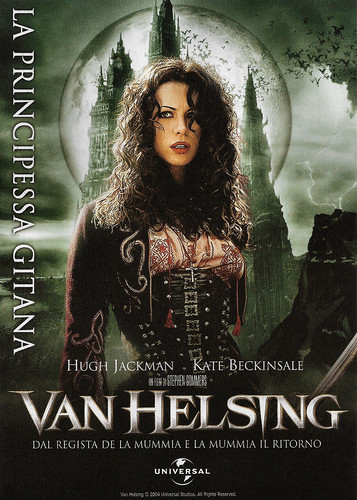
Italian postcard by Promocard, no. PC 4804. Photo: Universal. Kate Beckinsale in Van Helsing (Stephen Sommers, 2004). The card was published for the video and DVD release of the film in Italy.
A nurse torn between two pilots
In 2000, Kate Beckinsale starred in the costume drama The Golden Bowl (James Ivory, 2000) with Edward Fox and Anjelica Huston. The screenplay by Ruth Prawer Jhabvala is based on the 1904 novel of the same name by Henry James, who considered the work his masterpiece.
Then she landed the lead female role in the Hollywood blockbuster Pearl Harbor (Michael Bay, 2001) after Charlize Theron pulled out. She played a nurse torn between two pilots (played by Ben Affleck and Josh Hartnett). The film was a box office success, earning $59 million in its opening weekend and nearly $450 million worldwide, but received generally negative reviews from critics.
A little gem was the romantic comedy Serendipity (Peter Chelsom, 2001) with John Cusack. The film has grossed over $77 million at the worldwide box office.
She played a vampire in Underworld (Len Wiseman, 2003), a surprise box-office hit that gained a cult following. Director and star fell in love, and the following year, she married Wiseman.
The success of the film led to four more films between 2006 and 2016, The Underworld series, which follows a war between vampires and werewolves (called 'Lycans' in the films). Despite receiving generally negative reviews from critics, the five films have amassed a strong fan following and have grossed a total of $539 million, against a combined budget of $212 million.
Normally slender, Beckinsale gained twenty pounds for roles in 2004 - ten pounds for her role as a vampire hunter in Van Helsing (Stephen Sommers, 2004) opposite Hugh Jackman, and another ten pounds to portray the voluptuous Ava Gardner in the Howard Hughes biopic The Aviator (Martin Scorsese, 2004), starring Leonardo DiCaprio .
In 2006, Beckinsale reprised her role as Selene in the successful vampire sequel Underworld: Evolution, directed by her husband. Her daughter had a small role as the younger Selene.
Beckinsale's second film appearance of 2006 was opposite Adam Sandler and Christopher Walken in Click (Frank Coraci, 2006), a comedy about an overworked family man who discovers a magical remote control that allows him to control time. It grossed $237 million worldwide from a production budget of $82.5 million.
She replaced Sarah Jessica Parker after she dropped out of the horror-thriller Vacancy (Nimród Antal, 2007) with Luke Wilson. Then followed the family drama Everybody's Fine (Kirk Jones, 2009), starring Robert De Niro . It is a remake of Giuseppe Tornatore's Italian film Stanno tutti bene/Everybody's Fine (1990).
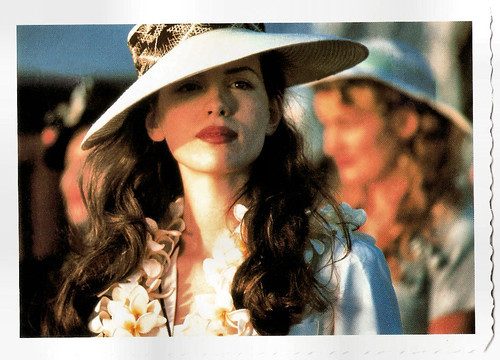
German postcard by Edgar Medien AG. Photo: Touchstone Pictures / Bueno Vista International. Kate Beckinsale in Pearl Harbor (Michael Bay, 2001).
Accusing Harvey Weinstein of sexual harassment or assault
Unable to find a script she felt passionate about, kate Beckinsale kept a low profile in 2010 and 2011, opting to spend time with her daughter. Beckinsale returned to acting in 2012 with appearances in three action films. The first was the action thriller Contraband (Baltasar Kormákur, 2012), starring Mark Wahlberg and based on the Icelandic film, Reykjavík-Rotterdam (Óskar Jónasson, 2008) starring Baltasar Kormákur.
Beckinsale next reprised her role as Selene in the fourth installment of the vampire franchise Underworld: Awakening (Måns Mårlind, Björn Stein, 2008). The franchise was initially conceived of as a trilogy and Beckinsale was not "intending to do another one" but was convinced by the quality of the script.
Beckinsale also appeared as the wife of the factory worker (Colin Farrell) in the Sci-Fi action remake Total Recall (2012), directed by her husband Len Wiseman. The film received mainly negative reviews.
In 2014, Beckinsale starred in the psychological thriller The Face of an Angel (Michael Winterbottom, 2014) alongside Daniel Brühl. The film was inspired by the case of Meredith Kercher.
In the romantic comedy Love & Friendship (Whit Stillman, 2016), Beckinsale reunited with her Last Days of Disco collaborators, Stillman and Chloë Sevigny. Based on Jane Austen's 'Lady Susan', the film revolved around her role as the title character, a wry and calculating widow, as she pursues a wealthy and hapless man for marriage originally intended for her daughter, though she eventually marries him herself. The film was universally acclaimed by critics and found commercial success in arthouse cinemas.
She was among over 80 women who accused Harvey Weinstein of sexual harassment or assault in October 2017. She acted in the British film Farming (2018), written and directed by Adewale Akinnuoye-Agbaje, based on his own childhood. The plot is about a child whose Yorubá parents give him to a white working-class family in London in the 1960s, and who grows up to join a white skinhead gang led by a white supremacist.
Kate Beckinsale lives in Venice, California because it reminds her of London. She divorced Len Wiseman in 2019. Beckinsale will next star in the upcoming American action film Jolt (Tanya Wexler, 2021) from a screenplay by Scott Wascha.
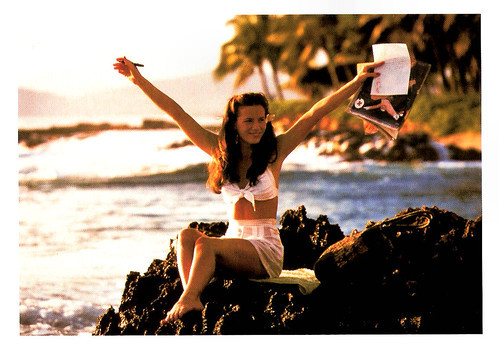
German postcard by Edgar Medien AG. Photo: Touchstone Pictures / Bueno Vista International. Kate Beckinsale in Pearl Harbor (Michael Bay, 2001).
Sources: Wikipedia and .

Australian postcard by Avant Card, no. 3 in a series of 5. Photo: Jerry Bruckheimer Films / Buena Vista International / Touchstone Pictures. Kate Beckinsale in Pearl Harbor (Michael Bay, 2001).

British postcard by Arcards. Photo: Sony Pictures. Kate Beckinsale in Underworld: Evolution (Len Wiseman, 2006).
A tumultuous adolescence
Kate Beckinsale was born in 1973 in Finsbury Park, London, or in Hounslow, Middlesex, England (the sources differ). However, she has resided in London for most of her life.
Her mother is actress Judy Loe, and her father was actor Richard Beckinsale, who starred in popular British television comedies during the 1970s. He passed away tragically early in 1979 at the age of 31. Kate is the younger half-sister of actress Samantha Beckinsale.
Kate attended the private school Godolphin and Latymer School in London for her grade and primary school education. In her teens, she twice won the British bookseller W.H. Smith Young Writers' competition - once for three short stories and once for three poems. After a tumultuous adolescence (including a bout of anorexia), she gradually took up the profession of acting.
Her major acting debut came in the TV film One Against the Wind (Larry Elikann, 1991), about World War II. Kate began attending Oxford University's New College in the fall of 1991, majoring in French and Russian literature. She had already decided that she wanted to act, but to broaden her horizons she chose university over drama school.
While in her first year at Oxford, Kate received her big break in the film adaptation of William Shakespeare's Much Ado About Nothing (Kenneth Branagh, 1993). Kate worked in three other films while attending Oxford, beginning with a part in the medieval historical drama Prince of Jutland (Gabriel Axel, 1994), starring Christian Bale, Gabriel Byrne, and Helen Mirren. The film was shot during the spring of 1993 on location in Denmark, and she filmed her supporting part during New College's Easter break.
Later in the summer of that year, she played the lead in the thriller Uncovered (Jim McBride, 1994). Before she went back to school, her third year at university was spent at Oxford's study-abroad program in Paris. This year caused her to re-evaluate the direction of her life. She faced a choice: continue with school or concentrate on her flourishing acting career. After much thought, she chose an acting career. In the spring of 1994, Kate left Oxford, after finishing three years of study.

German postcard by Edgar Medien AG. Photo: Touchstone Pictures / Bueno Vista International. Kate Beckinsale and Josh Hartnett in Pearl Harbor (Michael Bay, 2001).

German postcard by Edgar Medien AG. Photo: Touchstone Pictures / Bueno Vista International. Kate Beckinsale in Pearl Harbor (Michael Bay, 2001).
Playing an object of desire
Kate Beckinsale appeared in the BBC/Thames Television costume comedy Cold Comfort Farm (John Schlesinger, 1995), which later opened in American cinemas to spectacular reviews, grossing over $5 million during its American run. It was re-released to U.K. cinemas in the spring of 1997.
Acting on the stage consumed the first part of 1995; she toured in England with the Thelma Holts Theatre Company production of Anton Chekhov's 'The Seagull'. After turning down several mediocre scripts, she waited seven months before another interesting role was offered to her.
It was the horror film Haunted (Lewis Gilbert, 1995), starring opposite Aidan Quinn and John Gielgud . In this film, she wanted to play "an object of desire", unlike her past performances where her characters were much less the siren and more the worldly innocent.
Then followed a TV adaptation of Jane Austen's novel Emma (Diarmuid Lawrence, 1996), and the crime comedy Shooting Fish (Stefan Schwartz, 1997), in which she played Georgie, an altruistic con artist.
She started film work in the United States in the small-scale dramas The Last Days of Disco (Whit Stillman, 1998) with Chloë Sevigny, and Brokedown Palace (Jonathan Kaplan, 1999) with Claire Danes.
In 1999, she had a daughter, Lily Mo Sheen, with actor Michael Sheen with whom she dated from 1995 to 2003. They met when cast in a touring production of 'The Seagull' in early 1995 and moved in together shortly afterward. After their separation, Beckinsale and Sheen remained close friends.

Italian postcard by Promocard, no. PC 4804. Photo: Universal. Kate Beckinsale in Van Helsing (Stephen Sommers, 2004). The card was published for the video and DVD release of the film in Italy.
A nurse torn between two pilots
In 2000, Kate Beckinsale starred in the costume drama The Golden Bowl (James Ivory, 2000) with Edward Fox and Anjelica Huston. The screenplay by Ruth Prawer Jhabvala is based on the 1904 novel of the same name by Henry James, who considered the work his masterpiece.
Then she landed the lead female role in the Hollywood blockbuster Pearl Harbor (Michael Bay, 2001) after Charlize Theron pulled out. She played a nurse torn between two pilots (played by Ben Affleck and Josh Hartnett). The film was a box office success, earning $59 million in its opening weekend and nearly $450 million worldwide, but received generally negative reviews from critics.
A little gem was the romantic comedy Serendipity (Peter Chelsom, 2001) with John Cusack. The film has grossed over $77 million at the worldwide box office.
She played a vampire in Underworld (Len Wiseman, 2003), a surprise box-office hit that gained a cult following. Director and star fell in love, and the following year, she married Wiseman.
The success of the film led to four more films between 2006 and 2016, The Underworld series, which follows a war between vampires and werewolves (called 'Lycans' in the films). Despite receiving generally negative reviews from critics, the five films have amassed a strong fan following and have grossed a total of $539 million, against a combined budget of $212 million.
Normally slender, Beckinsale gained twenty pounds for roles in 2004 - ten pounds for her role as a vampire hunter in Van Helsing (Stephen Sommers, 2004) opposite Hugh Jackman, and another ten pounds to portray the voluptuous Ava Gardner in the Howard Hughes biopic The Aviator (Martin Scorsese, 2004), starring Leonardo DiCaprio .
In 2006, Beckinsale reprised her role as Selene in the successful vampire sequel Underworld: Evolution, directed by her husband. Her daughter had a small role as the younger Selene.
Beckinsale's second film appearance of 2006 was opposite Adam Sandler and Christopher Walken in Click (Frank Coraci, 2006), a comedy about an overworked family man who discovers a magical remote control that allows him to control time. It grossed $237 million worldwide from a production budget of $82.5 million.
She replaced Sarah Jessica Parker after she dropped out of the horror-thriller Vacancy (Nimród Antal, 2007) with Luke Wilson. Then followed the family drama Everybody's Fine (Kirk Jones, 2009), starring Robert De Niro . It is a remake of Giuseppe Tornatore's Italian film Stanno tutti bene/Everybody's Fine (1990).

German postcard by Edgar Medien AG. Photo: Touchstone Pictures / Bueno Vista International. Kate Beckinsale in Pearl Harbor (Michael Bay, 2001).
Accusing Harvey Weinstein of sexual harassment or assault
Unable to find a script she felt passionate about, kate Beckinsale kept a low profile in 2010 and 2011, opting to spend time with her daughter. Beckinsale returned to acting in 2012 with appearances in three action films. The first was the action thriller Contraband (Baltasar Kormákur, 2012), starring Mark Wahlberg and based on the Icelandic film, Reykjavík-Rotterdam (Óskar Jónasson, 2008) starring Baltasar Kormákur.
Beckinsale next reprised her role as Selene in the fourth installment of the vampire franchise Underworld: Awakening (Måns Mårlind, Björn Stein, 2008). The franchise was initially conceived of as a trilogy and Beckinsale was not "intending to do another one" but was convinced by the quality of the script.
Beckinsale also appeared as the wife of the factory worker (Colin Farrell) in the Sci-Fi action remake Total Recall (2012), directed by her husband Len Wiseman. The film received mainly negative reviews.
In 2014, Beckinsale starred in the psychological thriller The Face of an Angel (Michael Winterbottom, 2014) alongside Daniel Brühl. The film was inspired by the case of Meredith Kercher.
In the romantic comedy Love & Friendship (Whit Stillman, 2016), Beckinsale reunited with her Last Days of Disco collaborators, Stillman and Chloë Sevigny. Based on Jane Austen's 'Lady Susan', the film revolved around her role as the title character, a wry and calculating widow, as she pursues a wealthy and hapless man for marriage originally intended for her daughter, though she eventually marries him herself. The film was universally acclaimed by critics and found commercial success in arthouse cinemas.
She was among over 80 women who accused Harvey Weinstein of sexual harassment or assault in October 2017. She acted in the British film Farming (2018), written and directed by Adewale Akinnuoye-Agbaje, based on his own childhood. The plot is about a child whose Yorubá parents give him to a white working-class family in London in the 1960s, and who grows up to join a white skinhead gang led by a white supremacist.
Kate Beckinsale lives in Venice, California because it reminds her of London. She divorced Len Wiseman in 2019. Beckinsale will next star in the upcoming American action film Jolt (Tanya Wexler, 2021) from a screenplay by Scott Wascha.

German postcard by Edgar Medien AG. Photo: Touchstone Pictures / Bueno Vista International. Kate Beckinsale in Pearl Harbor (Michael Bay, 2001).
Sources: Wikipedia and .
Published on February 14, 2021 22:00
February 13, 2021
Before Hollywood: The Biograph Company
The Biograph Company, also known as the American Mutoscope and Biograph Company, was a film company founded in 1895 and active until 1916. It was the first company in the United States devoted entirely to film production and exhibition, and for two decades was one of the most prolific, releasing over 3000 short films and 12 feature films. The company was home to pioneering director D. W. Griffith and such actors as Mary Pickford, Lillian Gish, and Lionel Barrymore.
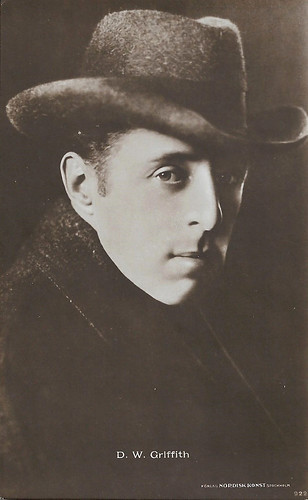
Swedish postcard by Förlag Nordisk Konst, Stockholm, no. 922. A rare portrait of the famous American film director D.W. Griffith.
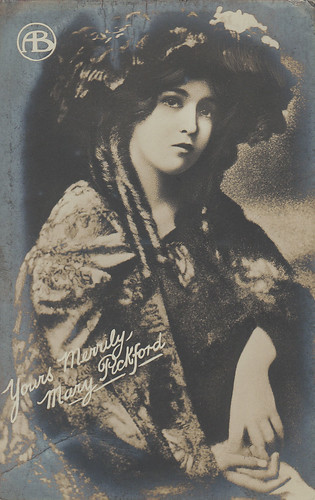
British postcard no. 54. Photo: American Biograph. Mary Pickford . Collection: Marlene Pilaete.
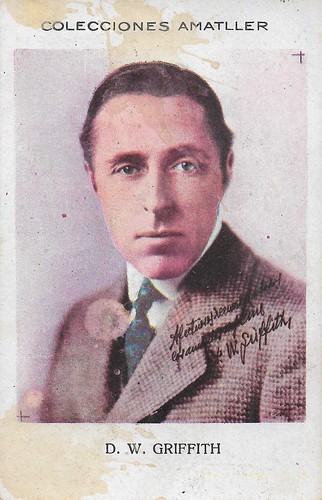
Spanish collector's card by Chocolate Amatller, Series B, Artist no. 3, no. 10. D. W. Griffith .
Edison's chief competitor in the nickelodeon market
The Biograph company was started in New York City by William Kennedy Dickson, an inventor at Thomas Edison's laboratory who helped pioneer the technology of capturing moving images on film. Dickson left Edison in April 1895, joining with inventors Herman Casler, Henry Marvin, and businessman Elias Koopman to incorporate the American Mutoscope Company in New Jersey on 30 December 1895.
The firm manufactured the Mutoscope and made flip-card movies for it as a rival to Edison's Kinetoscope for individual "peep shows", making the company Edison's chief competitor in the nickelodeon market. In the summer of 1896, the Biograph projector was released, offering superior image quality to Edison's Vitascope projector.
The company soon became a leader in the film industry, with distribution and production subsidiaries around the world, including the British Mutoscope Co. In 1899 it changed its name to the American Mutoscope and Biograph Company, and in 1908 to simply the Biograph Company. To avoid violating Edison's motion picture patents, Biograph cameras from 1895 to 1902 used a large-format film, measuring 2 23⁄32 inches (69 mm) wide, with an image area of 2 by 2 1⁄2 inches (51 mm × 64 mm), four times that of Edison's 35 mm format.
The camera used friction feed instead of Edison's sprocket feed to guide the film to the aperture. The camera itself punched a sprocket hole on each side of the frame as the film was exposed at 30 frames per second. A patent case victory in March 1902 allowed Biograph and other producers and distributors to use the less expensive 35 mm format without an Edison license, although Biograph did not completely phase out 68 mm production until autumn of 1903. Biograph offered prints in both formats to exhibitors until 1905, when it discontinued the larger format.
The first film of the Biograph Company was Empire State Express (1896). Biograph films before 1903, were mostly such "actualities," documentary film footage of actual persons, places, and events, each film usually less than two minutes long. Other early production efforts, including filming U.S. presidential candidate William McKinley on the campaign trail in 1896, Pope Leo XIII at the Vatican in 1899, and U.S. Pres. Theodore Roosevelt at the White House in the early 20th century.
The occasional narrative film, usually a comedy, was typically shot in one scene, with no editing. Spurred on by competition from Edison and British and European producers, Biograph production from 1903 onward was increasingly dominated by narratives. As the stories became more complex the films became longer, with multiple scenes to tell the story, although an individual scene was still usually presented in one shot without editing. Biograph's production of actualities ended by 1908 in favour of the narrative film.
The company's first studio was located on the roof of 841 Broadway at 13th St. in Manhattan, known then as the Hackett Carhart Building and today as the Roosevelt Building. The set-up was similar to Thomas Edison's ‘Black Maria’ in West Orange, New Jersey, with the studio itself being mounted on circular tracks to be able to get the best possible sunlight (as of 1988 the foundations of this machinery were still extant). The company moved in 1906 to a converted brownstone mansion at 11 East 14th Street near Union Square, a building that was razed in the 1960s. This was Biograph's first indoor studio, and the first film studio in the world to rely exclusively on artificial light.
Biograph moved again in 1913, as it entered feature-film production, to a new state-of-the-art studio on 175th Street in the Bronx. There was the problem of the underground "duping" business, where people would illegally duplicate a copyrighted movie and then remove the title screen with the company and copyright notice and sell it to theatres. In order to make the theatre audience aware that they were watching an American Biograph movie (regardless of whether it was illegally "duped" or not), the AB logo would be prominently placed in random parts of the film.
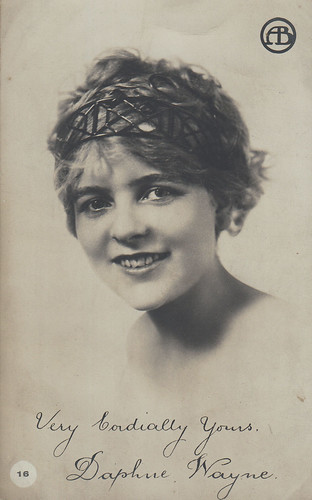
British postcard, no. 16. Photo: American Biograph. Blanche Sweet as Daphne Wayne, the name which was given to her for British audiences by the MPSA Motion Picture Sales Agency. Collection: Marlene Pilaete.
Blanche Sweet (1896-1986) was an actress of the silent screen, who first acted at Biograph in countless shorts and the feature Judith of Bethulia (1914) by D.W. Griffith. In the 1920s she acted at e.g. Lasky/Paramount, became a highly paid star, and was married to director Marshall Neilan. For both Anna Christie (1923) and Tess of the D'Urbervilles (1924), Sweet received raving reviews.
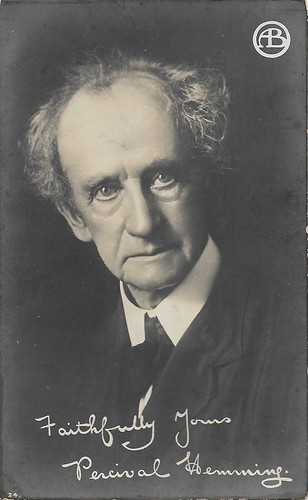
British postcard, no. 24. Photo: American Biograph. Percival Hemming a.k.a. William Chrystie Miller.
William Chrystie Miller (also written as W.M. Christie Miller) (1843-1922) was an American silent film actor. He appeared in 139 films between 1908 and 1914. Miller frequently appeared in films directed by David Wark Griffith, including Ramona (1910) and The Lonedale Operator (1910). He was known to film audiences as the "Grand Old Man of the Photodrama".
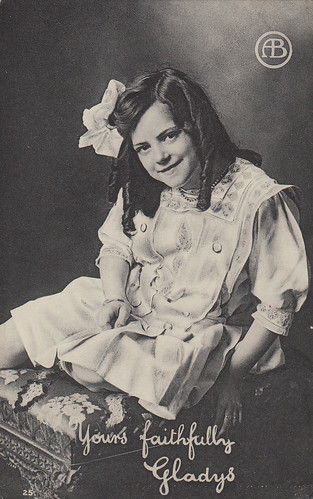
British postcard, no. 25. Photo: American Biograph. Collection: Marlene Pilaete.
Gladys Egan (1900-1985) was an American child actress during the silent film era. She appeared in 110 film shorts, between 1908 and 1914, including many that were produced by D.W. Griffith.
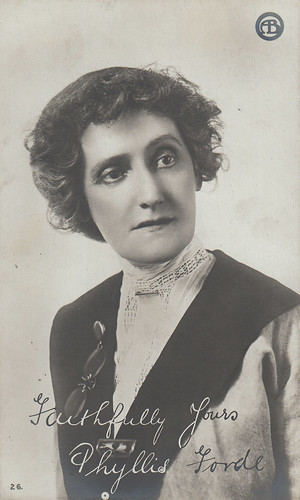
British postcard, no. 26. Photo: American Biograph. Collection: Marlene Pilaete.
Kate Bruce (1860-1946) was an elderly American silent-screen actress who often played mother characters for American Biograph. Bruce who often used the alias, Phyllis Forde, was D.W. Griffith's favourite matriarchal figure.
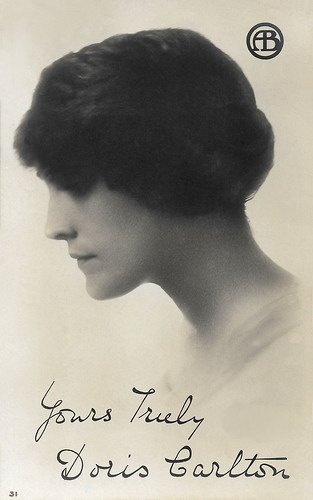
British postcard, no. 31. Photo: American Biograph.
Claire McDowell (1877-1966 ) also known as Doris Carlton was an American stage and silent film actress. After appearing on Broadway, she worked for eight years at American Biograph (1908-1916) and acted in many films by D.W. Griffith. Later, she worked for Universal, Triangle, and MGM and played mother roles. She was the mother of Douglas Fairbanks's love interest in The Mark of Zorro (Fred Niblo, 1920), Ramon Novarro's mother in Ben-Hur: A Tale of the Christ (Fred Niblo, 1925), and John Gilbert's mother in The Big Parade (King Vidor, 1925).
The Biograph Girl
Director D. W. Griffith joined Biograph in 1908 as a writer and actor, but within months became its principal director. In 1908, the company's head director Wallace McCutcheon grew ill, and his son Wallace McCutcheon Jr. took his place but was not able to make a successful film for the company. As a result of these failed productions, studio head Henry Marvin gave the position of head director to Griffith, whose first film was The Adventures of Dollie (D.W. Griffith, 1908) with Gladys Egan and Arthur V. Johnson.
Griffith helped establish many of the conventions of narrative film, including cross-cutting to show events occurring simultaneously in different places, the flashback, the fade-in/fade-out, the interposition of close-ups within a scene, and a moderated acting style more suitable for film. Although Griffith did not invent these techniques, he made them a regular part of the film vocabulary. His prolific output—often one new film a week—and willingness to experiment in many different genres helped the company become a major commercial success.
Despite the fact that Biograph did not permit onscreen credits for actors, Griffith practically invented the star system through his discovery of actress Florence Lawrence, who was billed as "The Biograph Girl." When she jumped ship to competitor Vitagraph, he moved a new "Biograph Girl" into place, who later became "Biograph Mary" and eventually known by her name, Mary Pickford .
Many early film stars were Biograph performers, including Lionel Barrymore, Lillian Gish , Dorothy Gish , Robert Harron, Arthur V. Johnson, Florence Auer, Robert G. Vignola, Owen Moore, Alan Hale, Sr., Blanche Sweet, Harry Carey, James Kirkwood Sr., Mabel Normand, Henry B. Walthall, Mae Marsh, and Dorothy Davenport. Mack Sennett honed his craft as an actor and director of comedies at Biograph.
In January 1910, Griffith and Lee Dougherty with the rest of the Biograph acting company travelled to Los Angeles. While the purpose of the trip was to shoot Ramona (D.W. Griffith, 1910) with Mary Pickford in authentic locations, it was also to determine the suitability of the West Coast as a place for a permanent studio. The group set up a small facility at Washington Street and Grand Avenue. After this, Griffith and his players decided to go a little further north to a small village they had heard about that was friendly and had beautiful floral scenery. They decided to travel there and fell in love with this little place called Hollywood.
Biograph then made the first film ever in Hollywood called In Old California (D.W. Griffith, 1910) with Marion Leonard and Henry B. Walthall, a Latino melodrama about the early days of Mexico-owned California. Griffith and the Biograph troupe filmed other short films at various locations then travelled back to New York. After the East Coast film community heard about Hollywood, other companies began to migrate there. Biograph's little film launched Hollywood as the future film capital of the world. It opened a studio at Pico and Georgia streets in downtown Los Angeles in 1911 and sent a film crew to work there each year until 1916.
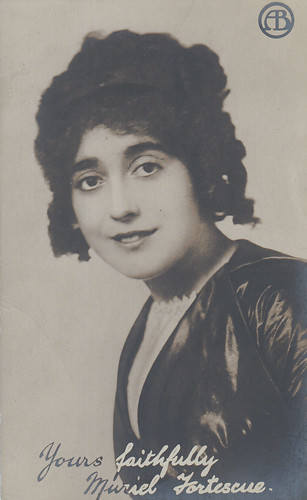
British postcard. Photo: American Biograph. Mabel Normand as Muriel Fortescue, the name which was given to her for British audiences by the MPSA Motion Picture Sales Agency. Collection: Marlene Pilaete.
Mabel Normand (1892-1930) started as an actress in 1910 at the Eastcoast, at Vitagraph and Biograph. She became a popular American silent film comedienne, in particular in her films with Charlie Chaplin. But alcohol, drugs, and scandal wrecked her career and TBC killed her at a young age.

American postcard by Kraus Manufacturing Co., New York, 1913. Photo: Biograph.
Henry B. Walthall (1878-1936) was a prolific actor at D.W. Griffith's American Biograph and played in countless films there. The culmination of the Griffith-Walthall connection was Walthall's role as Colonel Ben Cameron in The Birth of a Nation (1915). Throughout his career, Henry B. Walthall remained working as a motion picture actor. At the time of his death in 1936, Walthall had appeared in more than 320 films.
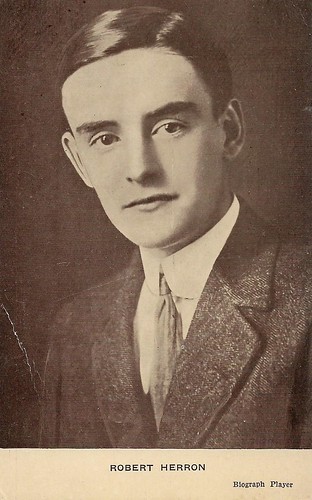
American postcard by Kraus Manufacturing Co., New York, 1913. Photo: Biograph. Robert Harron's name is misspelled as Herron.
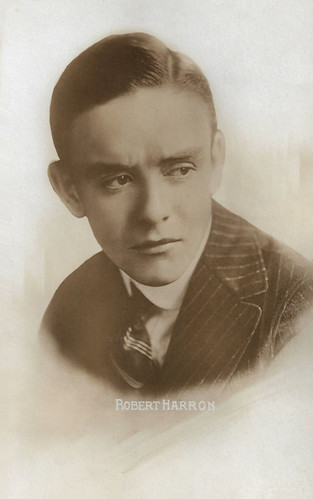
Swedish postcard by Nordisk Konst, Stockholm.
Robert Harron (1893-1920) was a teenager when he acted in his first films. 'Bobby' soon appeared in the first films of D. W. Griffith and was to rub shoulders with the great silent stars of the time, notably Lillian Gish.
The Edison Trust
David Wark Griffith left Biograph in October 1913 after finishing Judith of Bethulia (D.W. Griffith, 1914), unhappy with the company's resistance to larger budgets, feature film production, or giving onscreen credit to him and the cast. He had directed four hundred and fifty short films for the studio. With him went many of the Biograph actors, his cameraman Billy Bitzer and his production crew. As a final slight to Griffith, Biograph delayed the release of Judith of Bethulia until March 1914, to avoid a profit-sharing arrangement the company had with him.
In December 1908 Biograph had joined Edison in forming the Motion Picture Patents Company in an attempt to control the industry and shut out smaller producers. The "Edison Trust," as it was nicknamed, was made up of Edison, Biograph, Essanay Studios, Kalem Company, George Kleine Productions, Lubin Studios, Georges Méliès, Pathé, Selig Studios, and Vitagraph Studios, and dominated distribution through the General Film Co. The Motion Picture Patents Co. and the General Film Co. were found guilty of antitrust violation in October 1915 and dissolved.
Shielded by the Trust, Biograph had been slow to enter feature film production. It contracted with the theatrical firm of Klaw & Erlanger in 1913 to produce film versions of the latter's plays. Its first released feature, Classmates, came out in February 1914, after 69 other American features had been released in 1912–1913. Distribution was hampered by Biograph using a special perforation pattern on the Klaw & Erlanger features that were incompatible with standard projectors, forcing exhibitors to lease specialised equipment from Biograph in order to show the films.
With the exodus of the studio's best actors to Griffith, Biograph was unable to develop a marketable star system as the independent companies were doing, and after the Trust's fall, Biograph found itself behind the times. The Biograph Co. released its last new feature-length films in 1915 and its last new short films in 1916. Biograph spent the remainder of the silent era reissuing its old films and leasing its Bronx studio to other producers.
When the company fell on financial hard times, the Biograph Studio facilities and film laboratory in the Bronx were acquired by one of Biograph Company's creditors, the Empire Trust Company, although some of the ex-Biograph staff were retained to manage the studio and laboratory facilities. Herbert Yates acquired the Biograph Studios facilities and film laboratory in 1928. Biograph Studios facilities and film laboratory were made a subsidiary of his Consolidated Film Industries in 1928. The studio facilities and laboratory burned down in 1980.
In 1939, Iris Barry, founder of the film department at the Museum of Modern Art, acquired 900 cans of film from the Actinograph Corp. Bronx Biograph studio and laboratory facilities, which was closing its film vault and planning to destroy all the film. One uncompleted film, Lime Kiln Club Field Day (T. Hayes Hunter, Edwin Middleton, 1913), with an all African American cast, was found among the many cans of film and shown at MOMA in November 2014. Biograph was revived as a small independent studio in the 1980s. In 1991 it relocated to California, later establishing its headquarters in Sherman Oaks.
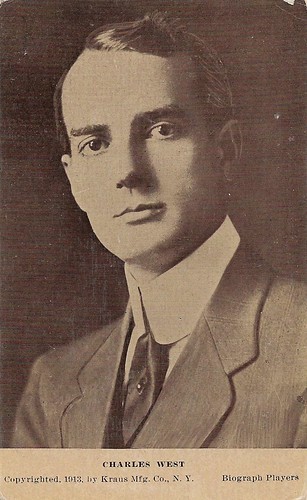
American postcard by Kraus Manufacturing Co., New York, 1913. Photo: Biograph.
Charles West (1885-1943) was an American film actor of the silent film era, who appeared in more than 300 films between 1908 and 1937. In 1908 West started to act with D.W. Griffith at Biograph, where he made hundreds of shorts, starting with The Christmas Burglars (Griffith, 1908), with Florence Lawrence. Being part of the Biograph 'stable' he did many supporting parts but also had leads, as in the Griffith films A Flash of Light (1910), The Broken Cross (1911), The Last Drop of Water (1911), The Blind Princess and the Poet (1911), etc., often being paired with Blanche Sweet. In 1913 he often starred opposite Sweet or/ and Harry Carey and Claire McDowell, in e.g. The Hero of Little Italy, A Frightful Blunder, The Left-Handed Man, Just Gold, The Vengeance of Galora, etc. By then direction at Biograph alternated between Griffith and Andy O'Sullivan. In the mid-1910s West remained with Harry Carey as part of the cast of his Westerns at Biograph.
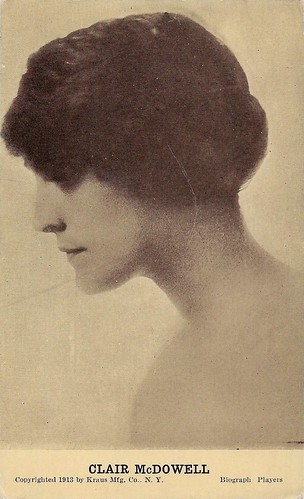
American postcard by Kraus Manufacturing Co., New York, 1913. Photo: Biograph. McDowell's first name is misspelled as Clair on this card.
Claire McDowell (1877-1966 ) also known as Doris Carlton was an American stage and silent film actress. After appearing on Broadway, she worked for eight years at American Biograph (1908-1916) and acted in many films by D.W. Griffith. Later, she worked for Universal, Triangle, and MGM and played mother roles. She was the mother of Douglas Fairbanks's love interest in The Mark of Zorro (Fred Niblo, 1920), Ramon Novarro's mother in Ben-Hur: A Tale of the Christ (Fred Niblo, 1925), and John Gilbert's mother in The Big Parade (King Vidor, 1925).
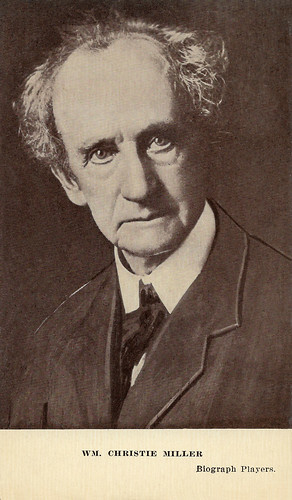
Vintage postcard. Photo: Biograph.
William Chrystie Miller (also written as W.M. Christie Miller) (1843-1922) was an American silent film actor. He appeared in 139 films between 1908 and 1914. Miller frequently appeared in films directed by David Wark Griffith, including Ramona (1910) and The Lonedale Operator (1910). He was known to film audiences as the "Grand Old Man of the Photodrama".
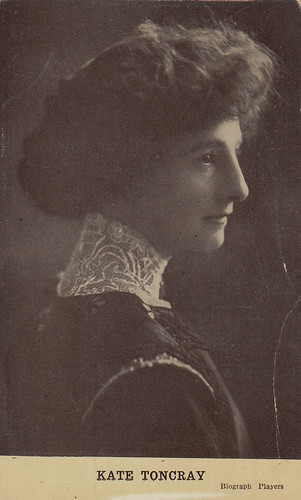
American postcard published by Kraus Mfg. Co., N.Y. Photo: American Biograph. Collection: Marlene Pilaete.
Kate Toncray (1867-1927) was an American character actress of the silent era. She appeared in 178 films between 1905 and 1925, always like an older woman.
Sources: Wikipedia, Starpulse, Encyclopaedia Britannica, and .
Check out our earlier Before Hollywood posts: Vitagraph, and Essanay.

Swedish postcard by Förlag Nordisk Konst, Stockholm, no. 922. A rare portrait of the famous American film director D.W. Griffith.

British postcard no. 54. Photo: American Biograph. Mary Pickford . Collection: Marlene Pilaete.

Spanish collector's card by Chocolate Amatller, Series B, Artist no. 3, no. 10. D. W. Griffith .
Edison's chief competitor in the nickelodeon market
The Biograph company was started in New York City by William Kennedy Dickson, an inventor at Thomas Edison's laboratory who helped pioneer the technology of capturing moving images on film. Dickson left Edison in April 1895, joining with inventors Herman Casler, Henry Marvin, and businessman Elias Koopman to incorporate the American Mutoscope Company in New Jersey on 30 December 1895.
The firm manufactured the Mutoscope and made flip-card movies for it as a rival to Edison's Kinetoscope for individual "peep shows", making the company Edison's chief competitor in the nickelodeon market. In the summer of 1896, the Biograph projector was released, offering superior image quality to Edison's Vitascope projector.
The company soon became a leader in the film industry, with distribution and production subsidiaries around the world, including the British Mutoscope Co. In 1899 it changed its name to the American Mutoscope and Biograph Company, and in 1908 to simply the Biograph Company. To avoid violating Edison's motion picture patents, Biograph cameras from 1895 to 1902 used a large-format film, measuring 2 23⁄32 inches (69 mm) wide, with an image area of 2 by 2 1⁄2 inches (51 mm × 64 mm), four times that of Edison's 35 mm format.
The camera used friction feed instead of Edison's sprocket feed to guide the film to the aperture. The camera itself punched a sprocket hole on each side of the frame as the film was exposed at 30 frames per second. A patent case victory in March 1902 allowed Biograph and other producers and distributors to use the less expensive 35 mm format without an Edison license, although Biograph did not completely phase out 68 mm production until autumn of 1903. Biograph offered prints in both formats to exhibitors until 1905, when it discontinued the larger format.
The first film of the Biograph Company was Empire State Express (1896). Biograph films before 1903, were mostly such "actualities," documentary film footage of actual persons, places, and events, each film usually less than two minutes long. Other early production efforts, including filming U.S. presidential candidate William McKinley on the campaign trail in 1896, Pope Leo XIII at the Vatican in 1899, and U.S. Pres. Theodore Roosevelt at the White House in the early 20th century.
The occasional narrative film, usually a comedy, was typically shot in one scene, with no editing. Spurred on by competition from Edison and British and European producers, Biograph production from 1903 onward was increasingly dominated by narratives. As the stories became more complex the films became longer, with multiple scenes to tell the story, although an individual scene was still usually presented in one shot without editing. Biograph's production of actualities ended by 1908 in favour of the narrative film.
The company's first studio was located on the roof of 841 Broadway at 13th St. in Manhattan, known then as the Hackett Carhart Building and today as the Roosevelt Building. The set-up was similar to Thomas Edison's ‘Black Maria’ in West Orange, New Jersey, with the studio itself being mounted on circular tracks to be able to get the best possible sunlight (as of 1988 the foundations of this machinery were still extant). The company moved in 1906 to a converted brownstone mansion at 11 East 14th Street near Union Square, a building that was razed in the 1960s. This was Biograph's first indoor studio, and the first film studio in the world to rely exclusively on artificial light.
Biograph moved again in 1913, as it entered feature-film production, to a new state-of-the-art studio on 175th Street in the Bronx. There was the problem of the underground "duping" business, where people would illegally duplicate a copyrighted movie and then remove the title screen with the company and copyright notice and sell it to theatres. In order to make the theatre audience aware that they were watching an American Biograph movie (regardless of whether it was illegally "duped" or not), the AB logo would be prominently placed in random parts of the film.

British postcard, no. 16. Photo: American Biograph. Blanche Sweet as Daphne Wayne, the name which was given to her for British audiences by the MPSA Motion Picture Sales Agency. Collection: Marlene Pilaete.
Blanche Sweet (1896-1986) was an actress of the silent screen, who first acted at Biograph in countless shorts and the feature Judith of Bethulia (1914) by D.W. Griffith. In the 1920s she acted at e.g. Lasky/Paramount, became a highly paid star, and was married to director Marshall Neilan. For both Anna Christie (1923) and Tess of the D'Urbervilles (1924), Sweet received raving reviews.

British postcard, no. 24. Photo: American Biograph. Percival Hemming a.k.a. William Chrystie Miller.
William Chrystie Miller (also written as W.M. Christie Miller) (1843-1922) was an American silent film actor. He appeared in 139 films between 1908 and 1914. Miller frequently appeared in films directed by David Wark Griffith, including Ramona (1910) and The Lonedale Operator (1910). He was known to film audiences as the "Grand Old Man of the Photodrama".

British postcard, no. 25. Photo: American Biograph. Collection: Marlene Pilaete.
Gladys Egan (1900-1985) was an American child actress during the silent film era. She appeared in 110 film shorts, between 1908 and 1914, including many that were produced by D.W. Griffith.

British postcard, no. 26. Photo: American Biograph. Collection: Marlene Pilaete.
Kate Bruce (1860-1946) was an elderly American silent-screen actress who often played mother characters for American Biograph. Bruce who often used the alias, Phyllis Forde, was D.W. Griffith's favourite matriarchal figure.

British postcard, no. 31. Photo: American Biograph.
Claire McDowell (1877-1966 ) also known as Doris Carlton was an American stage and silent film actress. After appearing on Broadway, she worked for eight years at American Biograph (1908-1916) and acted in many films by D.W. Griffith. Later, she worked for Universal, Triangle, and MGM and played mother roles. She was the mother of Douglas Fairbanks's love interest in The Mark of Zorro (Fred Niblo, 1920), Ramon Novarro's mother in Ben-Hur: A Tale of the Christ (Fred Niblo, 1925), and John Gilbert's mother in The Big Parade (King Vidor, 1925).
The Biograph Girl
Director D. W. Griffith joined Biograph in 1908 as a writer and actor, but within months became its principal director. In 1908, the company's head director Wallace McCutcheon grew ill, and his son Wallace McCutcheon Jr. took his place but was not able to make a successful film for the company. As a result of these failed productions, studio head Henry Marvin gave the position of head director to Griffith, whose first film was The Adventures of Dollie (D.W. Griffith, 1908) with Gladys Egan and Arthur V. Johnson.
Griffith helped establish many of the conventions of narrative film, including cross-cutting to show events occurring simultaneously in different places, the flashback, the fade-in/fade-out, the interposition of close-ups within a scene, and a moderated acting style more suitable for film. Although Griffith did not invent these techniques, he made them a regular part of the film vocabulary. His prolific output—often one new film a week—and willingness to experiment in many different genres helped the company become a major commercial success.
Despite the fact that Biograph did not permit onscreen credits for actors, Griffith practically invented the star system through his discovery of actress Florence Lawrence, who was billed as "The Biograph Girl." When she jumped ship to competitor Vitagraph, he moved a new "Biograph Girl" into place, who later became "Biograph Mary" and eventually known by her name, Mary Pickford .
Many early film stars were Biograph performers, including Lionel Barrymore, Lillian Gish , Dorothy Gish , Robert Harron, Arthur V. Johnson, Florence Auer, Robert G. Vignola, Owen Moore, Alan Hale, Sr., Blanche Sweet, Harry Carey, James Kirkwood Sr., Mabel Normand, Henry B. Walthall, Mae Marsh, and Dorothy Davenport. Mack Sennett honed his craft as an actor and director of comedies at Biograph.
In January 1910, Griffith and Lee Dougherty with the rest of the Biograph acting company travelled to Los Angeles. While the purpose of the trip was to shoot Ramona (D.W. Griffith, 1910) with Mary Pickford in authentic locations, it was also to determine the suitability of the West Coast as a place for a permanent studio. The group set up a small facility at Washington Street and Grand Avenue. After this, Griffith and his players decided to go a little further north to a small village they had heard about that was friendly and had beautiful floral scenery. They decided to travel there and fell in love with this little place called Hollywood.
Biograph then made the first film ever in Hollywood called In Old California (D.W. Griffith, 1910) with Marion Leonard and Henry B. Walthall, a Latino melodrama about the early days of Mexico-owned California. Griffith and the Biograph troupe filmed other short films at various locations then travelled back to New York. After the East Coast film community heard about Hollywood, other companies began to migrate there. Biograph's little film launched Hollywood as the future film capital of the world. It opened a studio at Pico and Georgia streets in downtown Los Angeles in 1911 and sent a film crew to work there each year until 1916.

British postcard. Photo: American Biograph. Mabel Normand as Muriel Fortescue, the name which was given to her for British audiences by the MPSA Motion Picture Sales Agency. Collection: Marlene Pilaete.
Mabel Normand (1892-1930) started as an actress in 1910 at the Eastcoast, at Vitagraph and Biograph. She became a popular American silent film comedienne, in particular in her films with Charlie Chaplin. But alcohol, drugs, and scandal wrecked her career and TBC killed her at a young age.

American postcard by Kraus Manufacturing Co., New York, 1913. Photo: Biograph.
Henry B. Walthall (1878-1936) was a prolific actor at D.W. Griffith's American Biograph and played in countless films there. The culmination of the Griffith-Walthall connection was Walthall's role as Colonel Ben Cameron in The Birth of a Nation (1915). Throughout his career, Henry B. Walthall remained working as a motion picture actor. At the time of his death in 1936, Walthall had appeared in more than 320 films.

American postcard by Kraus Manufacturing Co., New York, 1913. Photo: Biograph. Robert Harron's name is misspelled as Herron.

Swedish postcard by Nordisk Konst, Stockholm.
Robert Harron (1893-1920) was a teenager when he acted in his first films. 'Bobby' soon appeared in the first films of D. W. Griffith and was to rub shoulders with the great silent stars of the time, notably Lillian Gish.
The Edison Trust
David Wark Griffith left Biograph in October 1913 after finishing Judith of Bethulia (D.W. Griffith, 1914), unhappy with the company's resistance to larger budgets, feature film production, or giving onscreen credit to him and the cast. He had directed four hundred and fifty short films for the studio. With him went many of the Biograph actors, his cameraman Billy Bitzer and his production crew. As a final slight to Griffith, Biograph delayed the release of Judith of Bethulia until March 1914, to avoid a profit-sharing arrangement the company had with him.
In December 1908 Biograph had joined Edison in forming the Motion Picture Patents Company in an attempt to control the industry and shut out smaller producers. The "Edison Trust," as it was nicknamed, was made up of Edison, Biograph, Essanay Studios, Kalem Company, George Kleine Productions, Lubin Studios, Georges Méliès, Pathé, Selig Studios, and Vitagraph Studios, and dominated distribution through the General Film Co. The Motion Picture Patents Co. and the General Film Co. were found guilty of antitrust violation in October 1915 and dissolved.
Shielded by the Trust, Biograph had been slow to enter feature film production. It contracted with the theatrical firm of Klaw & Erlanger in 1913 to produce film versions of the latter's plays. Its first released feature, Classmates, came out in February 1914, after 69 other American features had been released in 1912–1913. Distribution was hampered by Biograph using a special perforation pattern on the Klaw & Erlanger features that were incompatible with standard projectors, forcing exhibitors to lease specialised equipment from Biograph in order to show the films.
With the exodus of the studio's best actors to Griffith, Biograph was unable to develop a marketable star system as the independent companies were doing, and after the Trust's fall, Biograph found itself behind the times. The Biograph Co. released its last new feature-length films in 1915 and its last new short films in 1916. Biograph spent the remainder of the silent era reissuing its old films and leasing its Bronx studio to other producers.
When the company fell on financial hard times, the Biograph Studio facilities and film laboratory in the Bronx were acquired by one of Biograph Company's creditors, the Empire Trust Company, although some of the ex-Biograph staff were retained to manage the studio and laboratory facilities. Herbert Yates acquired the Biograph Studios facilities and film laboratory in 1928. Biograph Studios facilities and film laboratory were made a subsidiary of his Consolidated Film Industries in 1928. The studio facilities and laboratory burned down in 1980.
In 1939, Iris Barry, founder of the film department at the Museum of Modern Art, acquired 900 cans of film from the Actinograph Corp. Bronx Biograph studio and laboratory facilities, which was closing its film vault and planning to destroy all the film. One uncompleted film, Lime Kiln Club Field Day (T. Hayes Hunter, Edwin Middleton, 1913), with an all African American cast, was found among the many cans of film and shown at MOMA in November 2014. Biograph was revived as a small independent studio in the 1980s. In 1991 it relocated to California, later establishing its headquarters in Sherman Oaks.

American postcard by Kraus Manufacturing Co., New York, 1913. Photo: Biograph.
Charles West (1885-1943) was an American film actor of the silent film era, who appeared in more than 300 films between 1908 and 1937. In 1908 West started to act with D.W. Griffith at Biograph, where he made hundreds of shorts, starting with The Christmas Burglars (Griffith, 1908), with Florence Lawrence. Being part of the Biograph 'stable' he did many supporting parts but also had leads, as in the Griffith films A Flash of Light (1910), The Broken Cross (1911), The Last Drop of Water (1911), The Blind Princess and the Poet (1911), etc., often being paired with Blanche Sweet. In 1913 he often starred opposite Sweet or/ and Harry Carey and Claire McDowell, in e.g. The Hero of Little Italy, A Frightful Blunder, The Left-Handed Man, Just Gold, The Vengeance of Galora, etc. By then direction at Biograph alternated between Griffith and Andy O'Sullivan. In the mid-1910s West remained with Harry Carey as part of the cast of his Westerns at Biograph.

American postcard by Kraus Manufacturing Co., New York, 1913. Photo: Biograph. McDowell's first name is misspelled as Clair on this card.
Claire McDowell (1877-1966 ) also known as Doris Carlton was an American stage and silent film actress. After appearing on Broadway, she worked for eight years at American Biograph (1908-1916) and acted in many films by D.W. Griffith. Later, she worked for Universal, Triangle, and MGM and played mother roles. She was the mother of Douglas Fairbanks's love interest in The Mark of Zorro (Fred Niblo, 1920), Ramon Novarro's mother in Ben-Hur: A Tale of the Christ (Fred Niblo, 1925), and John Gilbert's mother in The Big Parade (King Vidor, 1925).

Vintage postcard. Photo: Biograph.
William Chrystie Miller (also written as W.M. Christie Miller) (1843-1922) was an American silent film actor. He appeared in 139 films between 1908 and 1914. Miller frequently appeared in films directed by David Wark Griffith, including Ramona (1910) and The Lonedale Operator (1910). He was known to film audiences as the "Grand Old Man of the Photodrama".

American postcard published by Kraus Mfg. Co., N.Y. Photo: American Biograph. Collection: Marlene Pilaete.
Kate Toncray (1867-1927) was an American character actress of the silent era. She appeared in 178 films between 1905 and 1925, always like an older woman.
Sources: Wikipedia, Starpulse, Encyclopaedia Britannica, and .
Check out our earlier Before Hollywood posts: Vitagraph, and Essanay.
Published on February 13, 2021 22:00
February 12, 2021
Three Henny Porten films
Henny Porten was one of the three most popular German actresses of German silent cinema. In the 1910s and 1920s, her sepia postcards were collected by countless German school girls, including Marlene Dietrich. Ivo Blom selected three Porten films from the 1920s, all produced by her own company, Henny Porten Filmproduktion (HPF). For each production, Ross Verlag published a series of postcards with film scenes.
Inge Larsen (1924)
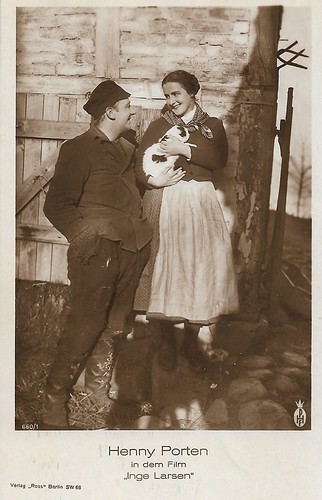
German postcard by Ross Verlag, no. 650/1. Photo: Henny Porten Filmproduktion (HPF). Henny Porten and Paul Hansen in Inge Larsen (Hans Steinhoff, 1924).
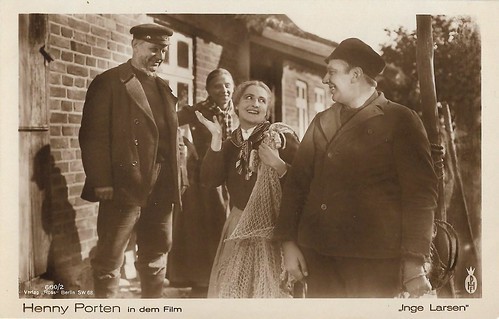
German postcard by Ross Verlag, no. 650/2. Photo: Henny Porten Filmproduktion (HPF). Henny Porten and Paul Hansen in Inge Larsen (Hans Steinhoff, 1924).
Inge Larsen (Hans Steinhoff, 1924) deals with a fisherwoman who by a marriage to a rich diplomat meets a world she doesn't know. Inge Larsen (Porten), the daughter of a fisherman, falls in love with Baron Kerr (Paul Otto), who is recovering in her parents' house after having problems with a storm at sea. Kerr also takes a liking to the young woman and so after a short time, he asks her for her hand. Inge leaves behind her parents and her boyfriend, the fisherman Jan Olsen (Paul Hansen) when she and Kerr begin a new and completely unfamiliar life. By marrying an influential diplomat, she now belongs to the higher social class, which also includes the high nobility. Inge has an opponent in the capricious Evelyne ( Ressel Orla ), with whom Kerr was in a relationship before his marriage.
After the young couple has had a child, it is more important for Inge to be with her child than to take on social responsibilities. Evelyne can now be seen more and more at Kerr's side. Inge, who is straightforward and honest, has little to oppose this woman who is crazy about intrigues. Although it is Kerr who cheats on his wife with Evelyne, he accuses Inge of infidelity. He uses the occasion when he sees Jan Olsen come out of his house. However, Inge only treated his injuries sustained while visiting a nightclub during a fight he got into. Another dramatic incident leads Inge to return to her parents' house after she and her husband have decided to divorce. Nothing stands in the way of happiness with Jan, who suits her much better.
Inge Larsen was scripted by Karl Vollmoeller and Hans Steinhoff. Helmar Lerski did the cinematography, while sets were by Fritz Lück, Alfred Junge, and Ludwig Kainer. The latter also did the costumes. The first outdoor shots were taken on Rügen in the second half of October 1922. This was followed by further shooting in Berlin. At the end of April / beginning of May 1923 further filming took place in Copenhagen because Porten was no longer satisfied with the film. The critic Fritz Olimsky, who noticed at the premiere that the film was not of the usual length, learned when asked that Henny Porten had subsequently removed or severely cut the scenes from the already-completed film in which she herself cannot be seen. Thus, from an ensemble film, “a clichéd star film with finely worked out secondary episodes” emerged, according to Olimsky. The film, forbidden for non-adults, premiered on 22 September 1923 at the Berlin cinema Kammer-Lichtspielen.
For some of the Berlin critics, the film was a vehicle for the star Henny Porten and was “fully geared towards the audience”. It was a "bomb role" for her. The other part was of the opinion that the film was old-fashioned "as it was half a decade ago" and "as it has always been in her famous films". The work of the production designer and the work of the cameraman were assessed as consistently positive. In particular, the opening shots by Lerski reminded me of contemporary Swedish cinema. It is also said that after a few failures with the embodiment of Inge Larsen as the ideal German woman and mother, Henny Porten was returning to a role that her regular audience expects of her.
The disappointment was expressed in view of the "pulp fiction plot", since Karl Vollmoeller was after all considered a "literary screenwriter", who, however, turns out to be a "backward-looking poet and dexterous family novelist". While the weaknesses of the film were blamed on the script and the superiority of Henny Porten , the work of Hans Steinhoff was rated positively. It was said that he “gave the maudlin story an atmospheric setting” and “worked out individual moods very finely”. Steinhoff had shown that “there is a lot of good in him” and that “a lot can still be expected from him”.
The film, long thought to be lost, was discovered in the Moscow film archive Gosfilmofond including the censorship card and extensively restored by the Bundesarchiv-Filmarchiv Berlin and the University of the West of England Bristol as well as with partial support from the UK Arts and Humanities Research Board. The restored version was shown for the first time on 11 September 2007.
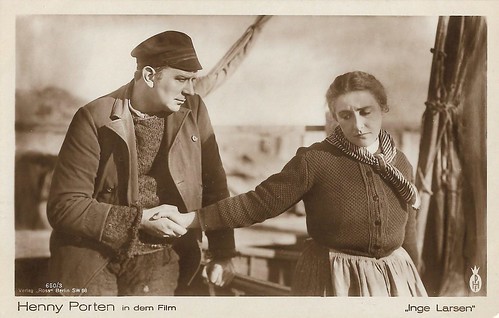
German postcard by Ross Verlag, no. 650/3. Photo: Henny Porten Filmproduktion (HPF). Henny Porten and Paul Hansen in Inge Larsen (Hans Steinhoff, 1924).
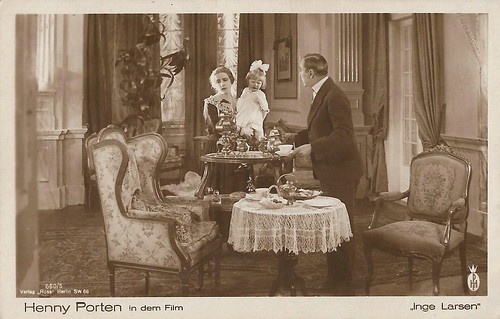
German postcard by Ross Verlag, no. 650/5. Photo: Henny Porten Filmproduktion (HPF). Henny Porten and Paul Otto in Inge Larsen (Hans Steinhoff, 1924).
Die Flammen lügen (1926)
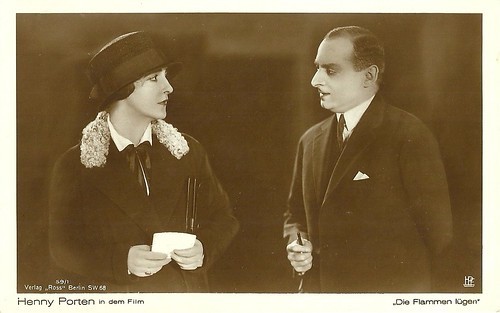
German postcard by Ross Verlag, no. 59/1. Photo: Henny Porten Film. Henny Porten and Ferdinand von Alten in Die Flammen lügen (Carl Froehlich, 1926).

German postcard by Ross Verlag, no. 59/2. Photo: Henny Porten-Froehlich Produktion. Henny Porten in the German silent film Die Flammen lügen (Carl Froehlich, 1926). The men may be Paul Bildt and Gerd Briese as Porten's father and brother in the film.
In Die Flammen lügen/The Flames Lie (Carl Froehlich, 1926), Gertrud von Gehr (Porten) is the daughter of the retired officer Major von Gehr (Paul Bildt). He is annoyed by his neighbor's new house, the wealthy factory owner Conrad Birkinger ( Hans Adalbert Schlettow ). To make matters worse, Gehr's daughter Gertrud falls in love with Birkinger and one day they both get married. The childless marriage is not under a lucky star, because Birkinger cheats on his wife with his former girlfriend Doritt ( Ruth Weyher ). Gertrud's unfaithful husband even goes so far that he and Doritt rent a hotel as Mr. and Mrs. Birkinger.
When a fire breaks out in the hotel, the two can no longer escape and perish in the flames. Now Gertrud Birkinger is officially dead. At first, she does not notice anything of this development because she had stayed in the hotel too, as she had secretly traveled to join her husband. But she could be saved. After a lengthy recovery, Gertrud returns to her old, premarital life and devotes herself entirely to her brother Hermann's children.
Die Flammen lügen was created in April and May 1926 in the Berlin-Staaken studio. The film passed the censorship on 25 September and was banned from youth. The first performance took place on 22 October 1926 in the Berlin cinema Mozartsaal. The length of the six-acter was 2780 meters. Paimann’s film lists summed up: “The subject is kept quite sentimental and has a number of gripping moments, the direction is consistent, the mise-en-scene and photography neat."
Additional actors were Ferdinand von Alten as Birkinger's secretary, Gerd Briese as Gertrud's brother Hermann, Grete Mosheim, and Hubert von Meyerinck. Friedrich Raff did the script, Franz Schroedter was responsible for the film sets, and Axel Graatkjær did the cinematography.
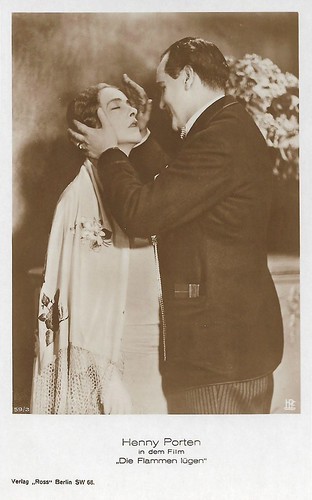
German postcard by Ross Verlag, no. 59/3. Photo: Henny Porten-Froehlich Produktion. Henny Porten and Hans Adalbert Schlettow in Die Flammen lügen (Carl Froehlich, 1926).
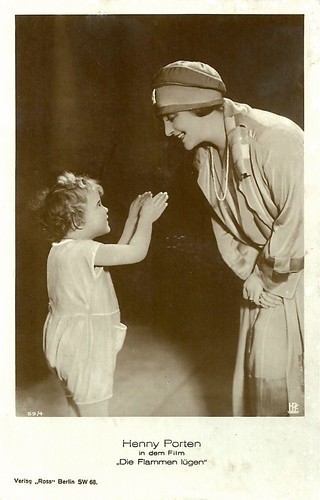
German postcard by Ross Verlag, no. 59/4. Photo: Henny Porten-Froehlich Produktion. Henny Porten in Die Flammen lügen (Carl Froehlich, 1926).
Liebfraumilch (1929)
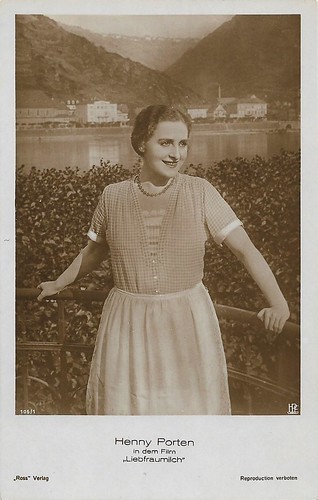
German postcard by Ross Verlag, no. 106/1. Photo: Henny Porten-Froehlich produktion (HPF). Henny Porten in Liebfraumilch/German Wine (Carl Froehlich, 1929).
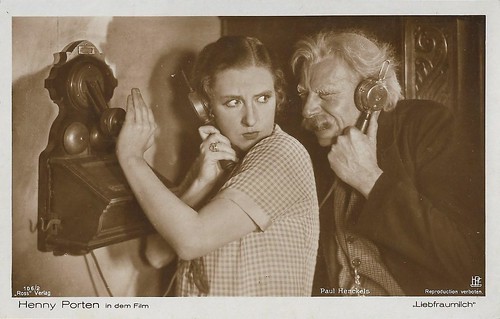
German postcard by Ross Verlag, no. 106/2. Photo: Henny Porten-Froehlich produktion (HPF). Henny Porten and Paul Henckels in Liebfraumilch/German Wine (Carl Froehlich, 1929).
Liebfraumilch/German Wine (Carl Froehlich, 1929) is a German silent film directed by Carl Froelich and starring Livio Pavanelli as wine estate owner Hans Hentschel, Henny Porten as his wife Klara, and Paul Henckels as her grandfather.
The film takes its German title from the sweet white wine Liebfraumilch. The film's sets were designed by Gustav A. Knauer and Willy Schiller. The film was shot on location in Wiesbaden and by the Rhein River (in Bacharach and the surrounding area).
On 19 December 1928, the German censors authorised Liebfraumilch for projection. The premiere of the film took place on 5 February 1929, in Berlin at the Titania-Palast. It was distributed by the German branch of Universal Pictures.
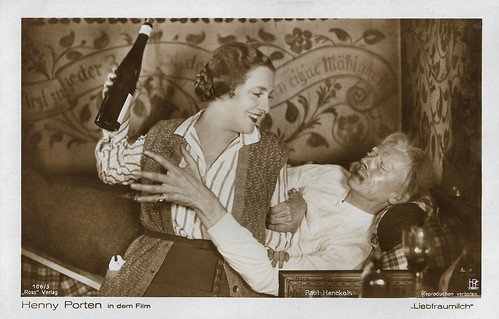
German postcard by Ross Verlag, no. 106/3. Photo: Henny Porten-Froehlich produktion (HPF). Henny Porten and Paul Henckels in Liebfraumilch/German Wine (Carl Froehlich, 1929).
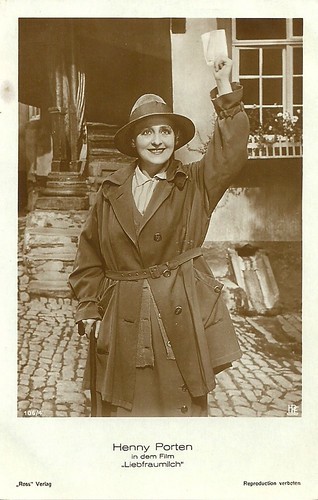
German postcard by Ross Verlag, no. 106/4. Photo: Henny Porten-Froehlich produktion. Henny Porten in Liebfraumilch/German Wine (Carl Froehlich, 1929).
Sources: German Wikipedia, Horst Claus (Bundesarchiv, Filmblatt 6), Filmportal.de, and IMDb.
Inge Larsen (1924)

German postcard by Ross Verlag, no. 650/1. Photo: Henny Porten Filmproduktion (HPF). Henny Porten and Paul Hansen in Inge Larsen (Hans Steinhoff, 1924).

German postcard by Ross Verlag, no. 650/2. Photo: Henny Porten Filmproduktion (HPF). Henny Porten and Paul Hansen in Inge Larsen (Hans Steinhoff, 1924).
Inge Larsen (Hans Steinhoff, 1924) deals with a fisherwoman who by a marriage to a rich diplomat meets a world she doesn't know. Inge Larsen (Porten), the daughter of a fisherman, falls in love with Baron Kerr (Paul Otto), who is recovering in her parents' house after having problems with a storm at sea. Kerr also takes a liking to the young woman and so after a short time, he asks her for her hand. Inge leaves behind her parents and her boyfriend, the fisherman Jan Olsen (Paul Hansen) when she and Kerr begin a new and completely unfamiliar life. By marrying an influential diplomat, she now belongs to the higher social class, which also includes the high nobility. Inge has an opponent in the capricious Evelyne ( Ressel Orla ), with whom Kerr was in a relationship before his marriage.
After the young couple has had a child, it is more important for Inge to be with her child than to take on social responsibilities. Evelyne can now be seen more and more at Kerr's side. Inge, who is straightforward and honest, has little to oppose this woman who is crazy about intrigues. Although it is Kerr who cheats on his wife with Evelyne, he accuses Inge of infidelity. He uses the occasion when he sees Jan Olsen come out of his house. However, Inge only treated his injuries sustained while visiting a nightclub during a fight he got into. Another dramatic incident leads Inge to return to her parents' house after she and her husband have decided to divorce. Nothing stands in the way of happiness with Jan, who suits her much better.
Inge Larsen was scripted by Karl Vollmoeller and Hans Steinhoff. Helmar Lerski did the cinematography, while sets were by Fritz Lück, Alfred Junge, and Ludwig Kainer. The latter also did the costumes. The first outdoor shots were taken on Rügen in the second half of October 1922. This was followed by further shooting in Berlin. At the end of April / beginning of May 1923 further filming took place in Copenhagen because Porten was no longer satisfied with the film. The critic Fritz Olimsky, who noticed at the premiere that the film was not of the usual length, learned when asked that Henny Porten had subsequently removed or severely cut the scenes from the already-completed film in which she herself cannot be seen. Thus, from an ensemble film, “a clichéd star film with finely worked out secondary episodes” emerged, according to Olimsky. The film, forbidden for non-adults, premiered on 22 September 1923 at the Berlin cinema Kammer-Lichtspielen.
For some of the Berlin critics, the film was a vehicle for the star Henny Porten and was “fully geared towards the audience”. It was a "bomb role" for her. The other part was of the opinion that the film was old-fashioned "as it was half a decade ago" and "as it has always been in her famous films". The work of the production designer and the work of the cameraman were assessed as consistently positive. In particular, the opening shots by Lerski reminded me of contemporary Swedish cinema. It is also said that after a few failures with the embodiment of Inge Larsen as the ideal German woman and mother, Henny Porten was returning to a role that her regular audience expects of her.
The disappointment was expressed in view of the "pulp fiction plot", since Karl Vollmoeller was after all considered a "literary screenwriter", who, however, turns out to be a "backward-looking poet and dexterous family novelist". While the weaknesses of the film were blamed on the script and the superiority of Henny Porten , the work of Hans Steinhoff was rated positively. It was said that he “gave the maudlin story an atmospheric setting” and “worked out individual moods very finely”. Steinhoff had shown that “there is a lot of good in him” and that “a lot can still be expected from him”.
The film, long thought to be lost, was discovered in the Moscow film archive Gosfilmofond including the censorship card and extensively restored by the Bundesarchiv-Filmarchiv Berlin and the University of the West of England Bristol as well as with partial support from the UK Arts and Humanities Research Board. The restored version was shown for the first time on 11 September 2007.

German postcard by Ross Verlag, no. 650/3. Photo: Henny Porten Filmproduktion (HPF). Henny Porten and Paul Hansen in Inge Larsen (Hans Steinhoff, 1924).

German postcard by Ross Verlag, no. 650/5. Photo: Henny Porten Filmproduktion (HPF). Henny Porten and Paul Otto in Inge Larsen (Hans Steinhoff, 1924).
Die Flammen lügen (1926)

German postcard by Ross Verlag, no. 59/1. Photo: Henny Porten Film. Henny Porten and Ferdinand von Alten in Die Flammen lügen (Carl Froehlich, 1926).

German postcard by Ross Verlag, no. 59/2. Photo: Henny Porten-Froehlich Produktion. Henny Porten in the German silent film Die Flammen lügen (Carl Froehlich, 1926). The men may be Paul Bildt and Gerd Briese as Porten's father and brother in the film.
In Die Flammen lügen/The Flames Lie (Carl Froehlich, 1926), Gertrud von Gehr (Porten) is the daughter of the retired officer Major von Gehr (Paul Bildt). He is annoyed by his neighbor's new house, the wealthy factory owner Conrad Birkinger ( Hans Adalbert Schlettow ). To make matters worse, Gehr's daughter Gertrud falls in love with Birkinger and one day they both get married. The childless marriage is not under a lucky star, because Birkinger cheats on his wife with his former girlfriend Doritt ( Ruth Weyher ). Gertrud's unfaithful husband even goes so far that he and Doritt rent a hotel as Mr. and Mrs. Birkinger.
When a fire breaks out in the hotel, the two can no longer escape and perish in the flames. Now Gertrud Birkinger is officially dead. At first, she does not notice anything of this development because she had stayed in the hotel too, as she had secretly traveled to join her husband. But she could be saved. After a lengthy recovery, Gertrud returns to her old, premarital life and devotes herself entirely to her brother Hermann's children.
Die Flammen lügen was created in April and May 1926 in the Berlin-Staaken studio. The film passed the censorship on 25 September and was banned from youth. The first performance took place on 22 October 1926 in the Berlin cinema Mozartsaal. The length of the six-acter was 2780 meters. Paimann’s film lists summed up: “The subject is kept quite sentimental and has a number of gripping moments, the direction is consistent, the mise-en-scene and photography neat."
Additional actors were Ferdinand von Alten as Birkinger's secretary, Gerd Briese as Gertrud's brother Hermann, Grete Mosheim, and Hubert von Meyerinck. Friedrich Raff did the script, Franz Schroedter was responsible for the film sets, and Axel Graatkjær did the cinematography.

German postcard by Ross Verlag, no. 59/3. Photo: Henny Porten-Froehlich Produktion. Henny Porten and Hans Adalbert Schlettow in Die Flammen lügen (Carl Froehlich, 1926).

German postcard by Ross Verlag, no. 59/4. Photo: Henny Porten-Froehlich Produktion. Henny Porten in Die Flammen lügen (Carl Froehlich, 1926).
Liebfraumilch (1929)

German postcard by Ross Verlag, no. 106/1. Photo: Henny Porten-Froehlich produktion (HPF). Henny Porten in Liebfraumilch/German Wine (Carl Froehlich, 1929).

German postcard by Ross Verlag, no. 106/2. Photo: Henny Porten-Froehlich produktion (HPF). Henny Porten and Paul Henckels in Liebfraumilch/German Wine (Carl Froehlich, 1929).
Liebfraumilch/German Wine (Carl Froehlich, 1929) is a German silent film directed by Carl Froelich and starring Livio Pavanelli as wine estate owner Hans Hentschel, Henny Porten as his wife Klara, and Paul Henckels as her grandfather.
The film takes its German title from the sweet white wine Liebfraumilch. The film's sets were designed by Gustav A. Knauer and Willy Schiller. The film was shot on location in Wiesbaden and by the Rhein River (in Bacharach and the surrounding area).
On 19 December 1928, the German censors authorised Liebfraumilch for projection. The premiere of the film took place on 5 February 1929, in Berlin at the Titania-Palast. It was distributed by the German branch of Universal Pictures.

German postcard by Ross Verlag, no. 106/3. Photo: Henny Porten-Froehlich produktion (HPF). Henny Porten and Paul Henckels in Liebfraumilch/German Wine (Carl Froehlich, 1929).

German postcard by Ross Verlag, no. 106/4. Photo: Henny Porten-Froehlich produktion. Henny Porten in Liebfraumilch/German Wine (Carl Froehlich, 1929).
Sources: German Wikipedia, Horst Claus (Bundesarchiv, Filmblatt 6), Filmportal.de, and IMDb.
Published on February 12, 2021 22:00
February 11, 2021
Daredevil (2003)
Daredevil is a fictional superhero appearing in American comic books published by Marvel Comics. Daredevil was created by writer-editor Stan Lee and artist Bill Everett, with an unspecified amount of input from Jack Kirby. The character first appeared in 'Daredevil #1' (April 1964). Writer/artist Frank Miller's influential tenure on the title in the early 1980s cemented the character as a popular and influential part of the Marvel Universe. Daredevil is commonly known by such epithets as the 'Man Without Fear' and the 'Devil of Hell's Kitchen'. Ben Affleck portrayed the superhero in the film Daredevil (Mark Steven Johnson, 2003).
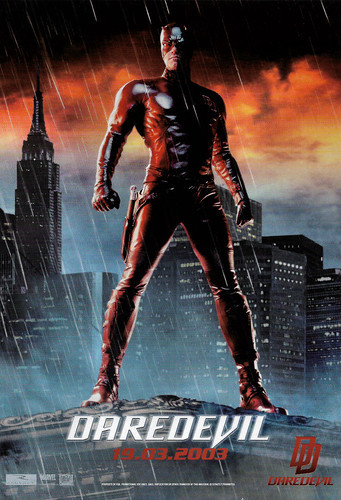
Belgian postcard by Boomerang Free Cards, no. 1/4. Image: Marvel / Regency / 20th Century Fox. Ben Affleck in Daredevil (Mark Steven Johnson, 2003).
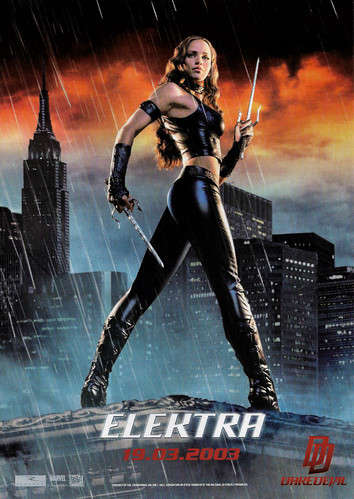
Belgian postcard by Boomerang Free Cards, no. 2/4. Image: Marvel / Regency / 20th Century Fox. Jennifer Garner in Daredevil (Mark Steven Johnson, 2003).
Hell's Kitchen in New York City
Daredevil's origins stem from a childhood accident that gave him special abilities. While growing up in the historically gritty or crime-ridden working-class Irish-American neighbourhood of Hell's Kitchen in New York City, Matt Murdock is blinded by a radioactive substance that falls from an out-of-control truck after he pushes a man out of the path of the oncoming vehicle.
While he can no longer see, his exposure to the radioactive material heightens his remaining senses beyond normal human ability, and gives him a 'radar sense'. His father, a boxer named Jack Murdock, is a single man raising his now blind son, who despite his rough upbringing, unconditionally loves his son and tries to teach him to form a better life for himself.
Jack is later killed by gangsters after refusing to throw a fight, leaving Matt an orphan. In order to protect himself, Matt began training to hone his physical abilities and superhuman senses under the tutelage of a mysterious blind stranger named Stick, eventually becoming a highly skilled and expert martial artist.
Some years later, after graduating from law school with high grades, Matt seeks out the criminal element in Hell's Kitchen and starts his crime-fighting activities. Matt targets the local gangsters who murdered his father and succeeds in bringing them to justice.
Eventually, donning a costumed attire modeled after a devil, Matt took up a dual life of fighting against the criminal underworld in New York City as the masked vigilante Daredevil, which put him in conflict with many super-villains, including his arch-enemies Bullseye and the Kingpin. He also becomes a skilled and respected lawyer after graduating from Columbia Law School with his best friend and roommate, Franklin 'Foggy' Nelson, with whom he becomes law partners, forming the law firm Nelson & Murdock.
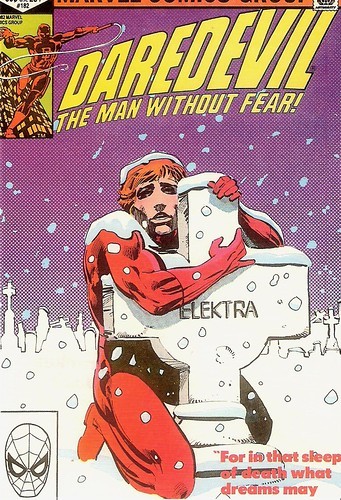
American postcard by Chronicle Books from 'The Art of Vintage Marvel: 100 Collectible Postcards'. Image: Marvel Comics Group, 2007. It's a detail of the cover of Daredevil #182 "She's Alive" (1982) by Frank Miller. Caption: Daredevil, The Man Without fear. 100 classic comic book covers from the 1960s to the 1980s. Featuring everyone's favorite superheroes, from Silver Surfer, the Hulk, and Spider-Man to the Fantastic Four, Captain America, and X-Men.
An R-rated director's cut
Daredevil has since appeared in various forms of media, including several animated series, video games, and merchandise. The character was first portrayed in live-action by Rex Smith in the 1989 television movie The Trial of the Incredible Hulk.
Then Ben Affleck portrayed the superhero in the film Daredevil (Mark Steven Johnson, 2003). Jennifer Garner plays his love interest Elektra Natchios; Colin Farrell plays the merciless assassin Bullseye; David Keith plays Jack 'The Devil' Murdock, a washed-up fighter and Matt's father; and Michael Clarke Duncan plays Wilson Fisk, also known as the crime lord Kingpin.
Johnson shot the film primarily in Downtown Los Angeles despite the Hell's Kitchen, Manhattan setting of the film and comics. Rhythm and Hues Studios were hired to handle the film's CGI. Graeme Revell composed the Daredevil score, which was released on CD in March 2003, whereas the various artists' soundtrack album, 'Daredevil: The Album', was released in February.
Daredevil was released on 14 February 2003. It received generally mixed reviews from critics with many praising the action sequences, acting performances, soundtrack, storyline, visual style, and stunts, while others criticised Affleck's performance and its perceived lack of ambition. Nevertheless, the film became the second-biggest February release to that time and grossed over $179 million against a production budget of $78 million.
In 2004, an R-rated director's cut of Daredevil was released, reincorporating approximately 30 minutes of the film, and received significantly more acclaim from critics than the theatrical version. In 2015, Daredevil was portrayed by Charlie Cox in the Marvel Television productions Daredevil and The Defenders, created by Drew Goddard, on Netflix.
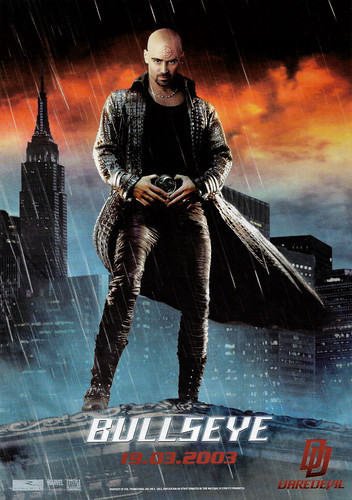
Belgian postcard by Boomerang Free Cards, no. 3/4. Image: Marvel / Regency / 20th Century Fox. Colin Farrell in Daredevil (Mark Steven Johnson, 2003).
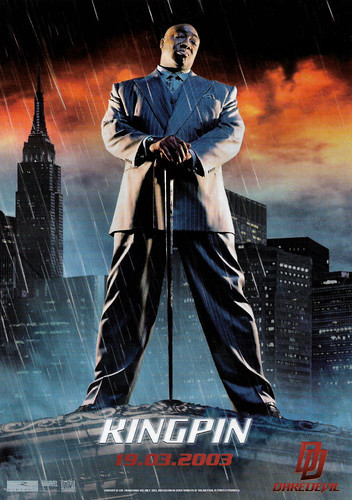
Belgian postcard by Boomerang Free Cards, no. 4/4. Image: Marvel / Regency / 20th Century Fox. Michael Clarke Duncan in Daredevil (Mark Steven Johnson, 2003).
Sources: Man Without Fear, Wikipedia, and IMDb.

Belgian postcard by Boomerang Free Cards, no. 1/4. Image: Marvel / Regency / 20th Century Fox. Ben Affleck in Daredevil (Mark Steven Johnson, 2003).

Belgian postcard by Boomerang Free Cards, no. 2/4. Image: Marvel / Regency / 20th Century Fox. Jennifer Garner in Daredevil (Mark Steven Johnson, 2003).
Hell's Kitchen in New York City
Daredevil's origins stem from a childhood accident that gave him special abilities. While growing up in the historically gritty or crime-ridden working-class Irish-American neighbourhood of Hell's Kitchen in New York City, Matt Murdock is blinded by a radioactive substance that falls from an out-of-control truck after he pushes a man out of the path of the oncoming vehicle.
While he can no longer see, his exposure to the radioactive material heightens his remaining senses beyond normal human ability, and gives him a 'radar sense'. His father, a boxer named Jack Murdock, is a single man raising his now blind son, who despite his rough upbringing, unconditionally loves his son and tries to teach him to form a better life for himself.
Jack is later killed by gangsters after refusing to throw a fight, leaving Matt an orphan. In order to protect himself, Matt began training to hone his physical abilities and superhuman senses under the tutelage of a mysterious blind stranger named Stick, eventually becoming a highly skilled and expert martial artist.
Some years later, after graduating from law school with high grades, Matt seeks out the criminal element in Hell's Kitchen and starts his crime-fighting activities. Matt targets the local gangsters who murdered his father and succeeds in bringing them to justice.
Eventually, donning a costumed attire modeled after a devil, Matt took up a dual life of fighting against the criminal underworld in New York City as the masked vigilante Daredevil, which put him in conflict with many super-villains, including his arch-enemies Bullseye and the Kingpin. He also becomes a skilled and respected lawyer after graduating from Columbia Law School with his best friend and roommate, Franklin 'Foggy' Nelson, with whom he becomes law partners, forming the law firm Nelson & Murdock.

American postcard by Chronicle Books from 'The Art of Vintage Marvel: 100 Collectible Postcards'. Image: Marvel Comics Group, 2007. It's a detail of the cover of Daredevil #182 "She's Alive" (1982) by Frank Miller. Caption: Daredevil, The Man Without fear. 100 classic comic book covers from the 1960s to the 1980s. Featuring everyone's favorite superheroes, from Silver Surfer, the Hulk, and Spider-Man to the Fantastic Four, Captain America, and X-Men.
An R-rated director's cut
Daredevil has since appeared in various forms of media, including several animated series, video games, and merchandise. The character was first portrayed in live-action by Rex Smith in the 1989 television movie The Trial of the Incredible Hulk.
Then Ben Affleck portrayed the superhero in the film Daredevil (Mark Steven Johnson, 2003). Jennifer Garner plays his love interest Elektra Natchios; Colin Farrell plays the merciless assassin Bullseye; David Keith plays Jack 'The Devil' Murdock, a washed-up fighter and Matt's father; and Michael Clarke Duncan plays Wilson Fisk, also known as the crime lord Kingpin.
Johnson shot the film primarily in Downtown Los Angeles despite the Hell's Kitchen, Manhattan setting of the film and comics. Rhythm and Hues Studios were hired to handle the film's CGI. Graeme Revell composed the Daredevil score, which was released on CD in March 2003, whereas the various artists' soundtrack album, 'Daredevil: The Album', was released in February.
Daredevil was released on 14 February 2003. It received generally mixed reviews from critics with many praising the action sequences, acting performances, soundtrack, storyline, visual style, and stunts, while others criticised Affleck's performance and its perceived lack of ambition. Nevertheless, the film became the second-biggest February release to that time and grossed over $179 million against a production budget of $78 million.
In 2004, an R-rated director's cut of Daredevil was released, reincorporating approximately 30 minutes of the film, and received significantly more acclaim from critics than the theatrical version. In 2015, Daredevil was portrayed by Charlie Cox in the Marvel Television productions Daredevil and The Defenders, created by Drew Goddard, on Netflix.

Belgian postcard by Boomerang Free Cards, no. 3/4. Image: Marvel / Regency / 20th Century Fox. Colin Farrell in Daredevil (Mark Steven Johnson, 2003).

Belgian postcard by Boomerang Free Cards, no. 4/4. Image: Marvel / Regency / 20th Century Fox. Michael Clarke Duncan in Daredevil (Mark Steven Johnson, 2003).
Sources: Man Without Fear, Wikipedia, and IMDb.
Published on February 11, 2021 22:00
Paul van Yperen's Blog
- Paul van Yperen's profile
- 13 followers
Paul van Yperen isn't a Goodreads Author
(yet),
but they
do have a blog,
so here are some recent posts imported from
their feed.



